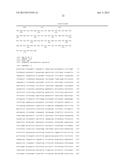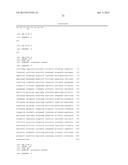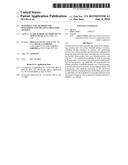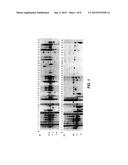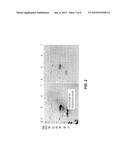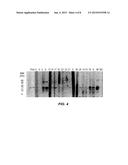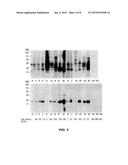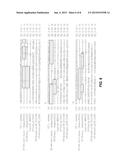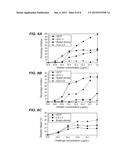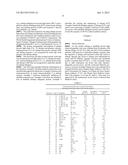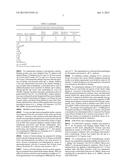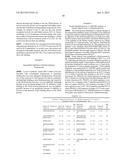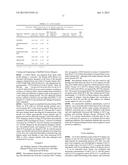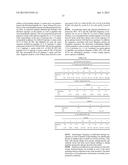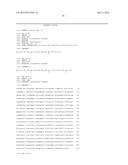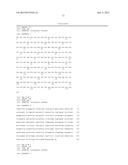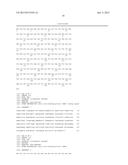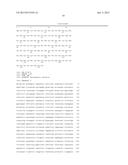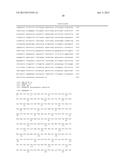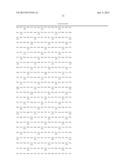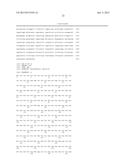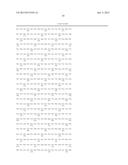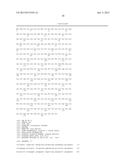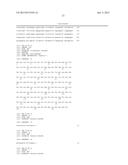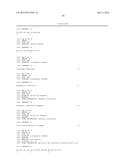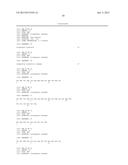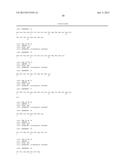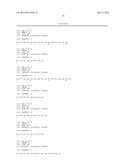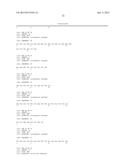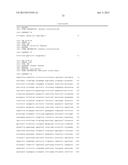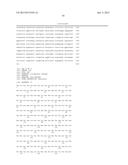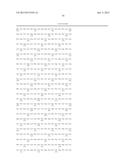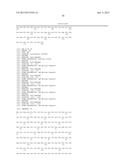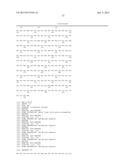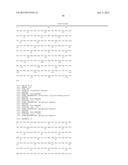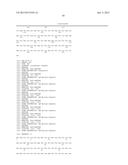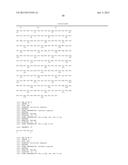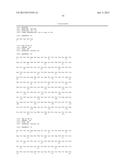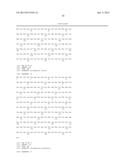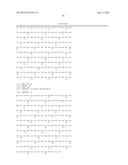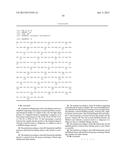Patent application title: MATERIALS AND METHODS FOR DIAGNOSING AND TREATING SHELLFISH ALLERGY
Inventors:
Rosalia Ayuso (New York, NY, US)
Hugh A. Sampson (Larchmont, NY, US)
Galina Grishina (New York, NY, US)
IPC8 Class: AG01N3368FI
USPC Class:
Class name:
Publication date: 2015-06-04
Patent application number: 20150153358
Abstract:
The disclosure provides materials and methods for diagnosing, treating
and preventing shellfish allergic reactions, including allergic reactions
to shrimp. The technology involves one or more shellfish-specific
proteins selected from the group of myosin light chain, sarcoplasmic
calcium-binding protein, hemocyanin, fatty acid binding protein, and
troponin C, for example from shrimp, as well as encoding polynucleotides,
vectors host cells, and specific binding partners for such proteins,
e.g., antibodies. In compositions comprising a plurality of shellfish
allergens, any of the aforementioned proteins may be included, as may
arginine kinase and tropomyosin. The methods according to the disclosure
include methods of making the specific binding partners such as
antibodies as well as methods of using the materials of the disclosure to
diagnose, treat or prevent an allergic reaction to shellfish, e.g.,
shrimp.Claims:
1-20. (canceled)
21. A method of diagnosing a risk of an allergic reaction to shellfish comprising contacting an immunoglobulin-containing biological sample of a subject with a myosin light chain protein or a fragment thereof comprising a sequence of at least amino acid positions 13-30, 22-48, 49-66, 58-90, 79-99, or 118-141 of SEQ ID NO: 59 and measuring a reaction between the sample and the protein or the fragment thereof, wherein a reaction leads to a diagnosis of a subject at risk of a shellfish allergic reaction.
22. The method according to claim 21 wherein the shellfish protein is derived from shrimp, prawn, crab, lobster or crawfish.
23. The method according to claim 22 wherein the shellfish protein is selected from the group consisting of black tiger shrimp and white shrimp.
24. The method according to claim 21 further comprising contacting the biological sample with a second shellfish protein selected from the group consisting of myosin light chain, sarcoplasmic calcium-binding protein, tropomyosin, arginine kinase, hemocyanin, fatty acid binding protein and troponin C and measuring a reaction between the sample and the protein, wherein the first and second shellfish proteins are different and wherein a reaction leads to a diagnosis of a subject at risk of a shellfish allergic reaction.
25. The method according to claim 24 wherein the second shellfish protein is derived from shrimp, prawn, crab, lobster or crawfish.
26. The method according to claim 25 wherein the second shellfish protein is selected from the group consisting of black tiger shrimp and white shrimp.
27-58. (canceled)
Description:
RELATED APPLICATIONS
[0001] This application is a continuation of U.S. patent application Ser. No. 13/387,894, filed May 14, 2012, which is a U.S. National Phase of International Application No. PCT/US2010/044084, filed Aug. 2, 2010, which claims the benefit of priority of U.S. Provisional Patent Application Ser. No. 61/230,482, filed Jul. 31, 2009, which is incorporated herein by reference in its entirety.
FIELD OF INVENTION
[0002] The present invention relates to materials and methods for diagnosing, preventing or treating allergic reactions to shellfish and, in particular, to allergic reactions to shrimp.
BACKGROUND
[0003] Allergic reactions to shellfish, e.g., shrimp, range from mild to systemic reactions, including severe anaphylactic reactions. Beyond allergic reactions to consumption of recognizable shellfish, shellfish products can make their way into a variety of foodstuffs that effectively mask the dangers. As the number of people worldwide exhibiting symptoms of shellfish allergy remains at significant levels, the problem of allergic reactions to shellfish continues to pose a significant health problem.
[0004] Shellfish allergy is a long-lasting and potentially life-threatening disorder. Most shellfish species provoking allergic reactions belong to the class Crustacea, which includes shrimp, prawn, crab, lobster, and crawfish. A recent survey found that one in fifty Americans had shellfish allergy. Shellfish are the number one cause of food allergy in adults in the United States and are responsible for the majority of emergency department visits for food allergy, not only in adults but also in children 6 years of age and older, and a significant cause of allergic reactions in children one to five years old.
[0005] A large variety of crustaceans are consumed by humans. Although the black tiger shrimp (Penaeus monodon) is the most widely cultured prawn species in the world, the Pacific white shrimp (Litopenaeus vannamei), which is actually a prawn, is the species of choice in the shrimp farming industry in the Western hemisphere. Together these two species account for 80% of all farmed shrimp. Shrimp consumption has more than tripled since 1970, and it is expected that allergy to shellfish will continue to increase. Therefore, a better understanding is needed of shrimp proteins involved in the development of allergic reactions.
[0006] Until recently, the muscle protein tropomyosin was the only major cross-reactive allergen identified in different shrimp species. Shrimp tropomyosin has been shown to inhibit 80% of patients' IgE RAST (radioallergosorbent) reactivity to whole-body shrimp extract, indicating that tropomyosin is responsible for most of the allergenic activity of shrimp.
[0007] In spite of the high prevalence of shellfish allergy, few options are available for treatment, and avoidance is the only therapy recommended. However, the frequency and severity of reactions after accidental exposure to shellfish make it necessary to develop improved diagnostic and therapeutic options for shellfish allergy.
[0008] Thus, there remains a need in the art to provide materials and methods to diagnose, treat and/or prevent allergic reactions to shellfish such as shrimp.
SUMMARY
[0009] The technology disclosed herein satisfies at least one of the aforementioned needs in the art in providing shellfish (e.g., shrimp) allergens as well as specific binding partners of such allergens, e.g., antibodies, and methods for generating such specific binding partners, methods of diagnosing the potential for an allergic reaction, methods for treating an allergic reaction, and methods for preventing an allergic reaction, such as by subjecting an individual at risk of an allergic reaction to vaccinating levels of at least one of the allergens.
[0010] In one aspect, the disclosure provides a method of treating a shellfish allergic reaction comprising administering a therapeutically effective amount of a specific binding partner of a shellfish protein selected from the group consisting of myosin light chain, sarcoplasmic calcium-binding protein, fatty acid binding protein (FABP), hemocyanin and troponin C. In some embodiments, the shellfish protein is derived from shrimp, prawn, crab, lobster or crawfish. In embodiments in which the shellfish protein is derived from a shrimp, any shrimp source may be used, such as a shrimp selected from the group consisting of black tiger shrimp and white shrimp. This aspect of the disclosure comprehends embodiments in which the specific binding partner is an antibody, such as a monoclonal antibody, or antibody fragment.
[0011] A related aspect according to the disclosure provides a method as described above further comprising administering a therapeutically effective amount of a second binding partner specifically recognizing a second shellfish protein selected from the group consisting of myosin light chain, sarcoplasmic calcium binding protein, tropomyosin, arginine kinase, hemocyanin, fatty acid binding protein and troponin C, wherein the first and second shellfish proteins are different. In some embodiments, the second shellfish protein is derived from shrimp, prawn, crab, lobster or crawfish. In embodiments in which the second shellfish protein is derived from a shrimp, any shrimp source may be used, such as a shrimp selected from the group consisting of black tiger shrimp and white shrimp. In some embodiments of the method, the specific binding partner is an antibody, such as a monoclonal antibody, or antibody fragment.
[0012] Another aspect according to the disclosure is a method of ameliorating or preventing a shellfish allergic reaction comprising administering a therapeutically effective amount of a protein selected from the group consisting of shellfish myosin light chain, shellfish sarcoplasmic calcium-binding protein, fatty acid binding protein (FABP), hemocyanin, troponin C and a specific binding partner thereof. In some embodiments, the shellfish protein is derived from shrimp, prawn, crab, lobster or crawfish. In embodiments in which the shellfish protein is derived from a shrimp, any shrimp source may be used, such as a shrimp selected from the group consisting of black tiger shrimp and white shrimp. In some embodiments, the specific binding partner is an antibody, such as a monoclonal antibody, or antibody fragment.
[0013] In a related aspect, the disclosure provides a method as described immediately above, further comprising administering a therapeutically effective amount of a second protein selected from the group consisting of shellfish myosin light chain, shellfish sarcoplasmic calcium-binding protein, shellfish tropomyosin, shellfish arginine kinase, shellfish hemocyanin, shellfish fatty acid binding protein, shellfish troponin C and a specific binding partner thereof, wherein the first and second proteins are different. In some embodiments, the second shellfish protein is derived from shrimp, prawn, crab, lobster or crawfish. In embodiments in which the second shellfish protein is derived from a shrimp, any shrimp source may be used, such as a shrimp selected from the group consisting of black tiger shrimp and white shrimp. In some embodiments, the specific binding partner is an antibody, such as a monoclonal antibody, or antibody fragment.
[0014] Yet another aspect according to the disclosure provides a method of diagnosing a risk of an allergic reaction to shellfish comprising contacting an immunoglobulin-containing biological sample of a subject with a shellfish protein selected from the group consisting of myosin light chain, sarcoplasmic calcium binding protein, hemocyanin, fatty acid binding protein and troponin C, and measuring a reaction between the sample and the protein, wherein a reaction leads to a diagnosis of a subject at risk of a shellfish allergic reaction. In some embodiments, the shellfish protein is derived from shrimp, prawn, crab, lobster or crawfish. In embodiments in which the shellfish protein is derived from a shrimp, any shrimp source may be used, such as a shrimp selected from the group consisting of black tiger shrimp and white shrimp.
[0015] In a related aspect, the disclosure provides a method of diagnosis as described immediately above, further comprising contacting the biological sample with a second shellfish protein selected from the group consisting of myosin light chain, sarcoplasmic calcium binding protein, tropomyosin, arginine kinase, hemocyanin, fatty acid binding protein and troponin C, wherein the first and second shellfish proteins are not the same protein. In some embodiments, the second shellfish protein is derived from shrimp, prawn, crab, lobster or crawfish. In embodiments in which the second shellfish protein is derived from a shrimp, any shrimp source may be used, such as a shrimp selected from the group consisting of black tiger shrimp and white shrimp.
[0016] In a further aspect, the disclosure provides methods of treating, ameliorating or preventing a shellfish allergic reaction comprising administering a therapeutically effective amount of a protein selected from the group consisting of shellfish myosin light chain, shellfish sarcoplasmic calcium-binding protein, shellfish fatty acid binding protein, shellfish hemocyanin, shellfish troponin C and a monoclonal antibody or fragment thereof. In more particular aspects, the monoclonal antibody or fragment thereof binds to an epitope comprising an amino acid at any one of amino acid positions 1-18, 25-42, 64-96, 121-141, 142-159, 160-192, 232-255, or 319-342 in the amino acid sequence of SEQ ID NO: 58; an amino acid at any one of amino acid positions 13-30, 22-48, 49-66, 58-90, 79-99, or 118-141 in the amino acid sequence of SEQ ID NO: 59; an amino acid at any one of amino acid positions 10-36, 49-72, or 130-147 in the amino acid sequence of SEQ ID NO: 60; or an amino acid at any one of amino acid positions 1-36, 37-63, 61-81, 82-105, 115-150, 142-162, 157-183, 190-210, or 246-284 in the amino acid sequence of SEQ ID NO: 61. In certain aspects, the monoclonal antibody is a recombinant antibody. In further aspects, the recombinant antibody is selected from the group consisting of a human chimeric antibody, a humanized antibody, and a human antibody.
[0017] The invention includes uses of compositions of the invention, including binding partners, antibodies and fragments thereof, and proteins, for the preparation of medicaments. Other related aspects are also provided in the instant invention.
[0018] The foregoing summary is not intended to define every aspect of the invention, and additional aspects are described in other sections, such as the following detailed description. The entire document is intended to be related as a unified disclosure, and it should be understood that all combinations of features described herein are contemplated, even if the combination of features are not found together in the same sentence, or paragraph, or section of this document. Other features and advantages of the invention will become apparent from the following detailed description. It should be understood, however, that the detailed description and the specific examples, while indicating specific embodiments of the invention, are given by way of illustration only, because various changes and modifications within the spirit and scope of the invention will become apparent to those skilled in the art from this detailed description.
BRIEF DESCRIPTION OF THE DRAWING
[0019] FIG. 1 shows IgE immunoblotting of 38 patients' sera to boiled (BS, top) and raw (RS, bottom) shrimp extract. M, molecular weight; P, total shrimp protein; lanes 1 to 38, immunolabeling with patients' sera; NC, negative control. IgE reactivity to tropomyosin is represented at 34 kd and IgE reactivity to MLC is represented at 20 kd.
[0020] FIG. 2 provides a 2-D proteomics map and immunolabeling of boiled shrimp extract. Left, Gel stained for total protein analysis; right, IgE immunolabeling with one representative subject. The circle shows the spot used for MALDI/MS analysis. The square shows two amino acid sequences obtained by means of Edman sequencing, i.e., KGGXNVFDMFTQK (SEQ ID NO:1) and SSGESDDDDVVAASIR (SEQ ID NO:2). MW, Molecular weight; pl, isoelectric point.
[0021] FIG. 3 discloses immunoblot inhibition of IgE reactivity to boiled shrimp extract with recombinant tropomyosin. M, molecular weight; P, protein staining of boiled shrimp extract; lane 3, IgE immunoblotting with a serum pool; lane 4, pool preincubated with recombinant tropomyosin (Inh Tp); and lane 5, pool preincubated with chickpea extract as a control (Inh C).
[0022] FIG. 4 shows IgE binding to recombinant shrimp MLC. Numbered lanes, immunoblotting with patients' sera. NC, negative control; Prot, amido black staining of recombinant MLC (arrow).
[0023] FIG. 5 shows an IgE immunoblot of a representative group of 14 patients to BS (boiled shrimp) extract (A) and recombinant sarcoplasmic calcium-binding protein (rSCP) (B). P, protein staining of total shrimp protein (A), rSCP (B). Lanes, Immunolabeling with 14 patients' sera; NC, negative controls (two used in A, three in B). The sera of patients 2 and 43 were used for ELISA experiments described herein; sera of patients 14, 47 and 48 were used in RBL assays, also described herein. Levels of shrimp-specific IgE are noted in kUA/L.
[0024] FIG. 6 provides a multiple sequence alignment of protein sequences of SCPs. Sequence identities of Lit v 4.0101 with Penaeus spp α chain (P02636; 93.8%), β chain (P02635, 80%), crayfish SCP (P. leptodactylus; ABB58783, P05946; 81% to 82%), scallop (M. yessoensis), SCP (P02637; 14%), and fruit fly SCP (D. melanogaster, NP--001015389 and NP--524381; 18% to 52%). Identical amino acids to L. vannamei SCP are replaced by dashes. Boxed peptide regions of SCP α-B and A chains--Penaeus--P02636 were identified by MS/MS as matching the amino acid sequence of SCP α chain; boxed peptide regions of SCP β chain--Penaeus--P02635 were identified by MS/MS as matching the amino acid sequence of SCP β chain.
[0025] FIG. 7 discloses immunoblot inhibition of IgE reactivity to rSCP with extracts from other arthropods and mollusks. P, Protein staining of rSCP. Lane 1, pool without inhibitor. Lanes 2-9, pool preincubated with extract of D. farinae (2), B. germanica (3), boiled lobster (4), crab (5), squid (6), scallop (7), mussel (8), shrimp (9), and chickpea (10) as negative control.
[0026] FIGS. 8A-C provide graphs showing ELISA inhibition and mediator release from an RBL cell line. ELISA inhibition of BS with serum from subject 2 (FIG. 8A) and subject 43 (FIG. 8B). Inhibitors: rSCP, rLit v 1, BS, and rCor a 9. Inhibitor concentrations ranged from 25×10-8 μg/ml (shown as 10-8) to 25 μg/ml total protein. β-hexosaminidase release from RBL cells induced by rSCP, rLit v 1, and BS (maximal concentration, 1 μg/ml) is expressed as a percentage of total possible release induced by Triton X-100. Cells were sensitized with serum pool of subjects 14, 47 and 48 (FIG. 8C).
DETAILED DESCRIPTION
[0027] Allergic reactions to shellfish (e.g., shrimp) range from mild to systemic reactions, including severe anaphylactic reactions. In accordance with the disclosure, several shellfish allergens have been identified that can be utilized in the diagnosis and treatment of patients with shellfish (e.g., shrimp) allergy. In addition to the identification of sarcoplasmic calcium-binding protein as a shellfish (e.g., shrimp) allergen, Myosin light chain (MLC) is identified as a new major allergenic shrimp protein, particularly in children. Initial studies revealed that IgE recognition of MLC in boiled shrimp (BS) extract was very intense, but the recombinant MLC protein was significantly less recognized. Although this may be a result of posttranslational modifications present in the native form, the possibility of another IgE-binding protein of similar molecular weight was considered. With additional investigation, the proteins identified as shellfish (e.g., shrimp) allergens are myosin light chain (MLC; SEQ ID NO:59), sarcoplasmic calcium-binding protein (SCP; SEQ ID NO:60), hemocyanin (SEQ ID NOs:56 and 57), fatty acid binding protein (FABP; SEQ ID NOs:7 and 8) and troponin C (SEQ ID NOs:17 and 18). The World Health Organization/International Union of Immunological Societies Allergen Nomenclature Subcommittee has designated shrimp tropomyosin as Lit v 1, shrimp arginine kinase as Lit v 2, shrimp MLC as Lit v 3 and shrimp SCP as Lit v 4. The proteins, polypeptides and peptides of Lit v 3 (shrimp myosin light chain), Lit v 4 (shrimp sarcoplasmic calcium-binding protein), shrimp hemocyanin, shrimp FABP and shrimp troponin C are recognized by serum Immunoglobulin E (IgE) from patients with shrimp allergy.
[0028] The disclosure provides proteins, polypeptides and peptides comprising at least one epitope of MLC, SCP, FABP, hemocyanin or troponin C. Isolated and purified proteins, polypeptides and peptides may be made by introducing a nucleic acid encoding the protein, polypeptide or peptide into a suitable host cell, for example by transformation, transfection or injection, culturing the host cell under conditions suitable for expression, and recovering the recombinant polypeptide or peptide. The recombinant product may be recovered from cells or culture medium by methods known in the art. The polypeptides and peptides may also be made by well known methods of protein synthesis, such as solid-phase peptide synthesis.
[0029] Biologically active analogs of the polypeptides and peptides are similarly made utilizing a nucleic acid encoding a biologically active analog. A biologically active analog is one which maintains the ability to be recognized by serum from patients having a shellfish allergy. The term "analogs" includes substitutions and alterations of the amino acid sequences described herein, provided that the substitutions and alterations do not eliminate biological activity. Amino acid insertional derivatives include amino- and carboxy-terminal fusions and single or multiple intra-sequence insertions. Deletional variants have one or more amino acids removed from the protein, polypeptide or peptide. In substitutional amino acid variants, at least one residue has been replaced by a different residue. Biologically active analogs may be made by recombinant methods, e.g., as described in Sambrook et al. or by peptide synthetic techniques well-known in the art, such as solid-phase peptide synthesis. Fusion proteins comprising the polypeptides and peptides of the disclosure are also provided. The protein, polypeptide or peptide may be fused, for example, to P-galactosidase or glutathione-S-transferase, or to any other protein, e.g., to facilitate processing, purification or immobilization.
[0030] The disclosure also provides isolated nucleic acids encoding the allergenic proteins, polypeptides and peptides described herein, i.e., nucleic acids that encode Lit v 3 (shrimp myosin light chain), Lit v 4 (shrimp sarcoplasmic calcium-binding protein), shrimp hemocyanin, and/or shrimp FABP, each of which is recognized by an antibody specific for a shrimp allergen. Exemplary polynucleotide coding sequences and the protein gene product sequences encoded thereby are provided for shrimp myosin light chain (Genbank Acc. No. EU449515; SEQ ID NOs:3 and 4), sarcoplasmic calcium binding protein (Genbank Acc. No. FJ184279; SEQ ID NOs:5 and 6), FABP (Genbank Acc. No. DQ459988; SEQ ID NOs:7 and 8), hemocyanin subunit L (Genbank Acc. No. EF375711; SEQ ID NOs:9 and 10), hemocyanin (SEQ ID NOS:56 and 57), including hemocyanin subunit Y (Genbank Acc. No. EF375712; SEQ ID NOs:11 and 12), tropomyosin (Genbank Acc. No. EU410072; SEQ ID NOs:15 and 16), and troponin C (Genbank Acc. No. BC071546; SEQ ID NOs:17 and 18).
[0031] The disclosure provides isolated nucleic acids that encode a protein, polypeptide or peptide comprising at least one epitope. IgE epitopes of each of the above allergens may be identified by providing a shrimp allergen epitope library and screening the library against serum from allergic patients. Methods for creating and screening epitope libraries are known in the art and are disclosed, for example, by Scott et al., Science 249: 386 (1990). Epitopes may also be identified by computer algorithms using conventional software programs known in the art and overlapping peptide synthesis technology, e.g., Spot Membranes (Genosys Technologies, Woodlands, Tex.) or microarray technology OPT peptides, Berlin, Germany), or by homology to IgE-binding epitopes of other arthropods. Identification of conserved residues with epitopes from other arthropods also allows a determination of residues that cannot be substituted, as well as revealing residues that can be substituted. Accordingly, variants of the above allergens and other epitopes that maintain IgE-binding ability are also included within the disclosure.
[0032] The disclosure further provides a vector comprising an isolated nucleic acid according to the disclosure, a host cell comprising a vector, and a protein, polypeptide or peptides encoded by a nucleic acid. The vectors are useful for the expression of the nucleic acids of the invention.
[0033] The vectors of the disclosure comprise the allergen-encoding nucleic acid operably linked to suitable transcriptional and/or translational regulatory elements to effect expression in a suitable host cell. The regulatory elements may be derived from mammalian, microbial, viral or insect genes, and include, for example, promoters, enhancers, transcription and translation initiation sequences, termination sequences, origins of replication, and sequences encoding leader and transport sequences. Suitable regulatory elements are selected for optimal expression in a desired host cell. Useful expression vectors can be constructed by methods known to one of ordinary skill in the art, and are also commercially available. Exemplary recombinant viral vectors, include retrovirus, parvovirus, densovirus and baculovirus vectors.
[0034] In some embodiments, the expression vector comprises a strong constitutive or inducible promoter operatively linked to a nucleic acid of the disclosure. Suitable promoters are well known and readily available to one of ordinary skill in the art and include, for example, bacterial, yeast, viral, mammalian, and insect promoters. Exemplary expression vectors are vectors compatible with mammalian cells.
[0035] The disclosure provides host cells comprising a vector or an isolated nucleic acid as disclosed herein. Host cells comprising the vector or isolated nucleic acid are useful for replicating the vector and expressing at least the nucleic acid encoding an allergenic protein, polypeptide or peptide, or replicating and expressing the isolated nucleic acid. The host cell may be prokaryotic or eukaryotic, including bacterial, yeast, insect or mammalian cells. Exemplary host cells include insect and mammalian cells. The isolated nucleic acids or vectors, e.g., expression vectors, may be introduced into the host cells by methods known to one of ordinary skill in the art, including transformation, transfection and infection. For example, transfection may be accomplished by any known method, such as liposome-mediated transfection, calcium phosphate-mediated transfection, naked DNA transfection, microinjection or electroporation. Transformation methods suitable for prokaryotic cells are described, for example, in Cohen et al., Proc. Natl. Acad. Sci. (USA) 69:2110 (1972). Transformation of eukaryotic host cells is described, for example, in Sambrook et al., Molecular Cloning: A Laboratory Manual, 3rd edition, Cold Spring Harbor Press, Cold Spring Harbor, N.Y. (2000).
[0036] The disclosure further provides compositions comprising a protein, polypeptide or peptide comprising at least one epitope of MLC, SCP, FABP, hemocyanin or troponin C and a diluent, carrier, solubilizer, emulsifier, preservative and/or adjuvant.
[0037] The proteins, polypeptides and peptides according to the disclosure are administered as a pharmaceutical composition containing at least one such protein, polypeptide or peptide and a pharmaceutically acceptable carrier.
[0038] The protein, polypeptide or peptide may be modified and formulated for controlled delivery and for decreasing at least one undesirable clinical reaction. Methods of modifying and formulating proteins, peptides and polypeptides for immunotherapy are known to those of ordinary skill in the art. For example, U. S. Patent Publication No. US 2003/0049237 A1, incorporated herein by reference, discloses methods of encapsulating antigens to reduce association of antigen with antigen-specific IgE antibodies, thereby reducing the risk of allergic reaction and, possibly, anaphylactic shock. U. S. Patent Publication No. US 2003/0049237 A1, incorporated herein by reference, discloses methods of modifying IgE binding sites of allergens to reduce allergenicity, for example by masking the IgE binding site or altering an amino acid within the protein. International Patent Publication No. WO 00/74716 A2 discloses various carriers for peptides, as well as peptide-based vaccines in the absence of protein carriers, and compositions comprising a plurality of allergy peptides linked by an inert carrier.
[0039] The formulation of pharmaceutical compositions is generally known in the art and reference can conveniently be made to Remington's Pharmaceutical Sciences, 17th ed., Mack Publishing Co., Easton, Pa. Formulations for use in accordance with the disclosure must be stable under the conditions of manufacture and storage and must also be preserved against the contaminating action of microorganisms such as bacteria and fungi. Prevention against microorganism contamination can be achieved through the addition of one or more of various antibacterial and antifungal agents.
[0040] The pharmaceutical forms suitable for administration include sterile aqueous solutions or dispersions and sterile powders for the extemporaneous preparation of sterile injectable solutions or dispersions. In all cases, the form must be sterile and must be fluid to the extent that suitable syringability exists. Typical carriers include a solvent or dispersion medium containing, for example, water-buffered aqueous solutions (i. e., biocompatible buffers), ethanol, polyols such as glycerol, propylene glycol, polyethylene glycol, suitable mixtures thereof, surfactants, or vegetable oils.
[0041] Sterilization can be accomplished by an art-recognized technique, including but not limited to filtration or addition of antibacterial or antifungal agents, for example, paraben, chlorobutanol, phenol, sorbic acid or thimerosal. Further, isotonic agents such as sugars or sodium chloride may be incorporated in the subject compositions.
[0042] Production of sterile injectable solutions containing at least one of the subject proteins, polypeptides and/or peptides is accomplished by incorporating the compound(s) in the required amount(s) in the appropriate solvent with various ingredients enumerated above, as required, followed by sterilization, preferably filter sterilization. To obtain a sterile powder, the above sterile solutions are vacuum-dried or freeze-dried as necessary.
[0043] The subject proteins, polypeptides and/or peptides are thus compounded for convenient and effective administration in pharmaceutically effective amounts with a suitable pharmaceutically acceptable carrier and/or diluent in a therapeutically effective dose.
[0044] As used herein, the term "pharmaceutically acceptable carrier and/or diluent" includes any and all solvents, dispersion media, antibacterial and antifungal agents, microcapsules, liposomes, cationic lipid carriers, isotonic and absorption delaying agents and the like which are not incompatible with the active ingredient(s). The use of such media and agents for pharmaceutically active substances is well known in the art. Supplementary active ingredients may also be incorporated into the compositions and used in methods according to the disclosure.
[0045] It may be advantageous to formulate parenteral compositions in unit dosage form for ease of administration and uniformity of dosage. Unit dosage forms, as used herein, refers to physically discrete units suited as unitary dosages for the mammalian subjects to be treated, each unit containing a predetermined quantity of active material calculated to produce the desired therapeutic effect in association with the required pharmaceutical carrier. The specification for the novel unit dosage forms in accordance with the disclosure are dictated by, and directly depend on, the unique characteristics of the active material, and the limitations inherent in the art of compounding such an active material for the treatment of the specific allergy.
[0046] The principal active ingredient is compounded for convenient and effective administration in effective amounts with a suitable pharmaceutically acceptable carrier in unit dosage form as disclosed herein. In the case of compositions containing supplementary active ingredients, the dosages are determined by reference to the usual dose and manner of administration of the ingredient(s).
[0047] In the methods of treatment according to the disclosure that are described herein, the proteins, polypeptides or peptides may be administered in a manner compatible with the dosage formulation, in such amount as will be therapeutically effective, and in any way that is medically acceptable for the treatment of shellfish (e.g., shrimp) allergy. Possible administration routes include oral, nasal, transdermal and parenteral administration such as intravascular, intravenous, intra-arterial, subcutaneous, intramuscular, intraperitoneal, intraventricular or intraepidural. Sustained release administration is also specifically included in the disclosure.
[0048] Proteins, peptides and polypeptides may be also formulated for controlled delivery in a bacterial vector. Allergenic proteins, peptides, polypeptides or mutated hypoallergenic proteins, peptides or polypeptides are cloned in an expression vector. The vectors are transformed into, e.g., a Lactobacillus species or E. coli, and protein expression is checked by immunoblotting. Lactic acid bacteria offer the advantage of safety and a lower risk of side effects. Presentation of antigens on the surface of Lactobacilli is attractive for vaccine design, especially because the peptidoglycan layer of some strains appears to exhibit natural immunoadjuvanticity. Thus, these species are excellent candidates for the development of safe mucosal delivery vehicles of prophylactic and therapeutic molecules. Of the Lactobacillus strains previously used for vaccine delivery, L. plantarum is a good candidate. L. plantarum expressing the target protein, peptide or polypeptide is cultured in Lactobacillus medium. The cells are harvested by centrifugation, according to known protocols, and prepared for oral administration.
[0049] Shellfish allergen proteins, e.g., shrimp allergen proteins, are also used to generate antibodies. Such antibodies may be used as diagnostic and/or therapeutic agents, and include for example polyclonal, monoclonal, humanized and chimeric antibodies, single chain antibodies, antibody fragments, anti-idiotypic antibodies, and epitope-binding fragments of the foregoing antibodies. Methods of making such antibodies are known to those of ordinary skill in the art, and are disclosed, e.g., in Sambrook et al. (2000) and Harlow and Lane (1988).
[0050] Antibodies generated against the shellfish allergen proteins, peptides and polypeptides are also used to generate anti-idiotypic antibodies by methods known in the art, including, e.g., Greenspan et al., FASEB J., 7:437 (1993). Anti-idiotypic antibodies mimic the peptide and may be used for immunization. Compositions comprising an antibody or an anti-idiotypic antibody and a carrier are also provided herein.
[0051] The disclosure also provides a method of diagnosing shellfish (e.g., shrimp) allergy. The method comprises contacting an IgE-containing biological specimen or sample of a mammal with a protein, polypeptide or peptide of the invention, and detecting formation of a complex between an IgE in the specimen and the protein, polypeptide or peptide of the invention. Detection of a complex is diagnostic of shellfish (e.g., shrimp) allergy. The biological specimen or sample may be whole blood, sputum, serum, plasma, saliva, cerebrospinal fluid, urine or any other biological sample amenable to assay. Preferably the sample is a blood, serum, or plasma sample obtained from a human subject.
[0052] Immunoassay formats using proteins, peptides or polypeptides to detect specific binding partners such as antibodies in a sample are well-known in the art and are disclosed, for example, by Harlow and Lane, Antibodies: A Laboratory Manual, Cold Spring Harbor Laboratory Press, Cold Spring Harbor, N.Y. (1988). In some embodiments, the protein, peptide or polypeptide is immobilized on a solid support to bind to, e.g., an antibody specifically recognizing the immobilized molecule and to form a complex that is separated from the sample. The complex may be detected using a detection reagent that contains a reporter group, such as labeled anti-IgE. In some embodiments, the assay is an enzyme linked immunosorbent assay (ELISA). Rapid-flow-through and test-strip formats are also suitable. Competitive assays using labeled antibody may also be used.
[0053] Suitable solid supports are known in the art and include, for example, microtiter plates, nitrocellulose and other membranes, beads or discs such as glass, fiberglass, latex, polystyrene, polyvinylchloride, and magnetic particles. The proteins, polypeptides or peptides may be covalently or non-covalently attached to the support by methods known in the art.
[0054] The disclosure also provides methods for treating a shellfish (e.g., shrimp) allergy comprising administering a composition comprising a therapeutically effective amount of a protein, polypeptide, peptide, analog, derivative or fragment thereof in accordance with the disclosure to a mammal in need of such treatment. In some embodiments, the mammal is a human. Analogous immunotherapeutic methods are known to those of ordinary skill in the art. A therapeutically effective amount of the protein, polypeptide, peptide, analog, derivative or fragment thereof is defined herein as an amount effective to achieve hyposensitization. The precise therapeutically effective amount of the protein, polypeptide, peptide, analog, derivative or fragment thereof to be used in a method of treatment according to the disclosure, e.g., a method of treating a human, can be determined by the ordinary skilled artisan with consideration of individual differences in age, weight, extent of disease and condition of the patient.
[0055] The disclosure also provides kits useful for the detection of shellfish (e.g., shrimp) allergy. The kits comprise one or more proteins, polypeptides or peptides according to the disclosure, and an agent for detecting a complex of an antibody and the protein, peptide or polypeptide. In some embodiments, the protein, peptide or polypeptide is immobilized.
[0056] In accordance with the disclosure, several shellfish, e.g., shrimp, allergens have been identified that can be utilized in the diagnosis and treatment of patients with shellfish (e.g., shrimp) allergy. The proteins identified as shellfish (e.g., shrimp) allergens are myosin light chain, (MLC) sarcoplasmic calcium-binding protein (SCP), hemocyanin, shrimp fatty acid binding protein (FABP) and troponin C derived from shellfish, e.g., shrimp.
[0057] The nucleotide sequences encoding shrimp myosin light chain and shrimp sarcoplasmic calcium binding protein have been submitted to the GenBank database under Accession Numbers EU449515 and FJ184279, respectively. The World Health Organization/International Union of Immunological Societies Allergen Nomenclature Subcommittee has designated shrimp MLC as Lit v 3 and shrimp SCP as Lit v 4.
[0058] The protein, polypeptides and peptides of shrimp myosin light chain (Lit v 3), shrimp sarcoplasmic calcium-binding protein (Lit v 4), shrimp hemocyanin, shrimp FABP and shrimp troponin C are recognized by serum IgE from patients with shrimp allergy.
[0059] The disclosure provides isolated nucleic acids that encode shrimp myosin light chain (Lit v 3), shrimp sarcoplasmic calcium-binding protein (Lit v 4), shrimp hemocyanin, and shrimp FABP, that are recognized by antibodies specific for shrimp allergens.
[0060] The following examples illustrate embodiments of the invention. Example 1 describes methods used in the work described throughout the disclosure; Example 2 discloses the immunoreactivity of serum Immunoglobulin E to shrimp extracts; Example 3 discloses immunoblot inhibition by shellfish troposmyosin; Example 4 describes the identification of shellfish (shrimp) allergenic protein; Example 5 describes the cloning and sequencing of shrimp SCP; Example 6 details the binding capacity of shrimp rSCP to IgE and its cross-reactivities; Example 7 discloses ELISA inhibition assays of the shellfish allergenic protein; and Example 8 reveals the capacity of rSCP to induce mediator release.
Example 1
Methods
[0061] Patient Selection
[0062] For the studies relating to shellfish myosin light chain polypeptide, sera were obtained from 38 patients with shrimp allergy (18 [47.3%] adult and 20 [52.6%] pediatric patients) with histories of immediate allergic reactions after the ingestion of shrimp and increased serum IgE levels to shrimp. Specific IgE levels to shrimp were determined by using UniCAP (Phadia, Uppsala, Sweden) and considered positive if greater than 0.35 kU/L. Levels of specific serum IgE to other arthropods, the house dust mite Dermatophugoides pteronyssinus, and the cockroach Blattella germanica, were also included. Patient sera were collected from Hospital del Nino Jesus, Madrid, Spain (subjects 1-10); Hospital Universitario Dr. Negrin, Las Palmas de Gran Canaria, Spain (subjects 17-37); and Mount Sinai Medical Center, New York (subjects 11-16 and 38; Table I). This study was approved by the institutional review board of Mount Sinai Medical Center.
TABLE-US-00001 TABLE 1 Clinical characteristics type of reaction with shrimp, and specific serum IgE values of the 38 study subjects Shrimp Shrimp B germanica D pteronyssinus Patient no. Age (y) Diagnosis reaction IgE (kU/L) IgE (kU/L) (kU/L) 1 10 A, AR, FA Q 40.5 12 0.5 2 17 A, AR, FA, AD Inh, A, AE 52.1 12 9.7 3 10 A, AR, FA, AD U 11.3 6.3 3.8 4 12 A, AR, U, AE 64.5 28 13.3 5 13 A, AR, FA -A, AE 82.4 43 32.4 6 12 A, AR, FA, AD -A, U 74.2 32 12.1 7 8 A, AR, FA, AD U 0.38 0.4 0.6 8 12 AR AE, RC 47 32 18 9 11 FA U 3.6 0.9 <0.35 10 7 FA U 14 5.6 5.3 11 29 AR, FA RC, AB 15 1.8 1.8 12 6 AD, FA, A, AD AE, U, GI, CU 1.9 3.4 4.7 13 3 AD, FA U 100 74 >100 14 8 AD, A, AR GI, RC, U 100 30 23 15 6 AD, FA, A OAS 8 5.3 >100 16 8 AR, A AE, U, A 30 42 7.1 17 38 A/AR AE, U, CU >100 17.5 >100 18 14 AR AE, U >100 <0.35 >100 19 16 A/AR/FA ANA >100 8.9 >100 20 27 OAS 93 4.2 >100 21 33 AR/A AE, A 65 22.6 40.3 22 32 AR AE, BC 48 12.1 59 23 15 AR AE 55 23 >100 24 11 A/AR U, GI 5 1 >100 25 40 A/AR AE, A 14 3.2 9 26 13 U 0.8 <0.35 >100 27 24 A/AR OAS 0.36 <0.35 77 28 34 ANA, A, AE 1 2.4 1.1 29 19 AE, RC 10 3 84 30 19 A/AR AE 1 <0.35 56 31 26 A/AR AE 1.7 3.8 >100 32 32 AR AR, U 8 2 34.6 33 46 FA AE, U, A 0.6 1 21 34 26 AR OAS 2 1.5 >100 35 19 FA U 14 8 >100 36 17 AR AE, U 11 0.6 55 37 22 AR AE 6 2.8 77 38 30 AR AE 15 35 24.5 A, , AR, allergic , FA, , U, , AD, , Inh-A, , AE, , RC, , GI, , VCU, , ANA anaphylaxic, OAS Oral allergy . indicates data missing or illegible when filed
[0063] For experiments relating to sarcoplasmic calcium-binding protein, sera were obtained from 52 subjects with shrimp allergy, 23 children (44.2%) age 3 to 18 years (mean, 10.2 years) and 29 adults (55.7%) age 19 to 70 years (mean, 30.9 years), with immediate allergic reactions after the ingestion of shrimp, and elevated serum IgE to shrimp. Subjects 1-38 were characterized and used in the studies relating to myosin light chain polypeptide, as described above, and 14 additional patients were recruited (9 children and 5 adults). Shrimp-specific IgE levels were determined by Uni-CAP (Phadia, Uppsala, Sweden) and again considered positive if greater than 0.35 kUA/L. As with the MLC studies, patients' sera were collected from the Hospital del Nino Jesus, Madrid, Spain; Hospital Universitario Dr Negrin, Las Palmas de Gran Canaria, Spain; and Mount Sinai Medical Center, New York. Patient characteristics did not differ significantly from those described in Ayuso et al., J. Allergy Clin. Immunol. 122:795-802 (2008), incorporated herein by reference.
[0064] Shellfish Extract Preparation
[0065] For myosin light chain polypeptide studies, extracts were prepared from raw tail muscle of the white leg Pacific shrimp (L. vannamei). Raw peeled and deveined shrimp tail muscle was manually homogenized in a mortar until a smooth paste was achieved. Protein was extracted by means of agitation in PBS with a protease inhibitor cocktail without ethylenediamine tetra-acetic acid (Roche, Indianapolis, Ind.). NaN2 in distilled water (20% wt/vol) was added (1:400) as preservative and incubated overnight at 4° C. The mixture was centrifuged at 3000 rpm for 10 minutes at 4° C. and then at 15,000 rpm for 5 minutes at 4° C.
[0066] Extract of boiled shrimp was prepared by boiling peeled, deveined shrimp tail muscle for 5 minutes in distilled water and homogenized according to the same protocol as above. Protein concentration was determined by means of spectrophotometry with the Coomassie Plus Protein Assay (Pierce, Rockford, Ill.). Extracts were stored at -20° C.
[0067] Extract of boiled shrimp used for protein sequencing was prepared from peeled fresh market shrimp. PBS was added for protein extraction and incubated overnight at 4° C. Homogenized paste was centrifuged at 3000 rpm for 20 minutes at 4° C. The supernatant was collected and recentrifuged for 20 minutes and stored at -20° C. until use.
[0068] For inhibition studies, chickpea (Cicer aretimon) extract was used as the control. Briefly, chickpeas purchased locally at an Indian supermarket were boiled in water for 30 minutes. Cooked chickpeas were homogenized, and protein was extracted as described for shrimp.
[0069] For experiments relating to SCP, extracts were prepared from raw and boiled tail muscle of the Pacific white shrimp (L. vannamei) as described above and in Ayuso et al. 2008, incorporated herein by reference. Raw crab abdominal muscle, lobster tail, squid, mussel, and scallop extracts were boiled for 5 minutes in distilled water and manually homogenized in a mortar. Protein was extracted by agitation in PBS with protease inhibitor cocktail without EDTA (Roche, Indianapolis, Ind.). Sodium azide in distilled water (20% wt/vol) was added (1:400) as preservative and incubated overnight at 48° C. The mixture was centrifuged at 48° C. at 3000 rpm for 10 minutes and then at 15,000 rpm for 5 minutes. The protein concentration was determined with a Coomassie Plus Protein Assay (Pierce, Rockford, Ill.). Extracts were stored at -20° C. Chick pea extract was prepared as described (Ayuso et al., 2008, incorporated herein by reference).
[0070] SDS-PAGE and 2-Dimensional Analysis
[0071] For SDS-PAGE analyses, samples were heated at 70° C. for 10 minutes with Nupage sample buffer in the presence of 0.05 mol/L dithiothreitol. Proteins were then separated by means of SDS-PAGE (Nupage 4-12% Zoom Gels; Invitrogen, Carlsbad, Calif.), according to the manufacturer's instructions. Protein was loaded onto the gel at a concentration of 12.5 μg/cm of gel.
[0072] For 2-dimensional (2-D) electrophoresis, protein extract was suspended in rehydration buffer. See Beyer et al., J. Allergy Clin. Immunol. 110:154-159 (2002) ("Beyer et al. (2002a)"), incorporated herein by reference. Then 25 μg of shrimp extract was applied to immobilized pH 4 to 7 (7-cm) gradient strips (Bio-Rad, Hercules, Calif.) for rehydration and focusing, as described in Beyer et al. (2002a). Strips were equilibrated, as described by Beyer et al. (2002a), and run with SDS-PAGE.
[0073] Gels were either stained with Simply Blue SafeStain (Invitrogen), according to the manufacturer's protocol, or proteins were transferred onto Immobilon-P membranes (Millipore, Bedford, Mass.), as described in Beyer et al. (2002a). Membranes were stained with amido black 0.1% (10% methanol and 2% acetic acid) staining solution or tested for IgE binding with patients' sera.
[0074] Protein identification was done from 2-D gels stained with Simply Blue SafeStain. Proteins of interest were analyzed at the Wistar Institute Protein Microchemistry/Mass spectrometry Facility, as described in Beyer et al. (2002a). Proteins of interest were excised, and "in-gel" digestion was performed. The tryptic digests were separated by means of HPLC, followed by matrix-assisted laser desorption/ionization (MALDI)/mass spectrometric (MS) analysis of selected peaks and subsequent Edman sequencing of selected peaks.
[0075] For SCP studies, proteins were separated by SDS-PAGE (Nupage 4% to 12% Zoom Gels; Invitrogen, Carlsbad, Calif.) following the manufacturer's instructions. Protein was loaded at a concentration of 12.5 μg protein/cm gel. Two-dimensional electrophoresis was performed as described in Beyer et al., (2002a), incorporated herein by reference. Gels were stained with Simply Blue SafeStain (Invitrogen), or proteins were transferred onto Immobilon-P membranes (Millipore, Bedford, Mass.) as described above. Membranes were stained with 0.1% Amido Black (10% methanol, 2% acetic acid) staining solution or tested for IgE binding with patients' sera.
[0076] Protein identification was performed from 1-dimensional and 2-dimensional gels stained with Simply Blue SafeStain (Beyer et al., 2002a). A 20-kd protein was excised, and in-gel digestion was performed. Sequence analysis of tryptic digests of the spot of interest (from a 2-dimensional gel) was performed at the Wistar Institute Proteomics Facility using microcapillary reverse-phase HPLC nano-spray tandem mass spectrometry on a ThermoFinnigan LTQ quadrupole ion trap mass spectrometer. The mass spectrometer measures peptide masses and then fragments individual peptides to produce MS/MS spectra of fragments that reflect the peptide sequence. The MS/MS spectra are run against a nonredundant sequence database (NCBI) using the program SEQUEST. If greater than or equal to three peptide sequences in a database entry were matched by MS/MS spectra as disclosed herein, the protein identification had a high confidence level.
[0077] Immunoblot Analysis with Sera from Subjects with Shellfish Allergy
[0078] Immunoblot detection for IgE binding in the MLC studies was done with extracts of raw and boiled L. vannamei. Membranes were incubated with sera from 38 patients with shrimp allergy (1:5 to 1:20 in PBS-Tween[1% BSA and 10% normal goat serum]) for 1 hour. After rinsing with PBS, the membranes were incubated with iodine 125-labeled goat anti-human IgE (DiaMed, Windham, Me.) diluted according to the manufacturer's instructions, washed, and exposed to Kodak Imaging Film (Rochester, N.Y.) for 1 to 12 days. As a negative control, serum was used from a nonatopic subject. IgE-binding proteins in 2-D immunoblots were visualized with phosphatase-labeled goat anti-human IgE, as described in Beyer et al. (2002a).
[0079] For immunoblot inhibition experiments, a serum pool was prepared from seven subjects with IgE antibodies that recognized a 20-kd shrimp protein by means of immunoblotting. Then 150 μL. of the diluted serum pool (1:20 in PBS-Tween) were preincubated at room temperature for two hours with recombinant tropomyosin at a final concentration of 25 μg/mL. The mix was incubated with the shrimp membranes, as described above. As a control, the pool was preinhibited with chickpea extract at a final concentration of 1.5 mg/mL.
[0080] For SCP studies, immunoblots for detection of IgE binding were also performed with extracts of raw and boiled L. vannamei. Membranes were incubated with sera from patients with shrimp allergy (1:5 to 1:20 in PBS-Tween[1% BSA, 10% normal goat serum]) for 90 minutes. After rinsing with PBS, the membranes were incubated with iodine 125-labeled goat antihuman IgE (DiaMed, Windham, Me.) for one hour, diluted per manufacturer's instructions, washed, and exposed to Kodak Imaging Film for 1 to 12 days. As negative control, sera from 2 non-atopic subjects were used.
[0081] Molecular Cloning of Shellfish Protein-Encoding Nucleic Acids
[0082] A cDNA library was generated from raw pacific white shrimp, L. vannamei. Total RNA was extracted and mRNA purified on Oligotex mRNA Spin-column (Quiagen, Valencia, Calif.). Synthesis and cloning of cDNA was done with a cDNA synthesis kit from Stratagene (La Jolla, Calif.). The double-stranded cDNA was ligated into the lambda vector Uni-ZAP, packaged in vitro (Gigapack Gold; Stratagene), and transfected into Escherichia coli XE1-Blue cells. See Beyer et al., J. Allergy Clin. Immunol. 110:517-523 (2002) ("Beyer et al. (2002b)"), incorporated herein by reference.
[0083] The library was screened with primers designed on the basis of internal sequences obtained from 2-D tryptic digests. For screening of the cDNA library, two degenerate oligonucleotides were used 5'TTYGAYATGTTYACICARA3' (SEQ ID NO:28) and 5'AACGTGTTCGACATGTTCACCCAGAAG3' (SEQ ID NO:29), resulting in isolation of a novel protein cDNA. Open reading frame translation of this cDNA, sequenced at the Mount Sinai Core Facility, provided the complete amino acid sequence of a new allergenic shrimp protein.
[0084] The cDNA library was also used to obtain cDNA encoding sarcoplasmic calcium-binding protein (SCP) by means of PCR in two steps. First, two 5'-specific primers were designed based on sequences from Penaeus monodon SCP (AI253941; 5'-TATATGTACGACATTGACAAC-3' (SEQ ID NO:19) and 5'-GATAAGAACGACTTCGAGTGC-3' (SEQ ID NO:20)) encoding the peptides YMYDIDN (SEQ ID NO:21) and DKNDFEC (SEQ ID NO:22), respectively, identical to the homologous sequences in SCP α-B and α-A chains, and in the SCP β chain from Penaeus species (P02636, P02635). M13 Forward (-20) was used as the 3'-primer specific end for the cDNA library vector. PCR product was cloned into pCR2.1-TOPO vector (TOPOTA cloning kit; Invitrogen) and sequenced at the Mount Sinai Core Facility. Second, the missing 5' end of the cDNA was amplified by PCR using the specific reverse primers (5'-TTGAACTGGTTGGCAATGAA-3' (SEQ ID NO:23) and 5'-GTAAGCGTCATCAATCTCATTC-3' (SEQ ID NO:24)) based on the internal sequence from the cloned L. vannamei SCP cDNA obtained in the previous step, and the T3 forward primer from the cloning vector. The PCR product was ligated into TOPO vector and sequenced. The sequence analysis was performed with Vector NTI Advance 10 (Invitrogen) software.
[0085] Production of Recombinant Protein
[0086] Recombinant proteins were obtained under native conditions, as described in Beyer et al., (2002b). Briefly, the protein-coding regions of tropomyosin and myosin-like protein were amplified by means of PCR, with specific primers 5' TTTTTGGATCCGATGTCCCGCAAGTCAGGCT (SEQ ID NO:54) and 3' TTTTTCTCGAGGGCTTCCTCTGCGGCAGCGT (SEQ ID NO:55), for ligation into the expression vector pET24b(+) (Novagen, Madison, Wis.). The vector-plasmid construct was then transformed into E. coli according to the manufacturer's instructions (Stratagene). The plasmids were then purified, and the nucleotide sequence was confirmed. Each individual plasmid was introduced into the BL21 expression E. coli strain. The recombinant proteins were expressed after induction of bacterial cultures at 30° C. for 16 hours and detected by means of Western blot analyses with anti-His-Tag antibodies. Finally, recombinant proteins were purified with a His-Bind Ni2+- chelating NTA-matrix resin (Novagen).
[0087] For SCP experiments, the protein-coding region of SCP was amplified by PCR with specific primers, forward with Hind III restriction site (5'-AAAAAA GCT TAT GGC TTA CAG TTG GGA CA-3' (SEQ ID NO:25)) and reverse with Xho I site (5'-TAT TTC TCG AGC TGC ACC ACC TTC AGG GG-3' (SEQ ID NO:26)), and ligated into the expression vector pET24b(1) (Novagen, Madison, Wis.). The vector-plasmid construct was transformed into Escherichia coli XL1 Blue strain according to the manufacturer's instructions (Stratagene, La Jolla, Calif). The plasmid was purified and introduced into the BL21 expression strain. Recombinant (r) SCP was expressed after induction of bacterial cultures with isopropyl β-D-thiogalactoside at 37° C. for 16 hours, and detected by Western blot analyses with anti-His-Tag antibodies. Recombinant protein was purified with a His-Bind Ni2±-chelating NTA-matrix resin (Novagen) under native conditions. Recombinant shrimp tropomyosin (rLit v 1) and recombinant hazelnut 11S storage protein (rCor a 9) were obtained from the Mount Sinai Food Allergen Repository.
[0088] Probing Recombinant Proteins with Subjects' Sera
[0089] Recombinant MLC was tested for IgE reactivity with individual sera from 19 patients with shrimp allergy that recognized a 20-kd protein by means of immunoblotting. A nonatopic adult was used as a negative control. Recombinant protein was loaded onto the gel at a concentration of 2.8 μg of protein/cm of gel. The remainder of the protocol is as described above in the SDS PAGE and immunoblotting sections. Membranes were incubated with iodine 125-labeled goat anti-human IgE and exposed to Kodak Imaging Film for 12 days.
[0090] Recombinant SCP was tested for IgE reactivity by immunoblotting with sera from 31 subjects with shrimp allergy that recognized a 20-kd protein. Three nonatopic adults were used as negative controls. Recombinant protein was loaded at a concentration of 2.5 μg protein/cm gel.
[0091] For immunoblot inhibition experiments, a serum pool was prepared from subjects 2 and 47, which recognized rSCP by immunoblot analysis with high intensity. Diluted serum pool (1/20 in PBS-Tween) was preincubated at room temperature for two hours with inhibitor at a concentration of 0.5 mg/mL. Extracts of dust mite Dermatofagoides farinae (Greer Lab Inc, Lenoir, N.C.), German cockroach Blatella germanica (Greer Lab Inc), BS (boiled shrimp), lobster tail muscle, crab, squid, scallop, and mussel were used as inhibitors, and chickpea extract as a negative control. The mix was then incubated with the membrane-containing rSCP as described.
[0092] ELISA Inhibition
[0093] For ELISA inhibition studies, 96-well plates were coated overnight at 48° C. with 100 μL per well of BS extract (25 μg/mL) in carbonate-bicarbonate buffer 0.05 mol/L, pH 9.6 (Sigma-Aldrich, St Louis, Mo.). Sera from subjects 2 and 43, which recognized rSCP by immunoblotting, were diluted 1:50 and 1:20, respectively, in 2% BSA, 0.05% Tween phosphate buffer saline (PBST), were separately preincubated without inhibitor and with increasing concentrations (0.25 pg/mL to 25 μg/mL) rSCP, rLit v 1, BS extract, or rCor a 9 (as negative control) for one hour at 37° C. Inhibition samples were added to the plate and incubated for 2 hours at room temperature. Allergen-specific IgE was detected with horseradish peroxidase-labeled goat antihuman IgE (KPL, Gaithersburg, Md.) 1:2500, developed with tetramethylbenzidine peroxidase substrate (KPL), and read on a microplate reader at 650 nm. The percent inhibition values were calculated as follows: ((OD uninhibited-OD inhibited)/(OD uninhibited-OD buffer))×100.
[0094] Mediator Release Assay
[0095] The mediator release assay was performed as described (Hoffmann et al., Allergy 54:446-54 (1999); Kaul et al., ALTEX 18:55-8 (2001), each incorporated herein by reference) with rat basophilic leukemia (RBL)-2H3 cell line transfected with human Fcε receptor type 1. RBL cells were maintained in 75% Eagle's Minimal Essential Medium (MEM) and 15% RPMI (Cellgro; Mediatech Inc, Herndon, Va.) with 10% FCS (HyClone, Logan, Utah) and G418 sulfate (Acros Organics, Fair Lawn, N.J.). RBLs were sensitized with pooled sera (1:20) of three patients and a nonatopic human serum in 96-well tissue-culture plates (BD Falcon, Bedford, Mass.) at 37° C. in 5% CO2 for 18 to 20 hours. Cells were stimulated for one hour at 37° C. in 5% CO2 with 100 μL per well of 1 μg/mL rSCP, rLit v 1, and BS extracts, followed by 10-fold serial dilutions in a release buffer containing D2O (Acros Organics). Rabbit IgG antihuman polyclonal IgE (Bethyl Laboratories Inc., Montgomery, Tex.) was used as a positive control for IgE-mediated degranulation. β-hexosaminidase was measured as a marker for mediator release. To determine β-hexosaminidase release, 30 μL supernatant was gently mixed with 50 μL P-nitrophenyl-N-acetyl-β-D-glucosaminide (pH 4.5; Sigma-Aldrich, St Louis, Mo.) for one hour. The reaction was terminated by adding 100 μL 0.2 mol/L glycine solution (pH 10.7), and absorbance at 405 nm was measured. Total mediator release was obtained by lysing the cells with 1% Triton X-100 (Sigma). Results were expressed as percentage of release from cells sensitized with serum minus spontaneous release, divided by total release.
Example 2
IgE Reactivity of Subjects' Sera to L. vannamei Extracts
[0096] Subjects with shrimp allergy show IgE reactivity by means of immunoblotting to multiple shrimp proteins ranging from 6 to 90 kd (FIGS. 1 and 5A). Although boiled shrimp extracts have multiple allergenic proteins, in raw extracts IgE reactivity is mostly directed at tropomyosin and a limited number of proteins of less than 40 kd. Among all proteins, a 20-kd protein was recognized in boiled extracts with particular intensity by 21 (56.6%) of 37 sera used in MLC studies. Most subjects recognized a protein of similar molecular weight in raw extracts but generally with lower intensity, except for a group of pediatric patients (subjects 2-8) who showed increased IgE binding to the raw 20-kd protein. In several cases this protein was recognized with higher intensity than the 34-kd band corresponding to tropomyosin. Interestingly, for subjects 9 and 12, this was the only protein recognized in both raw and boiled extracts (FIG. 1). Immunolabeling of 2-D membranes of boiled shrimp with serum from subject 38 demonstrated intense IgE binding to a 20-kd shrimp protein, with an isoelectric point of 4.2 (FIG. 2). The control sera did not show any labeling.
[0097] A 20-kd protein was recognized in boiled extracts with particular intensity by 31 of 52 (59.6%) sera (see FIG. 5) used in SCP experiments. In several cases, this protein was recognized with higher intensity than the 34-kd band corresponding to tropomyosin (FIG. 5A). Two control sera did not show any labeling.
Example 3
Immunoblot Inhibition with Recombinant Tropomyosin
[0098] A pool of patients' serum (MLC studies) was preabsorbed with recombinant tropomyosin to determine whether this was a new allergenic shrimp protein. Preincubation of the serum pool with tropomyosin almost completely abolished IgE binding to most shrimp proteins. IgE reactivity to the 20-kd protein, however, was not inhibited, indicating that this is a novel shrimp allergen (FIG. 3). Inhibition of IgE binding to the 34-kd protein tropomyosin was incomplete, possibly because of an insufficient amount of inhibitor or because of the presence of IgE-binding dimers of the 20-kd protein.
Example 4
Protein Identification by LC-MS/MS Analysis of Tryptic Digests from a 2-Dimensional Gel
[0099] The 20 kd protein identified as a shrimp allergen in the immunoblot inhibition study of Example 3 was subjected to sequence analysis. Peptide fragments resulting from a tryptic digestion of the 20 kD protein from a 2-D gel were separated by means of microbore HPLC and MALDI/MS analysis of the peptides at the Wistar Facility, followed by Edman sequencing of 2 selected peaks. The analysis identified the protein as a myosin light chain (FIG. 2). The sequences of two peptides were obtained: KGGXNVFDMFTQK (SEQ ID NO:1) and SSGESDDDDVVAASIR (SEQ ID NO:2). The identified peptides showed high sequence identity with the homologous sequence of another allergenic MLC molecule, the German cockroach protein Bla g 8.
[0100] Some subjects who recognized a 20-kd protein by IgE immunoblotting showed little binding to MLC (i.e., rLit v3), indicating the presence of another allergenic protein of similar molecular weight. Tryptic digests of this additional 20 kD protein, identified as a spot of interest on a 2-D gel, led to the generation of various peptide fragments. These peptide fragments were analyzed by LC-MS/MS and the amino acid sequences of these peptide fragments (see Table II) led to the identification of the protein in question as an SCP. Columns 1-3 of Table II provide data relating to the SCP α chain (Accession No. P02636), for which sequence coverage was 59%. Columns 4-6 of Table II provide data relating to the SCP β chain (Accession No. P02635), for which sequence coverage was 31%. A number of the 17 peptides matched SCP α-B and α-A chains (P02636), with sequence coverage of 59% and a spectral count of 187. Seven peptides matched SCP β chain (P02635), with sequence coverage of 31% and a spectral count of 90. Results for LC-MS/MS analyses of 1-dimensional gels were similar to those from 2-dimensional gels.
TABLE-US-00002 TABLE II Protein identification by LC-MS/MS analysis of tryptic digests from a 2-dimensional gel SEQ Peptide SEQ Peptide sequence Peptide Sequest ID sequence Peptide Sequest ID (SCP α) position score NO (SCP β) position score NO YMYDIDDDGFLDK 14-26 0.92 30 YMYDIDNDGFL 14-26 0.90 47 DK YMYDIDDDGFLDK 14-35 0.88 31 YMYDIDNDGFL 14-25 0.92 48 NDFECLAVR DKNDFECLAVR NDFECLAVR 27-35 0.91 32 NDFLCLAVR 27-35 0.91 49 GEFSAADYANNQ 43-55 0.90 33 DGEVTVDEFK 73-82 0.88 50 K NLWNEIAELADFN 59-82 0.86 34 DGEVTVDEFKQ 73-87 0.90 51 KDGEVTVDEFK AVQK NLWNEIAELADFN 59-72 0.96 35 EIDDAYDK 140-147 0.30 52 K DGEVTVDEFK 73-82 0.88 36 YQELYAQFISNE 164-178 0.99 53 DEK VFIANQFKAIDVN 103-119 .87 37 GDGK VFIANQFK 103-110 0.75 38 AIDVNGDGK 110-119 0.53 39 VGLDEYR 120-126 0.72 40 SAFAEVKEIDDAY 133-147 0.95 41 NK EIDDAYDK 140-147 0.30 42 EIDDAYDKLTTED 140-155 0.71 43 DRK LTTEDDRK 148-155 0.54 44 KAGGLTLER 155-163 0.79 45 AGGLTLER 156-163 0.80 46 *Sequest score range, 0 to 1. Example 5
Cloning and Sequencing of Shellfish Protein Allergens
[0101] A cDNA library was prepared from fresh white pacific shrimp, L. vannamei. The shrimp cDNA library was screened with primers designed on the basis of the internal sequence obtained from one of the 2-D tryptic digests (KGGXNVFDMFTQK (SEQ ID NO:27)). The degenerated oligonucleotides 5'TTYGAYATGTTYACICARA3' (SEQ ID NO:28) and 5'AACGTGTTCGACATGTTCACCCAGAAG3' (SEQ ID NO:29) were used as primers, resulting in isolation of a shrimp cDNA. Open reading frame translation of this cDNA provided the complete amino acid sequence of a new allergenic shrimp protein. The new allergenic shrimp protein, referred to herein as myosin light chain (MLC), was named Lit v 3.0101 by the international Allergen Nomenclature Committee.
[0102] The SCP gene was amplified from the shrimp cDNA library by PCR with two forward specific primers and a reverse primer, M13. A few clones for each PCR product were sequenced, all encoding the same SCP. Because the 5' end of the open reading frame encoding the N-terminal part of the protein was absent, gene-specific reverse primers and T3 primer were used to obtain the missing 5' end of the cDNA by PCR. Sequence analysis of these PCR products provided the complete cDNA encoding SCP from L. vannamei (GenBank Accession No. FJ184279). This SCP protein was designated Lit v 4.0101 allergen by the International Allergen Committee. The deduced amino acid sequence of Lit v 4.0101 and other SCP molecules are aligned in FIG. 6, with the percent amino acid identity between them apparent from inspection of FIG. 6 in view of the brief description of that drawing. The highest amino acid identity is seen with crustacean SCPs (80% to 93%), whereas identity with other arthropod and mollusk SCPs was low.
Example 6
IgE Binding Capacity of Recombinant Shellfish Allergen Proteins and Cross-Reactivity with Other Arthropods and Mollusks
[0103] Recombinant shrimp MLC was tested for IgE binding with individual sera from the 19 patients (MLC studies) who recognized a 20-kD protein by means of immunoblotting. Most (17/19 of the tested subjects recognized the recombinant shrimp MLC, although with weaker intensity than the native protein (FIG. 4).
[0104] Recombinant shrimp SCP was also tested for IgE binding with individual sera from 31 of 52 subjects (22 children and 9 adults) that recognized a 20-kd protein by immunoblot. Twenty of 31 (64.5%) subjects tested, representing 38.4% of the total (20/52), recognized the rSCP by immunoblot. Those sera not recognizing rSCP by immunoblot did not recognize native 20 kD SCP and, thus, lacked anti-SCP IgE. Interestingly, 17 of 20 (85%) of these subjects were children. A sample of subjects with the highest IgE reactivities is shown in FIGS. 5A and 5B (all the subjects are children except subject 39, who is an adult).
[0105] For immunoblot inhibition experiments, a pool of subjects' sera was preabsorbed with extracts from cockroach, dust mite, boiled crab, lobster, squid, scallop, and mussel as inhibitors, and chick pea as control. Inhibition with lobster and crab significantly decreased IgE binding to rSCP, suggesting cross-reacting epitopes among crustacean SCPs (FIG. 7). In contrast, preincubation with dust mite (D. farinae), cockroach (B. germanica), or mollusks did not show significant inhibition. BS completely inhibited IgE reactivity to the rSCP, whereas chickpea extract used as negative control showed no inhibition.
Example 7
ELISA Inhibition
[0106] For ELISA inhibition assays in the SCP studies, two subjects (2 and 43) were chosen that recognized rSCP with high intensity by immunoblot analysis (FIG. 5B). Two subjects were compared, one with high IgE to shrimp (52 kU/L) and another with a low level (7 kU/L), to gauge the relative importance of SCP as an allergen, relative to tropomyosin (Lit v 1) on an individual basis. Serum was incubated with increasing concentrations of rSCP, rLit v1, and BS extract, and rCor a 9 as a negative control. rSCP, rLit v 1, and BS were each able to inhibit the binding of the subjects' IgE antibodies to the solid phase-coated BS, whereas the negative control showed no inhibition (FIGS. 8A and 8B). Maximal inhibition was obtained with rSCP at 25 mg/mL (79%) compared with 27% with rLit v 1 for subject 43 (FIG. 8B), and 48% compared to 44%, respectively, for subject 2, whereas 100% inhibition was seen with BS extract (FIG. 8A).
Example 8
rSCP Causes Mediator Release from a RBL-2H3 Cell Line
[0107] The SCP studies also involved an investigation of rSCP induced mediator release from rat basophilic leukemia cells. RBL cells passively sensitized with shrimp-specific IgE antibodies from a pool containing sera from 3 subjects (14, 47, and 48) with high levels of shrimp-specific IgE (100 kU/L, 100 kU/L, 80 kU/L), recognizing rSCP with high intensity by immunoblot, were used to compare mediator release induced by rSCP, rLit v 1, and BS extract. The highest mediator release was obtained with BS extract (40%). Mediator release induced by rSCP was significant, approaching 30% of the total possible release (i.e., release induced by Triton X), or 65% of the release obtained with BS extract. Interestingly, release induced by rSCP was higher than that induced by rLit v 1 (20% of total possible release, or 44% of the release induced by BS) for this particular pool of patients' sera (FIG. 8C).
[0108] Crustaceans are responsible for food-induced allergic reactions in both children and adults. In spite of the high prevalence of crustacean allergy, there is limited information regarding the proteins involved in the induction of such allergic reactions. Until very recently, tropomyosin was the only major shrimp allergen identified. A minor shrimp allergen, arginine kinase (Pen m 2, Lit v 2; SEQ ID NO:58), has been described in raw shrimp. In the present disclosure, myosin light chain (MLC) and sarcoplasmic calcium-binding protein have been isolated, characterized and identified as major shrimp allergens.
[0109] MLC protein(Lit v 3; SEQ ID NO:59), disclosed herein as a shrimp allergen, was recognized by more than 50% of the subjects with shrimp allergy. Although tropomyosin appears to be the most abundant allergen in crustaceans, some of the examined patients showed predominant binding to Lit v 3. In two patients, Lit v 3 was almost the only allergen recognized. Therefore, it is important to include Lit v 3 in future diagnostic and therapeutic strategies.
[0110] Myosins are a large superfamily of motor proteins that move along actin filaments while hydrolyzing adenosine triphosphate. In muscle, myosin is composed of 2 heavy chains. The globular motor domains interact with actin, whereas the tails dimerize in a coiled-coil structure. Two light chains, each of 20 kD, wrap around the neck region of each myosin heavy chain. While resting, troponin prevents actin-myosin interaction. During sarcolemmal depolarization, cytosolic calcium increases and binds troponin C, which undergoes conformational change, moving the attached tropomyosin away from the myosin-binding sites on actin filaments. The actin-myosin complex is influenced by phosphorylation of MLC, which leads to myosin conformational change and translocation of attached thin filaments, causing muscle contraction.
[0111] Many shrimp allergens are abundant in shrimp muscle. Tropomyosin (SEQ ID NO:61) is the best characterized, and its IgE binding epitopes have been identified. Arginine kinase, with a molecular weight of 40 kD, is also found in muscle in significant quantities. The MLC (SEQ ID NO:59) and SCP (SEQ ID NO:60) shrimp allergens disclosed herein are also muscle proteins. Exemplary epitopes for antigenic shellfish polypeptides are provided as features of the protein sequences for MLC (SEQ ID NO:59), SCP (SEQ ID NO:60), Arginine Kinase (SEQ ID NO:58), and Tropomyosin (SEQ ID NO:61). For each of these epitope domains, moreover, it is contemplated that smaller peptides of no fewer than six amino acids that contain a part of the sequence of a given epitope domain will function as epitopes. In addition, the sequences associated with each allergenic protein are exemplary sequences. The disclosure contemplates slightly variant sequences, such as amino acid sequences that vary at 1, 2 or 5 positions (i.e., 1, 2 or 5 residues), in a given species of shellfish, and sequence identities of 90%, 95%, 99% and 99.5% for orthologous proteins, or their coding regions, across species of shellfish.
[0112] MLC is recognized in both raw and boiled shrimp extracts, emphasizing the fact that the concentration of an allergen in foods, and its stability to heat and other factors during processing, are important factors in determining the allergenicity of the proteins. MLC or Lit v 3 has 177 amino acids, a molecular weight of 20 kD, and a calculated isoelectric point of 4.2. Lit v 3 and SCP appear to have similar molecular weights and isoelectric points. It is therefore difficult to determine which protein is recognized by a particular patient's IgE antibodies by using standard laboratory methods. In the studies disclosed herein, however, we have demonstrated the allergenicity of recombinant MLC, which was recognized by 17 of 19 subjects tested. This demonstrated the utility of using recombinant allergens to correctly identify allergenic proteins and to appropriately profile allergenic proteins to which an individual patient is reactive.
[0113] Identification of particular allergenic proteins with recombinant allergens in a patient is of interest because it would allow the customized design of immunotherapy a la carte or personalized immunotherapy. Recombinant allergens are therefore important tools for the diagnosis of shellfish allergy and for use as immunotherapeutic agents.
[0114] IgE binding to a 20-kD protein is detected in both raw and boiled shrimp extracts, sometimes with stronger IgE-binding intensity to the raw protein extract. This is in contrast to several other shrimp proteins that appear to have stronger IgE recognition to boiled extracts. IgE binding to the boiled form of MLC appears to be greater in adults compared to children (see patients 2-6), who tend to recognize the MLC in the raw extract with higher intensity. Interestingly, some children (patients 2, 5, and 6) had asthmatic episodes when exposed to the steam of boiling shrimp, indicating that MLC is aerosolized and might contribute to respiratory symptoms in such patients. Furthermore, protein profiles of boiling water, steam, and boiled shrimp were very similar, consistent with some proteins becoming aerosolized during boiling.
[0115] Crustacean proteins are highly cross-reactive and, usually, avoidance of all crustaceans is recommended. Tropomyosin has been identified as the main cross-reactive molecule among crustaceans. Important in vitro cross-reactivity exists with mollusks and other invertebrates, such as dust mites and cockroach. The cross-reactivity among crustaceans, cockroach, and dust mites seems to be based on sequence similarities of tropomyosin IgE-binding epitopes. Also, arginine kinase has been described as a cross-reacting allergen among crustaceans and between crustaceans and insects. Interestingly, the amino acid sequence of MLC is 66% similar and 51% identical to cockroach Bla g 8, the allergenic MLC of B. germanica. Sequence similarity between MLCs can be implicated in in vitro and, possibly, in clinical cross-reactivity among shrimp and cockroach and, possibly, dust mites. In contrast, sequence identity with other invertebrate MLCs, such as Schistosoma (13% identity) and Aedes (17% identity) species, was low. Although sensitization to D. pteronyssinus is detected in 41% of the Spanish asthmatic population (Madrid, 12%; Canary Islands, 72%), the house dust mite sensitization rate among subjects with shellfish allergy was much higher: 37 (97%) of 38 of the patients examined by the inventors (90% of the Madrid patients and 100% of the Canary Island patients) were sensitized to dust mites. Also, 89% of our subjects were sensitized to cockroach (100% of the patients in Madrid, 80.9% of the patients in the Canary Islands, and 100% of the patients in New York). Although not all subjects with dust mite or cockroach allergy have crustacean allergy, it is expected that sensitization to particular dust mite or cockroach allergens, possibly tropomyosin, MLC, or others, will contribute to the induction of allergy to crustaceans. To date, however, the initial sensitizing protein remains unknown. Additionally, crustacean muscle proteins are particularly allergenic, but homologous vertebrate proteins are not allergens. Although many of those proteins are phylogenetically conserved throughout evolution, substantial amino acid substitutions appear to abolish IgE binding to vertebrate proteins, as has been shown for tropomyosin. This is of importance in the design of mutated hypoallergenic molecules for use in the treatment of individuals with shellfish allergy and can be applied to the design of hypoallergenic tropomyosin and MLC variants.
[0116] In this disclosure, SCP was also characterized as a new shrimp allergen, i.e., Lit v 4.0101. Some subjects who recognized a 20-kd shellfish (shrimp) protein by IgE immunoblotting showed little binding to MLC or rLit v3, indicating the presence of another allergenic protein of similar molecular weight. Subsequent LC-MS/MS analysis of a 20-kd protein from a 2-dimensional gel yielded the sequence of multiple peptides identified as belonging to a SCP. rSCP was recognized by the IgE of subjects with shrimp allergy. Lit v 4.0101 has 194 amino acids, a molecular weight of 22 kd, and a calculated isoelectric point of 4.7. High sequence identity with α-B and α-A chains (93.8%) from Penaeus spp (P02636) and 80% with the β chain (P02635) indicate that the cloned allergen is a member of the α chain family. SCPs are acidic cytosolic EF-hand type Ca2+ binding proteins (20-22 kd). In shrimp, SCPs are dimers of two polypeptide chains (αα, αβ, and ββ), with 3 calcium-binding sites in each chain. The aligned amino acid sequences of different SCP molecules are shown in FIG. 6.
[0117] Although the precise function of muscle SCP has not been determined, it has been speculated that invertebrate SCP may serve a function similar to the function of vertebrate parvalbumins--that is, promoting rapid muscle relaxation by facilitating calcium translocation from myofibrils to the sarcoplasmic reticulum--and may protect against high calcium concentration inside the cell. The amino acid composition and physicochemical characteristics of different SCPs suggest that they are not conserved proteins. Because the biological function of SCP may be carried out without interacting with other proteins, there is little need to conserve surface amino acid residues. Sequence identity between shrimp and scallop SCP (P02637), for instance, is only 14%, and 18% to 52% with Drosophila (NP--001015389 and NP--524381; NP--524381) (FIG. 6). This is consistent with the lack of in vitro cross-reactivity seen by immunoblot with cockroach, dust mite, and mollusk SCPs. Although most of the 52 subjects are also sensitized to dust mite and cockroach, SCP does not appear involved in cross-reactivity among crustaceans and other arthropods. In contrast, high sequence identity with crawfish SCP (81% to 82%; ABB58783, P05946; FIG. 6) helps explain cross-reactivity among crustacean SCPs, as was shown by immunoblot inhibition with lobster and crab extracts. In summary, although sensitization to tropomyosin has been implicated in cross-reactivity between crustaceans and mollusks, and also with other arthropods, sensitization to SCP appears to be involved only in cross-reactivity among crustaceans. Similar to previously identified shrimp allergens, SCP is also a muscle protein. Interestingly, parvalbumin, troponin C, MLC, and SCP are all EF-hand-type Ca2+ binding proteins. EF-hand-type proteins with a variable number of EF motifs are allergenic proteins found in tree pollens (Bet v 4, Ole e 3, Ole e 8), grass pollens (Phl p'7), rapeseed (Bra n 1, Bra n 2), and some vertebrates such as fish (Gad m 1, Sal s 1) and frog (Ran e 1, Ran e 2). Parvalbumins are important fish allergens. Also among invertebrates, troponin C is a minor cockroach allergen (Bla g 6). Although amino acid sequence identity of shrimp SCP with other EF-hand-type Ca2+ binding proteins is low (12% sequence identity with cod parvalbumin Gadm1, cockroach troponin C Bla g 6, cockroach MLC Bla g 8, and shrimp MLC Lit v 3), it has been suggested that all are derived from a common ancestral protein because they possess the common structure of Ca2+-binding sites. Although sequence identity cannot explain their common allergenicity, repetitive structures (calcium binding sites) may act as allergenic epitopes in all these proteins. This has been shown for cod parvalbumin, in which modification of these calcium binding sites by calcium depletion or mutagenesis can decrease IgE binding. However, inhibition studies among different EF-hand proteins from pollen and vertebrates have shown limited cross-reactivity, suggesting that different families of calcium-binding allergens may possess specific epitopes involved in cross-reactivity within members of the same family. The data disclosed herein also support this lack of cross-reactivity among EF-hand proteins, which appears in general limited to phylogenetically closely related species, within one protein type--that is, only among SCPs of crustaceans, but not with MLC, troponin, or other EF proteins of arthropods.
[0118] Although tropomyosin is the most abundant allergen in crustaceans, some of the subjects primarily recognized SCP. rSCP was recognized by 38% (20/52) of our subjects with shrimp allergy. Interestingly, 17 of 23 (74%) of children recognized rSCP compared with 3 of 29 (10%) adults, indicating that SCP is an important allergen in the pediatric population. ELISA inhibition experiments showed that a significant proportion of some subjects' shrimp-specific IgE (as much as 78%) is inhibited by rSCP, demonstrating that for some subjects, SCP may be more important than tropomyosin as a shellfish allergen (FIG. 8). Furthermore, the functional RBL-based mediator release assay confirmed that for a subset of subjects (because it has been tested only with a limited number), SCP appears to be a more potent basophil activator than tropomyosin. β-Hexosaminidase release induced by rSCP reached 30% of total maximal release, whereas release induced by recombinant tropomyosin was under 20%. Therefore, SCP should be included in future diagnostic and therapeutic strategies, particularly when children are involved. In summary, we have identified shrimp SCP as a new shrimp allergen named Lit v 4.0101 that is of major importance, particularly in children. SCP is recognized by 38% of the subjects examined and, for some, SCP is the main shrimp allergen recognized. Because Lit v 4.0101 is the predominant shrimp allergen recognized by some subjects, inclusion of SCP in the design of mutated hypoallergenic variants for use in future vaccines for individuals with shellfish allergy is indicated and is contemplated.
Example 9
Shrimp Sensitization Decreases with Age
[0119] In an effort to identify the IgE-binding epitopes of shrimp allergens and to characterize epitope recognition profiles of children and adults with shrimp allergy, 53 subjects, 34 children and 19 adults, were selected with immediate allergic reactions to shrimp, increased shrimp-specific serum IgE levels, and positive immunoblot binding to shrimp. Study subjects and 7 nonatopic control subjects were tested by means of peptide microarray for IgE binding with synthetic overlapping peptides spanning the sequences of Litopenaeus vannamei shrimp tropomyosin (Lit v 1), arginine kinase (AK) (Lit v 2), myosin light chain (MLC) (Lit v 3), and sarcoplasmic calcium-binding protein (SCP) (Lit v 4). The Wilcoxon test was used to determine significant differences in z scores between patients and control subjects.
[0120] A library of overlapping peptides consisting of 15 amino acids with an offset of 3 corresponding to the primary sequence of the 4 allergans found in pacific white shrimp Litopenaeus vannamei tropomyosin (Lit v 1), arginine kinase (AK) (Lit v 2), myosin light chain (MLC) (Lit v 3), and sarcoplasmic calcium-binding protein (SCP) (Lit v 4) was commercially synthesized by using the PepStar technique (JPT Peptide Technologies, Berlin, Germany). Peptides were diluted (1:2) with Protein Printing Buffer (ArrayIt Corp., Sunnyvale, Calif.) and printed in two sets of duplicates onto SuperEpoxy glass slides (ArrayIt Corp) by using the NanoPrint Microarrayer 60 (ArrayIt Corp.). In addition, printed arrays included Protein Printing Buffer alone as negative control spots for background normalization, and fluorochrome-labeled BSA as a reference for grid alignment (positioned grid controls). After printing, the slides were dried overnight at room temperature before use.
[0121] The median shrimp IgE level was 4-fold higher in children than in adults (47 vs 12.5 kU(A)/L). The frequency of allergen recognition was higher in children (tropomyosin, 81% [94% for children and 61% for adults]; MLC, 57% [70% for children and 31% for adults]; AK, 51% [67% for children and 21% for adults]; and SCP, 45% [59% for children and 21% for adults]), whereas control subjects showed negligible binding. Seven IgE-binding regions were identified in tropomyosin (see Table III (A)) by means of peptide microarray, confirming previously identified shrimp epitopes. In addition, 3 new epitopes were identified in tropomyosin (epitopes 1, 3, and 5b-c); 5 epitopes were identified in MLC (see Table III(B)); 3 epitopes were identified in SCP (see Table III (C)); and 7 epitopes were identified in AK (see Table III(A)). An IgE-binding epitope was defined as containing at least two contiguous peptides. In some cases, more than four or five continuous peptides were bound by patients' IgE. Because they are likely to contain more than one epitope, those peptides are said to form an IgE binding region. For example, tropomysoin epitopes 5a, 5b, and 5c form an IgE-binding region. The frequency of recognition of each peptide represents the number of patients with an average weighted z score of greater than 3 for that particular peptide divided by the total number of patients who recognize that allergen. Peptides are considered to represent an epitiope when the average weighted z score is greater than 3 (p<0.003) or 2 for AK (p<0.05) and are recognized by at least 20% of the subjects who recognize that particular protein.
[0122] Immunolabeling was carried out as previous described by Lin et al. (J. Allergy Clin. Immunol. 124: 315-22, 2009) with some modifications. In brief, the slides were blocked with 400 μl of 1% human serum albumin (HAS) in PBS containing Tween 20 (0.05%) (PBS-T) for 60 minutes at RT, followed by incubation with 250 μl of the patient's serum diluted 1:5 in PBS-T/HAS for 24 hours at 4° C. Slides were then washed with PBS-T and incubated for 24 hours at 4° C. with a mix of 3 monoclonal biotinylated anti-human IgE antibodies, one from Invitrogen (Carlsbad, Calif.), one from BD Biosceinces PharMingen (San Jose, Calif.), and one as a gift from Phadia (Uppsala, Sweden) that was biotinylated and diluted 1:1000 in PBS-T/HAS. Slides were then incubated for 3 hours at 31° C. with Anti-Biotin-Dendrimer Oyster 550 (350; Genisphere, Hatfield, Pa.) in Dendrimer Buffer (Genisphere) at 0.6 μg/mL with the addition of 0.02 μg/mL salmon sperm DNA (Invitrogen), followed by washing with PBS-T, 15 mmol/L Tris, 0.1×PBS, and 0.05×PBS. Slides were subject centrifugation and dried with a Scan Array Gx (PerkinElmer, Waltham, Mass.). Images were saved in TIF format.
[0123] The fluorescence signal of each spot was digitized with the program ScanArray Express (PerkinElmer), exported as comma-delimited text files, and transformed to z scores as described by Lin et al. (J. Allergy Clin. Immunol. 124: 315-22, 2009). An index z value of each peptide element was generated from the median of z scores of the 4 replicates. I an individual peptide sample had a z score exceeding 3 or 2, it was considered positive, indicating that the signal was above the background with a P value of less than 0.003 or 0.05, respectively.
[0124] IgE-binding epitopes are defined as including 2 or more overlapping peptides, and therefore subsequent analysis was carried out by adjusting each z score to the median of itself and the 2 flanking peptides (weighted average z score), by using the following formula: z=25*z.sub.-1+o.5*Z.sub.0+0.25*Z+1. An IgE-binding epitope for the population analyzed contained at least 2 contiguous peptides with a weighted average z score of greater than 3 for tropomyosin, MLC, and SCP or greater than 2 for AK. A lower z score was considered for AK for epitope identification because of the lower intensity of binding of the AK peptides. The Wilcoxon test and q values (calculated by the R project (Storey et al., J. R. Stat. Soc. B. 66: 187-205, 2004)) were used to determine statistical differences between weighted average z scores of atopic and negative control subjects and also between children and adults. A P value of less than 0.05 and a false discovery rate (FDR) of 0.05 were selected as significant thresholds. FDR and q values were used to adjust for the multiple comparisons in the peptide microarray study.
[0125] Inhibition experiments were carried out with selected peptides as inhibitor to demonstrate that the fluorescent signal from the peptide spots was specific (IgE mediated). For each protein, 1 or 2 peptides were selected that were bound by the subject's Ige antibodies and were included within an IgE-binding epitope. A serum pool was preincubated with individual peptides for 1 hour, followed by incubation of the serum/peptide mixture with the printed microarray slide. As expected, peptides inhibited IgE binding to the identical sequence on the printed, as well as peptides that were immediately adjacent. This was expected because each peptide overlaps with adjacent peptides by 12 of 15 amino acids. Interestingly, in the case of tropomyosin, a 15 amino acid peptide in epitope 2 in Table III (epitope 2: amino acids 43-57 of SEQ ID NO: 60) inhibited not only the same sequence included in peptides 13 to 15 (epitope 2: amino acids amino acids 43-63 of SEQ ID NO: 60), but also peptides 2 to 3 (epitope 1: amino acids 4-21 of SEQ ID NO: 60), peptides 29 to 31 (epitope 4: amino acids 85-105 of SEQ ID NO: 60), and peptides 84 to 85 (epitope 7: amino acid 246-264). Sequence analysis of all of these areas showed a common motif, LEX1X2L (SEQ ID NO: 62) or LEX1X2N (SEQ ID NO: 63) where X1 can be D, E, N, or K, and X2 can be D or E.
[0126] In a particular aspect, IgE epitopes identified in tropomyosin, MLC, SCP, and AK with their frequency of recognition are set out in Table III. For each of these epitope domains, it is contemplated that smaller peptides of no fewer than six amino acids that contain a part of the sequence of a given epitope domain will function as epitopes. In addition, the sequences associated with each allergenic protein are exemplary sequences. The disclosure contemplates slightly variant sequences, such as amino acid sequences that vary at 1, 2 or 5 positions (i.e., 1, 2 or 5 residues), in a given species of shellfish, and sequence identities of 90%, 95%, 99% and 99.5% for orthologous proteins, or their coding regions, across species of shellfish.
TABLE-US-00003 TABLE III IgE Epitopes and Frequency A. Tropomyosin (SEQ ID NO: 61) Epitope 1 2 3 4 5a 5b 5c 6 7 Frequency 65 60 35 30 50 55 60 35 50 (%) AA 1-36 37-63 61-81 82-105 115-150 142-162 157-183 190-210 246-284 B. MLC (SEQ ID NO: 59) Epitope 1 2 3 4a 4b 5 Frequency 45 50 30 70 35 75 (%) AA 13-30 22-48 49-66 58-90 79-99 118-141 C. SCP (SEQ ID NO: 60) Epitope 1 2 3 Frequency 80 40 25 (%) AA 10-36 49-72 130-147 D. AK (SEQ ID NO: 58) Epitope 1 2 3 4a 4b 5 6 7 Frequency 45 25 50 40 30 60 30 70 (%) AA 1-18 25-42 64-96 121-141 142-159 160-192 232-255 319-342
[0127] Interestingly, frequency of individual epitope recognition, as well as intensity of IgE binding, was significantly greater in children than in adults for all four proteins. Children with shrimp allergy have greater shrimp-specific IgE antibody levels and show more intense binding to shrimp peptides and greater epitope diversity than adults.
[0128] Numerous modifications and variations of the technology disclosed herein are possible in view of the above teachings and are within the scope of the invention. The entire disclosures of all publications cited herein are hereby incorporated by reference.
Sequence CWU
1
SEQUENCE LISTING
<160> NUMBER OF SEQ ID NOS: 69
<210> SEQ ID NO 1
<211> LENGTH: 13
<212> TYPE: PRT
<213> ORGANISM: Litopenaeus vannamei
<220> FEATURE:
<221> NAME/KEY: misc_feature
<222> LOCATION: (4)..(4)
<223> OTHER INFORMATION: Xaa can be any naturally occurring amino
acid
<400> SEQUENCE: 1
Lys Gly Gly Xaa Asn Val Phe Asp Met Phe Thr Gln Lys
1 5 10
<210> SEQ ID NO 2
<211> LENGTH: 16
<212> TYPE: PRT
<213> ORGANISM: Litopenaeus vannamei
<400> SEQUENCE: 2
Ser Ser Gly Glu Ser Asp Asp Asp Asp Val Val Ala Ala Ser Ile Arg
1 5 10 15
<210> SEQ ID NO 3
<211> LENGTH: 1135
<212> TYPE: DNA
<213> ORGANISM: Litopenaeus vannamei
<400> SEQUENCE: 3
gtgtgatcag cgccgcagac agacagccat gtcccgcaag tcaggctctc gctcctcctc 60
caagaggtcc aagaaatccg gaggaggaag caatgtgttc gacatgttca cgcagcggca 120
ggtggccgag ttcaaggagg gcttccagct gatggaccgc gacaaggacg gcgtcatcgg 180
caagaccgac ctgcgcggaa ccttcgacga gatcggccgc atcgccacgg accaggagct 240
cgacgagatg ctggccgacg cgcccgcgcc catcaacttc accatgttgc tcaacatgtt 300
cgcggaacgg cagacgggcg agagtgacga cgacgacgtg gtggcgaagg ccttcctggc 360
gttcgccgac gaggaaggca acatcgactg cgacaccttc cgccacgccc tcatgacctg 420
gggcgacaag ttctcctcgc aggaagccga cgacgccctc gaccagatgg acatcgacga 480
cggaggcaag atcgacgtcc aaggcgtcat ccagatgctc acagccggcg gcggagacga 540
cgcggccgcc gaggaagcct aaagtggaag tccttttgaa agtccttgag atcctttctc 600
acccctctga cccctcctcc gagtccttcc gtcctcaccc cccaacccct accccatttc 660
ctcggaaact ctcttccctt cacacgcaag gcacgcaccc acacacacgc cctcacgcac 720
gctcacgcct tcgtccgcac gttcctggtc cccccttcac aagcccgccc ttccgcccac 780
cctcgttgtc cgtcactgcc agtggggcgt gctgcgtcct ccctcccccc gcccccgccc 840
ccgcccgccc tcctccctcc tgctccctcc cttctccttc tggtgctgtg actgttgccg 900
gcgaagtgat cgctgctcgg cgacgacccg gggaaaagga acggaaaatg aatgaatatg 960
gagagaagaa acaggagaga gcgaggaaat gcgaaatgga gagataccaa acaaagaaaa 1020
ggaaaaagac aagcgataaa cgaaggcata ttctatagtg atctacgata tatttattgt 1080
tgaaattaat cgtacttaaa taaagtataa gttggataaa aaaaaaaaaa aaaaa 1135
<210> SEQ ID NO 4
<211> LENGTH: 177
<212> TYPE: PRT
<213> ORGANISM: Litopenaeus vannamei
<400> SEQUENCE: 4
Met Ser Arg Lys Ser Gly Ser Arg Ser Ser Ser Lys Arg Ser Lys Lys
1 5 10 15
Ser Gly Gly Gly Ser Asn Val Phe Asp Met Phe Thr Gln Arg Gln Val
20 25 30
Ala Glu Phe Lys Glu Gly Phe Gln Leu Met Asp Arg Asp Lys Asp Gly
35 40 45
Val Ile Gly Lys Thr Asp Leu Arg Gly Thr Phe Asp Glu Ile Gly Arg
50 55 60
Ile Ala Thr Asp Gln Glu Leu Asp Glu Met Leu Ala Asp Ala Pro Ala
65 70 75 80
Pro Ile Asn Phe Thr Met Leu Leu Asn Met Phe Ala Glu Arg Gln Thr
85 90 95
Gly Glu Ser Asp Asp Asp Asp Val Val Ala Lys Ala Phe Leu Ala Phe
100 105 110
Ala Asp Glu Glu Gly Asn Ile Asp Cys Asp Thr Phe Arg His Ala Leu
115 120 125
Met Thr Trp Gly Asp Lys Phe Ser Ser Gln Glu Ala Asp Asp Ala Leu
130 135 140
Asp Gln Met Asp Ile Asp Asp Gly Gly Lys Ile Asp Val Gln Gly Val
145 150 155 160
Ile Gln Met Leu Thr Ala Gly Gly Gly Asp Asp Ala Ala Ala Glu Glu
165 170 175
Ala
<210> SEQ ID NO 5
<211> LENGTH: 582
<212> TYPE: DNA
<213> ORGANISM: Litopenaeus vannamei
<400> SEQUENCE: 5
atggcttaca gctgggacaa ccgcgtcaag tacgtcgtca ggtacatgta cgacattgac 60
aacaatggct tcttggacaa gaacgacttc gagtgccttg ccgtcaggaa caccctgatt 120
gagggccgtg gcgaattcag cgccgatgcc tatgccaaca accagaagat catgaggaac 180
ctctggaacg agatcgccga gctcgctgac ttcaacaagg acggcgaggt aactgttgac 240
gagttcaagc aggctgtgca gaagcattgc cagggcaaga aatacggcga tttccccggt 300
gccttcaagg ttttcattgc caaccagttc aaggctattg acgttaacgg cgacggcaag 360
gttggcctcg atgagtacag gcttgactgc attaccaggt ctgcctttgc tgaggtgaag 420
gagattgatg acgcttacaa caagctcacc actgaggacg acaggaaggc cggcggactc 480
accctggagc gctaccagga cctgtacgct cagttcatct ccaaccccga tgagtcttgc 540
agcgcctgct accttttcgg acccctgaag gtggtgcagt ag 582
<210> SEQ ID NO 6
<211> LENGTH: 193
<212> TYPE: PRT
<213> ORGANISM: Litopenaeus vannamei
<400> SEQUENCE: 6
Met Ala Tyr Ser Trp Asp Asn Arg Val Lys Tyr Val Val Arg Tyr Met
1 5 10 15
Tyr Asp Ile Asp Asn Asn Gly Phe Leu Asp Lys Asn Asp Phe Glu Cys
20 25 30
Leu Ala Val Arg Asn Thr Leu Ile Glu Gly Arg Gly Glu Phe Ser Ala
35 40 45
Asp Ala Tyr Ala Asn Asn Gln Lys Ile Met Arg Asn Leu Trp Asn Glu
50 55 60
Ile Ala Glu Leu Ala Asp Phe Asn Lys Asp Gly Glu Val Thr Val Asp
65 70 75 80
Glu Phe Lys Gln Ala Val Gln Lys His Cys Gln Gly Lys Lys Tyr Gly
85 90 95
Asp Phe Pro Gly Ala Phe Lys Val Phe Ile Ala Asn Gln Phe Lys Ala
100 105 110
Ile Asp Val Asn Gly Asp Gly Lys Val Gly Leu Asp Glu Tyr Arg Leu
115 120 125
Asp Cys Ile Thr Arg Ser Ala Phe Ala Glu Val Lys Glu Ile Asp Asp
130 135 140
Ala Tyr Asn Lys Leu Thr Thr Glu Asp Asp Arg Lys Ala Gly Gly Leu
145 150 155 160
Thr Leu Glu Arg Tyr Gln Asp Leu Tyr Ala Gln Phe Ile Ser Asn Pro
165 170 175
Asp Glu Ser Cys Ser Ala Cys Tyr Leu Phe Gly Pro Leu Lys Val Val
180 185 190
Gln
<210> SEQ ID NO 7
<211> LENGTH: 411
<212> TYPE: DNA
<213> ORGANISM: Litopenaeus vannamei
<220> FEATURE:
<221> NAME/KEY: misc_feature
<223> OTHER INFORMATION: Fatty acid binding-protein (FABP) coding
region
<400> SEQUENCE: 7
atggctaaga ttgaaggaaa gttcaagatg gagagctccg agaactttga cgagttcatg 60
aaggctctgg gtgttggctt ggtgatgcgc aagatgggta acgctgcgac ccccactgtc 120
gagatcacca aggacggcga tacctacaca atgaagacga ccaccacttt caagaccaca 180
gagatcaagt tcaagttggg ggaggaattt gaagagacca cagctgatgg ccgcgttgta 240
aagtcaacca ttactttgga tggcaataag ctagttcaca agcaagttgg agacaaggag 300
aagaaagaga aggattctga gcttctccga gaattcaccg acgacaagat gctaatggag 360
tgcaaggttg atgacgttgt ctgcaagcga gtttactctc gtttagaata a 411
<210> SEQ ID NO 8
<211> LENGTH: 136
<212> TYPE: PRT
<213> ORGANISM: Litopenaeus vannamei
<220> FEATURE:
<221> NAME/KEY: MISC_FEATURE
<223> OTHER INFORMATION: Fatty acid binding-protein (FABP)
<400> SEQUENCE: 8
Met Ala Lys Ile Glu Gly Lys Phe Lys Met Glu Ser Ser Glu Asn Phe
1 5 10 15
Asp Glu Phe Met Lys Ala Leu Gly Val Gly Leu Val Met Arg Lys Met
20 25 30
Gly Asn Ala Ala Thr Pro Thr Val Glu Ile Thr Lys Asp Gly Asp Thr
35 40 45
Tyr Thr Met Lys Thr Thr Thr Thr Phe Lys Thr Thr Glu Ile Lys Phe
50 55 60
Lys Leu Gly Glu Glu Phe Glu Glu Thr Thr Ala Asp Gly Arg Val Val
65 70 75 80
Lys Ser Thr Ile Thr Leu Asp Gly Asn Lys Leu Val His Lys Gln Val
85 90 95
Gly Asp Lys Glu Lys Lys Glu Lys Asp Ser Glu Leu Leu Arg Glu Phe
100 105 110
Thr Asp Asp Lys Met Leu Met Glu Cys Lys Val Asp Asp Val Val Cys
115 120 125
Lys Arg Val Tyr Ser Arg Leu Glu
130 135
<210> SEQ ID NO 9
<211> LENGTH: 2192
<212> TYPE: DNA
<213> ORGANISM: Marsupenaeus japonicus
<400> SEQUENCE: 9
gaccgttaac atgaaggtct tggtgctgtt cgctctcgtt gcggctgctg ccgcctggcc 60
gagctttggc ttccagtcgg acgccggagg agtgtctgac gcccagaagc aacatgacat 120
caacttcctg ctgcacaaga tctacgggga tatccgtgat gatgccctga aggccaaggc 180
tgattccttt gacccggagg ctgatctatc ccattacagt gacgacggtg aagcagtgca 240
tacactcatc agagacctca aggatgacag gcttctccaa cagaagcact ggttctctct 300
cttcaactcc aggcagcgtc atgaagcact tatgctattc gatgtcctca ttcattgcaa 360
ggactgggat acattcgtca gcaatgctgc ctacttccgc caacgtatga atgagggaga 420
gtttgtcaat gccttgtatg ttgcggtcat ccactcatcc ttggctgagt atgttgtact 480
tccacctctg tatgaggtta cccctcacct ctttaccaac agtgaggtta tcgaggcagc 540
ttatcgtgct aagcagacac aaaagccagg taaattcaag tcgtccttta ctggaactaa 600
gaagaaccct gaacaaagag ttgcctactt tggagaggac attggaatga acactcacca 660
cgtgacttgg catatggaat tcccattctg gtggcaggac aaatacagcc atcatctgga 720
tcgcaaagga gagaacttct tctgggttca tcatcaactt accgtccgtt ttgatgccga 780
acgtctttcc aattacttgg atcctgtaga tgagcttcac tgggaaaagc ccatcgtaca 840
aggctttgct ccccacacca cttacaagta tggaggtcag ttcccctctc gtccagataa 900
tgcacgattc gaggatgtgg acggcgttgc ccgaattcga gacttgctca ttgttgagag 960
ccgaatccgt gatgctattg cccacggtta cattgtcgac agggaaggca aacacattga 1020
tatcatgaat gagcgtggta ttgacgtcct tggagacatt atcgaatcgt ctttgtacag 1080
tcctaatgtc cagtactacg gggccttgca taatactgct cacattgtgc ttggtcgaca 1140
gagtgatccc catggcaaat acgatttgcc cccaggtgtg ctagaacact tcgaaactgc 1200
cacccgtgac cccagtttct tcaggctaca taaatatatg gataacatct tcaaggaaca 1260
caaggacact ctccctcctt atactgcaga agaactgaca tttgctggtg ttagtgttga 1320
cagtattgca atcgagggtg cactagaaac gtacttcgag gactttgaat acaatcttat 1380
taatgctgtt gacgacactg aacaaattcc agatgtagaa atctctacat atgtacctcg 1440
tctgaatcac aaggactttg ctttcaaaat tggtgttagc aataacaagg gtgaagaaac 1500
tctggccacc gttcgcattt tcgcctggcc tcacctcgac aacaatggga ttgagttcag 1560
cttcgacgag ggccgttggc atgctattga actggataaa ttctgggtta agttgggcac 1620
tggagttacc gaaatcactc gcaaatgttc ggaatccgcg gtgactgttc ctgatgtccc 1680
cagtttcgca actctctttg agaagaccaa agcagccttg ggtggcgccg actccggact 1740
tacagatttc gagagtgcca ctggcattcc aaatcgattc cttctcccca agggtaacga 1800
aaagggtctt gagttcgacc ttgttgtggc cgtgaccgat ggtgcagctg acgcagcagt 1860
ggacggactt cacgaaaata ccgaattcaa ccactatggt gcttatggca agtaccctga 1920
caaccgccca catggatacc ctctggatcg cagcgttcca gatgaacgag tattcgagga 1980
tcttcctaac tttggccaca tccaagtaaa ggtcttcaat cacggggaac atatccacca 2040
tgattaggaa atacctttat gctagataat ggtattctta atagaaatgt ggaatatgat 2100
gttttgtttc aaggagtgaa gatatgtaac ttgatataac tttatggaat acaaagaaaa 2160
tgtttccaaa aaaaaaaaaa aaaaaaaaaa aa 2192
<210> SEQ ID NO 10
<211> LENGTH: 678
<212> TYPE: PRT
<213> ORGANISM: Marsupenaeus japonicus
<400> SEQUENCE: 10
Met Lys Val Leu Val Leu Phe Ala Leu Val Ala Ala Ala Ala Ala Trp
1 5 10 15
Pro Ser Phe Gly Phe Gln Ser Asp Ala Gly Gly Val Ser Asp Ala Gln
20 25 30
Lys Gln His Asp Ile Asn Phe Leu Leu His Lys Ile Tyr Gly Asp Ile
35 40 45
Arg Asp Asp Ala Leu Lys Ala Lys Ala Asp Ser Phe Asp Pro Glu Ala
50 55 60
Asp Leu Ser His Tyr Ser Asp Asp Gly Glu Ala Val His Thr Leu Ile
65 70 75 80
Arg Asp Leu Lys Asp Asp Arg Leu Leu Gln Gln Lys His Trp Phe Ser
85 90 95
Leu Phe Asn Ser Arg Gln Arg His Glu Ala Leu Met Leu Phe Asp Val
100 105 110
Leu Ile His Cys Lys Asp Trp Asp Thr Phe Val Ser Asn Ala Ala Tyr
115 120 125
Phe Arg Gln Arg Met Asn Glu Gly Glu Phe Val Asn Ala Leu Tyr Val
130 135 140
Ala Val Ile His Ser Ser Leu Ala Glu Tyr Val Val Leu Pro Pro Leu
145 150 155 160
Tyr Glu Val Thr Pro His Leu Phe Thr Asn Ser Glu Val Ile Glu Ala
165 170 175
Ala Tyr Arg Ala Lys Gln Thr Gln Lys Pro Gly Lys Phe Lys Ser Ser
180 185 190
Phe Thr Gly Thr Lys Lys Asn Pro Glu Gln Arg Val Ala Tyr Phe Gly
195 200 205
Glu Asp Ile Gly Met Asn Thr His His Val Thr Trp His Met Glu Phe
210 215 220
Pro Phe Trp Trp Gln Asp Lys Tyr Ser His His Leu Asp Arg Lys Gly
225 230 235 240
Glu Asn Phe Phe Trp Val His His Gln Leu Thr Val Arg Phe Asp Ala
245 250 255
Glu Arg Leu Ser Asn Tyr Leu Asp Pro Val Asp Glu Leu His Trp Glu
260 265 270
Lys Pro Ile Val Gln Gly Phe Ala Pro His Thr Thr Tyr Lys Tyr Gly
275 280 285
Gly Gln Phe Pro Ser Arg Pro Asp Asn Ala Arg Phe Glu Asp Val Asp
290 295 300
Gly Val Ala Arg Ile Arg Asp Leu Leu Ile Val Glu Ser Arg Ile Arg
305 310 315 320
Asp Ala Ile Ala His Gly Tyr Ile Val Asp Arg Glu Gly Lys His Ile
325 330 335
Asp Ile Met Asn Glu Arg Gly Ile Asp Val Leu Gly Asp Ile Ile Glu
340 345 350
Ser Ser Leu Tyr Ser Pro Asn Val Gln Tyr Tyr Gly Ala Leu His Asn
355 360 365
Thr Ala His Ile Val Leu Gly Arg Gln Ser Asp Pro His Gly Lys Tyr
370 375 380
Asp Leu Pro Pro Gly Val Leu Glu His Phe Glu Thr Ala Thr Arg Asp
385 390 395 400
Pro Ser Phe Phe Arg Leu His Lys Tyr Met Asp Asn Ile Phe Lys Glu
405 410 415
His Lys Asp Thr Leu Pro Pro Tyr Thr Ala Glu Glu Leu Thr Phe Ala
420 425 430
Gly Val Ser Val Asp Ser Ile Ala Ile Glu Gly Ala Leu Glu Thr Tyr
435 440 445
Phe Glu Asp Phe Glu Tyr Asn Leu Ile Asn Ala Val Asp Asp Thr Glu
450 455 460
Gln Ile Pro Asp Val Glu Ile Ser Thr Tyr Val Pro Arg Leu Asn His
465 470 475 480
Lys Asp Phe Ala Phe Lys Ile Gly Val Ser Asn Asn Lys Gly Glu Glu
485 490 495
Thr Leu Ala Thr Val Arg Ile Phe Ala Trp Pro His Leu Asp Asn Asn
500 505 510
Gly Ile Glu Phe Ser Phe Asp Glu Gly Arg Trp His Ala Ile Glu Leu
515 520 525
Asp Lys Phe Trp Val Lys Leu Gly Thr Gly Val Thr Glu Ile Thr Arg
530 535 540
Lys Cys Ser Glu Ser Ala Val Thr Val Pro Asp Val Pro Ser Phe Ala
545 550 555 560
Thr Leu Phe Glu Lys Thr Lys Ala Ala Leu Gly Gly Ala Asp Ser Gly
565 570 575
Leu Thr Asp Phe Glu Ser Ala Thr Gly Ile Pro Asn Arg Phe Leu Leu
580 585 590
Pro Lys Gly Asn Glu Lys Gly Leu Glu Phe Asp Leu Val Val Ala Val
595 600 605
Thr Asp Gly Ala Ala Asp Ala Ala Val Asp Gly Leu His Glu Asn Thr
610 615 620
Glu Phe Asn His Tyr Gly Ala Tyr Gly Lys Tyr Pro Asp Asn Arg Pro
625 630 635 640
His Gly Tyr Pro Leu Asp Arg Ser Val Pro Asp Glu Arg Val Phe Glu
645 650 655
Asp Leu Pro Asn Phe Gly His Ile Gln Val Lys Val Phe Asn His Gly
660 665 670
Glu His Ile His His Asp
675
<210> SEQ ID NO 11
<211> LENGTH: 2120
<212> TYPE: DNA
<213> ORGANISM: Marsupenaeus japonicus
<400> SEQUENCE: 11
gaccatcagc atgaaggtct tagtggttct tgggcttgtg gctgcggccg ccttccaggt 60
cgttggtgca gatgatgttc agaagcagaa ggatatcctg tatcttgtgc acaagattta 120
tggagacatc caggatgctg acctgaaggc cactgccaat tccttcgacc ccgtggcaga 180
ccttggcatc tacagtgatg gtggcgcagc cgcccagaga ctggtcaagg atcttaacga 240
cggaaagctc ctacagcaga agcactggtt ctcccttttc aataccaggc atcgccatga 300
agcactgctg ctttttgatg tcctcattca ctgcaacgac tgggcaggct tcgtcggaaa 360
tgcggcctac ttccgccaaa agatgaacga gggagaattt gtttacgccg tgtacgttgc 420
cgtcatccac tcgcctctgg ccgaacacgt ggtgctccct cccctctacg agatcacacc 480
ccacccgttc accaacagcg aagtcattga ggaagcttat cgtgccaagc agacacagac 540
acccggcaaa ttcaagtcca ccttcacggg aaccaagaaa aaccctgaac aaagagtggc 600
ctacttcggt gaggacatcg gattgaatac ccaccacgtt acctggcata tggaattccc 660
cttctggtgg gacgacaaat acggtcatca cctggatcgc aaaggagaga acttcttctg 720
ggttcatcat caacttaccg tccgcttcga tgccgaacgt ctctccaact acttggatcc 780
agttggtgaa ctccagtggc acaaggagat cgtcgaaggc tttgctcccc acaccaccta 840
caagtatgga ggccagttcc ctactcgtcc tgacaacgtc aatttcgaag acgtggacgg 900
tgtagctcga atccgtgaca tgaccatcat cgagagccga attcgcgacg ccattgccca 960
tggctacatc gttgacagcc acggcaaaca tattgacatc aataatgagc gaggcattga 1020
cattctggga gacatcatcg agtcatcact gtacagtccc aacgtgcagt actacggagc 1080
cttacataac actgcccata tcgtgctggg ccgtcaagct gatccccatg gaaagtacga 1140
cttaccccct ggtgtgctgg aacacttcga aactgccacc cgggacccca gcttcttccg 1200
gcttcacaag tatatggata acatcttcaa ggaacacaag gacaccctta ccccctacac 1260
caaggccgat ttggaattcg ccggcgtctc catcgacaac gtggccgttg agggtgaact 1320
ggaaacctac ttcgaagact tcgaatacag cctcatcaat gcagtcgacg atgctgaagg 1380
aattcaggat gtagcgatca gcacttacgt gccccgtctc aaccacaaag aatttaccat 1440
caagcttgat gtaaaatcgg atgccgctcg cttggctaca gtccgtatct ttgcctggcc 1500
tcacaaggac aacaatggaa tcgaatatac atttgatgaa ggtcgctgga atgctatcga 1560
gctcgataag ttctgggtct ccctgtcttc tggatccaat gccattgagc gcaagtccac 1620
tgagtctgga gtaactgtgc cggatgtgcc aagcattcaa actctattcg acaaggccgc 1680
ggcaggcggc gctggcctca ccgaatacga gagtgcaaca ggcctaccca acaggttcct 1740
tctccccaag ggcaacgagc aaggtctgga gttcgacctt gtggtggccg tgactgatgg 1800
cgacgccgac gcagctgtag ccgatcttca tcagaatact gattacaatc actacggcgc 1860
ccatggcgtg taccccgaca agaaacctca cggctatcct ctggaccgca aagttccaga 1920
tgaacgtgtg ttcgaagaac tttccaactt caagcgcatc caagttaagg tcttcaacca 1980
tggtgtacac atcgagcaca gttaatacct gtttacatct cttcacttga ctttgctgat 2040
gagtcaatta cttccttgaa ttactcccga taataaagaa catatgcata aaaaaaaaaa 2100
aaaaaaaaaa aaaaaaaaaa 2120
<210> SEQ ID NO 12
<211> LENGTH: 664
<212> TYPE: PRT
<213> ORGANISM: Marsupenaeus japonicus
<400> SEQUENCE: 12
Met Lys Val Leu Val Val Leu Gly Leu Val Ala Ala Ala Ala Phe Gln
1 5 10 15
Val Val Gly Ala Asp Asp Val Gln Lys Gln Lys Asp Ile Leu Tyr Leu
20 25 30
Val His Lys Ile Tyr Gly Asp Ile Gln Asp Ala Asp Leu Lys Ala Thr
35 40 45
Ala Asn Ser Phe Asp Pro Val Ala Asp Leu Gly Ile Tyr Ser Asp Gly
50 55 60
Gly Ala Ala Ala Gln Arg Leu Val Lys Asp Leu Asn Asp Gly Lys Leu
65 70 75 80
Leu Gln Gln Lys His Trp Phe Ser Leu Phe Asn Thr Arg His Arg His
85 90 95
Glu Ala Leu Leu Leu Phe Asp Val Leu Ile His Cys Asn Asp Trp Ala
100 105 110
Gly Phe Val Gly Asn Ala Ala Tyr Phe Arg Gln Lys Met Asn Glu Gly
115 120 125
Glu Phe Val Tyr Ala Val Tyr Val Ala Val Ile His Ser Pro Leu Ala
130 135 140
Glu His Val Val Leu Pro Pro Leu Tyr Glu Ile Thr Pro His Pro Phe
145 150 155 160
Thr Asn Ser Glu Val Ile Glu Glu Ala Tyr Arg Ala Lys Gln Thr Gln
165 170 175
Thr Pro Gly Lys Phe Lys Ser Thr Phe Thr Gly Thr Lys Lys Asn Pro
180 185 190
Glu Gln Arg Val Ala Tyr Phe Gly Glu Asp Ile Gly Leu Asn Thr His
195 200 205
His Val Thr Trp His Met Glu Phe Pro Phe Trp Trp Asp Asp Lys Tyr
210 215 220
Gly His His Leu Asp Arg Lys Gly Glu Asn Phe Phe Trp Val His His
225 230 235 240
Gln Leu Thr Val Arg Phe Asp Ala Glu Arg Leu Ser Asn Tyr Leu Asp
245 250 255
Pro Val Gly Glu Leu Gln Trp His Lys Glu Ile Val Glu Gly Phe Ala
260 265 270
Pro His Thr Thr Tyr Lys Tyr Gly Gly Gln Phe Pro Thr Arg Pro Asp
275 280 285
Asn Val Asn Phe Glu Asp Val Asp Gly Val Ala Arg Ile Arg Asp Met
290 295 300
Thr Ile Ile Glu Ser Arg Ile Arg Asp Ala Ile Ala His Gly Tyr Ile
305 310 315 320
Val Asp Ser His Gly Lys His Ile Asp Ile Asn Asn Glu Arg Gly Ile
325 330 335
Asp Ile Leu Gly Asp Ile Ile Glu Ser Ser Leu Tyr Ser Pro Asn Val
340 345 350
Gln Tyr Tyr Gly Ala Leu His Asn Thr Ala His Ile Val Leu Gly Arg
355 360 365
Gln Ala Asp Pro His Gly Lys Tyr Asp Leu Pro Pro Gly Val Leu Glu
370 375 380
His Phe Glu Thr Ala Thr Arg Asp Pro Ser Phe Phe Arg Leu His Lys
385 390 395 400
Tyr Met Asp Asn Ile Phe Lys Glu His Lys Asp Thr Leu Thr Pro Tyr
405 410 415
Thr Lys Ala Asp Leu Glu Phe Ala Gly Val Ser Ile Asp Asn Val Ala
420 425 430
Val Glu Gly Glu Leu Glu Thr Tyr Phe Glu Asp Phe Glu Tyr Ser Leu
435 440 445
Ile Asn Ala Val Asp Asp Ala Glu Gly Ile Gln Asp Val Ala Ile Ser
450 455 460
Thr Tyr Val Pro Arg Leu Asn His Lys Glu Phe Thr Ile Lys Leu Asp
465 470 475 480
Val Lys Ser Asp Ala Ala Arg Leu Ala Thr Val Arg Ile Phe Ala Trp
485 490 495
Pro His Lys Asp Asn Asn Gly Ile Glu Tyr Thr Phe Asp Glu Gly Arg
500 505 510
Trp Asn Ala Ile Glu Leu Asp Lys Phe Trp Val Ser Leu Ser Ser Gly
515 520 525
Ser Asn Ala Ile Glu Arg Lys Ser Thr Glu Ser Gly Val Thr Val Pro
530 535 540
Asp Val Pro Ser Ile Gln Thr Leu Phe Asp Lys Ala Ala Ala Gly Gly
545 550 555 560
Ala Gly Leu Thr Glu Tyr Glu Ser Ala Thr Gly Leu Pro Asn Arg Phe
565 570 575
Leu Leu Pro Lys Gly Asn Glu Gln Gly Leu Glu Phe Asp Leu Val Val
580 585 590
Ala Val Thr Asp Gly Asp Ala Asp Ala Ala Val Ala Asp Leu His Gln
595 600 605
Asn Thr Asp Tyr Asn His Tyr Gly Ala His Gly Val Tyr Pro Asp Lys
610 615 620
Lys Pro His Gly Tyr Pro Leu Asp Arg Lys Val Pro Asp Glu Arg Val
625 630 635 640
Phe Glu Glu Leu Ser Asn Phe Lys Arg Ile Gln Val Lys Val Phe Asn
645 650 655
His Gly Val His Ile Glu His Ser
660
<210> SEQ ID NO 13
<400> SEQUENCE: 13
000
<210> SEQ ID NO 14
<400> SEQUENCE: 14
000
<210> SEQ ID NO 15
<211> LENGTH: 1274
<212> TYPE: DNA
<213> ORGANISM: Litopenaeus vannamei
<400> SEQUENCE: 15
ctcccccagg caggcccacg gtcctagctt tctcagttct ctttgttggt tgagcacctc 60
ctaaaaaaac cgccaccatg gacgccatca agaagaagat gcaggcgatg aagctggaga 120
aggataacgc catggacagg gcggataccc tcgaacagca gaacaaggag gccaacaaca 180
gggctgagaa gagcgaggag gaggttcaca accttcagaa gaggatgcag caacttgaga 240
acgaccttga ccaggtgcag gaatccttgc tgaaggctaa catccagctt gtggagaagg 300
acaaggccct ctctaacgct gagggcgagg tggccgctct gaaccgccgc atccagctgc 360
tcgaggagga cctggagcgc tctgaggagc gcctcaacac cgccaccacc aagctggccg 420
aggcctccca ggccgccgac gagtccgagc gcatgcgcaa ggtgctcgag aaccgctccc 480
tgtccgacga ggagcgcatg gacgccctgg agaaccagct caaggaggct cgattcctgg 540
ctgaggaagc cgacaggaaa tacgacgagg ttgcccgtaa gctggccatg gttgaggccg 600
accttgagcg tgctgaggag cgtgccgaga ctggtgaatc aaagatcgtc gagcttgagg 660
aagagctgcg tgtcgttggc aacaacctga agtcccttga ggtgtctgag gagaaggcca 720
accagcgcga ggaagcctac aaggagcaga ttaagacact taccaacaag ctgaaggcgg 780
ctgaggcccg tgctgagttc gccgagaggt ctgtgcagaa gctccagaag gaggtcgaca 840
ggcttgaaga cgaactggtt aacgaaaagg agaagtacaa gtccattacc gacgagctgg 900
accagacttt cagcgaactg tctggctact aaacactctc tgctccaaac tgttctgcca 960
tctctcttcc tatgccctca gctggcctgt aacctatttt ttcataagct tatgtcattc 1020
agtttataag aatcttttta cttttccttc tttttatgtg ttgcatttga ccttcgattg 1080
agtcaatatc atcactaaat cattcgataa cgttggtgaa gtctgccata taggtaattt 1140
taatgttatt aaaaggtaat ctttattcag gaacctagat tttgaagttc atttcaaaag 1200
gacaggtttc atgtattcta tggcttaata acataaagaa ataaatattt attatcaaaa 1260
aaaaaaaaaa aaaa 1274
<210> SEQ ID NO 16
<211> LENGTH: 284
<212> TYPE: PRT
<213> ORGANISM: Litopenaeus vannamei
<400> SEQUENCE: 16
Met Asp Ala Ile Lys Lys Lys Met Gln Ala Met Lys Leu Glu Lys Asp
1 5 10 15
Asn Ala Met Asp Arg Ala Asp Thr Leu Glu Gln Gln Asn Lys Glu Ala
20 25 30
Asn Asn Arg Ala Glu Lys Ser Glu Glu Glu Val His Asn Leu Gln Lys
35 40 45
Arg Met Gln Gln Leu Glu Asn Asp Leu Asp Gln Val Gln Glu Ser Leu
50 55 60
Leu Lys Ala Asn Ile Gln Leu Val Glu Lys Asp Lys Ala Leu Ser Asn
65 70 75 80
Ala Glu Gly Glu Val Ala Ala Leu Asn Arg Arg Ile Gln Leu Leu Glu
85 90 95
Glu Asp Leu Glu Arg Ser Glu Glu Arg Leu Asn Thr Ala Thr Thr Lys
100 105 110
Leu Ala Glu Ala Ser Gln Ala Ala Asp Glu Ser Glu Arg Met Arg Lys
115 120 125
Val Leu Glu Asn Arg Ser Leu Ser Asp Glu Glu Arg Met Asp Ala Leu
130 135 140
Glu Asn Gln Leu Lys Glu Ala Arg Phe Leu Ala Glu Glu Ala Asp Arg
145 150 155 160
Lys Tyr Asp Glu Val Ala Arg Lys Leu Ala Met Val Glu Ala Asp Leu
165 170 175
Glu Arg Ala Glu Glu Arg Ala Glu Thr Gly Glu Ser Lys Ile Val Glu
180 185 190
Leu Glu Glu Glu Leu Arg Val Val Gly Asn Asn Leu Lys Ser Leu Glu
195 200 205
Val Ser Glu Glu Lys Ala Asn Gln Arg Glu Glu Ala Tyr Lys Glu Gln
210 215 220
Ile Lys Thr Leu Thr Asn Lys Leu Lys Ala Ala Glu Ala Arg Ala Glu
225 230 235 240
Phe Ala Glu Arg Ser Val Gln Lys Leu Gln Lys Glu Val Asp Arg Leu
245 250 255
Glu Asp Glu Leu Val Asn Glu Lys Glu Lys Tyr Lys Ser Ile Thr Asp
260 265 270
Glu Leu Asp Gln Thr Phe Ser Glu Leu Ser Gly Tyr
275 280
<210> SEQ ID NO 17
<211> LENGTH: 480
<212> TYPE: DNA
<213> ORGANISM: Litopenaeus vannamei
<220> FEATURE:
<221> NAME/KEY: misc_feature
<223> OTHER INFORMATION: Troponin C coding region
<300> PUBLICATION INFORMATION:
<308> DATABASE ACCESSION NUMBER: GenBank FE066626
<309> DATABASE ENTRY DATE: 2008-04-01
<313> RELEVANT RESIDUES IN SEQ ID NO: (46)..(525)
<400> SEQUENCE: 17
ctttcgaaac ccggatcgcc agtagccatg gacagtttgg atgaagagca gatcgagacc 60
ctccggaagg cgtttgactc cttcgacacg gagaaaaccg gctccatcac agctgagacc 120
atcgccacca tcatgaggat gatgggcgtc aagatctcgg agaagaacct gcaggaagcc 180
atcgccgaga ctgacgagga cggatccggc ctcctggaat tcgaggagtt cgtcgagctg 240
tccgccaagt tcctcatcga ggaggacgag gaggctctca aggcggagct cagggaggct 300
tttcgtattt acgataagga aggaaacggc ttcatcacca ctgacgtctt gaaggagatc 360
ttggccgagc ttgaccccag gctgaccccc gctgacctcg agaacatcat tgaggaggtc 420
gacgaggacg gctctggcac cctcgacttc gacgagttca tggagatgat gaacggttaa 480
<210> SEQ ID NO 18
<211> LENGTH: 159
<212> TYPE: PRT
<213> ORGANISM: Litopenaeus vannamei
<220> FEATURE:
<221> NAME/KEY: MISC_FEATURE
<223> OTHER INFORMATION: Troponin C
<400> SEQUENCE: 18
Leu Ser Lys Pro Gly Ser Pro Val Ala Met Asp Ser Leu Asp Glu Glu
1 5 10 15
Gln Ile Glu Thr Leu Arg Lys Ala Phe Asp Ser Phe Asp Thr Glu Lys
20 25 30
Thr Gly Ser Ile Thr Ala Glu Thr Ile Ala Thr Ile Met Arg Met Met
35 40 45
Gly Val Lys Ile Ser Glu Lys Asn Leu Gln Glu Ala Ile Ala Glu Thr
50 55 60
Asp Glu Asp Gly Ser Gly Leu Leu Glu Phe Glu Glu Phe Val Glu Leu
65 70 75 80
Ser Ala Lys Phe Leu Ile Glu Glu Asp Glu Glu Ala Leu Lys Ala Glu
85 90 95
Leu Arg Glu Ala Phe Arg Ile Tyr Asp Lys Glu Gly Asn Gly Phe Ile
100 105 110
Thr Thr Asp Val Leu Lys Glu Ile Leu Ala Glu Leu Asp Pro Arg Leu
115 120 125
Thr Pro Ala Asp Leu Glu Asn Ile Ile Glu Glu Val Asp Glu Asp Gly
130 135 140
Ser Gly Thr Leu Asp Phe Asp Glu Phe Met Glu Met Met Asn Gly
145 150 155
<210> SEQ ID NO 19
<211> LENGTH: 21
<212> TYPE: DNA
<213> ORGANISM: Penaeus monodon
<400> SEQUENCE: 19
tatatgtacg acattgacaa c 21
<210> SEQ ID NO 20
<211> LENGTH: 21
<212> TYPE: DNA
<213> ORGANISM: Penaeus monodon
<400> SEQUENCE: 20
gataagaacg acttcgagtg c 21
<210> SEQ ID NO 21
<211> LENGTH: 7
<212> TYPE: PRT
<213> ORGANISM: Penaeus monodon
<400> SEQUENCE: 21
Tyr Met Tyr Asp Ile Asp Asn
1 5
<210> SEQ ID NO 22
<211> LENGTH: 7
<212> TYPE: PRT
<213> ORGANISM: Penaeus monodon
<400> SEQUENCE: 22
Asp Lys Asn Asp Phe Glu Cys
1 5
<210> SEQ ID NO 23
<211> LENGTH: 20
<212> TYPE: DNA
<213> ORGANISM: Litopenaeus vannamei
<400> SEQUENCE: 23
ttgaactggt tggcaatgaa 20
<210> SEQ ID NO 24
<211> LENGTH: 22
<212> TYPE: DNA
<213> ORGANISM: Litopenaeus vannamei
<400> SEQUENCE: 24
gtaagcgtca tcaatctcat tc 22
<210> SEQ ID NO 25
<211> LENGTH: 29
<212> TYPE: DNA
<213> ORGANISM: Artificial Sequence
<220> FEATURE:
<223> OTHER INFORMATION: Synthetic nucleotide
<400> SEQUENCE: 25
aaaaaagctt atggcttaca gttgggaca 29
<210> SEQ ID NO 26
<211> LENGTH: 29
<212> TYPE: DNA
<213> ORGANISM: Artificial Sequence
<220> FEATURE:
<223> OTHER INFORMATION: Synthetic nucleotide
<400> SEQUENCE: 26
tatttctcga gctgcaccac cttcagggg 29
<210> SEQ ID NO 27
<211> LENGTH: 13
<212> TYPE: PRT
<213> ORGANISM: Litopenaeus vannamei
<220> FEATURE:
<221> NAME/KEY: misc_feature
<222> LOCATION: (4)..(4)
<223> OTHER INFORMATION: Xaa can be any naturally occurring amino
acid
<400> SEQUENCE: 27
Lys Gly Gly Xaa Asn Val Phe Asp Met Phe Thr Gln Lys
1 5 10
<210> SEQ ID NO 28
<211> LENGTH: 19
<212> TYPE: DNA
<213> ORGANISM: Litopenaeus vannamei
<220> FEATURE:
<221> NAME/KEY: misc_feature
<222> LOCATION: (15)..(15)
<223> OTHER INFORMATION: n = inosine
<400> SEQUENCE: 28
ttygayatgt tyacncara 19
<210> SEQ ID NO 29
<211> LENGTH: 27
<212> TYPE: DNA
<213> ORGANISM: Litopenaeus vannamei
<400> SEQUENCE: 29
aacgtgttcg acatgttcac ccagaag 27
<210> SEQ ID NO 30
<211> LENGTH: 13
<212> TYPE: PRT
<213> ORGANISM: Litopenaeus vannamei
<400> SEQUENCE: 30
Tyr Met Tyr Asp Ile Asp Asp Asp Gly Phe Leu Asp Lys
1 5 10
<210> SEQ ID NO 31
<211> LENGTH: 22
<212> TYPE: PRT
<213> ORGANISM: Litopenaeus vannamei
<400> SEQUENCE: 31
Tyr Met Tyr Asp Ile Asp Asp Asp Gly Phe Leu Asp Lys Asn Asp Phe
1 5 10 15
Glu Cys Leu Ala Val Arg
20
<210> SEQ ID NO 32
<211> LENGTH: 9
<212> TYPE: PRT
<213> ORGANISM: Litopenaeus vannamei
<400> SEQUENCE: 32
Asn Asp Phe Glu Cys Leu Ala Val Arg
1 5
<210> SEQ ID NO 33
<211> LENGTH: 13
<212> TYPE: PRT
<213> ORGANISM: Litopenaeus vannamei
<400> SEQUENCE: 33
Gly Glu Phe Ser Ala Ala Asp Tyr Ala Asn Asn Gln Lys
1 5 10
<210> SEQ ID NO 34
<211> LENGTH: 24
<212> TYPE: PRT
<213> ORGANISM: Litopenaeus vannamei
<400> SEQUENCE: 34
Asn Leu Trp Asn Glu Ile Ala Glu Leu Ala Asp Phe Asn Lys Asp Gly
1 5 10 15
Glu Val Thr Val Asp Glu Phe Lys
20
<210> SEQ ID NO 35
<211> LENGTH: 14
<212> TYPE: PRT
<213> ORGANISM: Litopenaeus vannamei
<400> SEQUENCE: 35
Asn Leu Trp Asn Glu Ile Ala Glu Leu Ala Asp Phe Asn Lys
1 5 10
<210> SEQ ID NO 36
<211> LENGTH: 10
<212> TYPE: PRT
<213> ORGANISM: Litopenaeus vannamei
<400> SEQUENCE: 36
Asp Gly Glu Val Thr Val Asp Glu Phe Lys
1 5 10
<210> SEQ ID NO 37
<211> LENGTH: 17
<212> TYPE: PRT
<213> ORGANISM: Litopenaeus vannamei
<400> SEQUENCE: 37
Val Phe Ile Ala Asn Gln Phe Lys Ala Ile Asp Val Asn Gly Asp Gly
1 5 10 15
Lys
<210> SEQ ID NO 38
<211> LENGTH: 8
<212> TYPE: PRT
<213> ORGANISM: Litopenaeus vannamei
<400> SEQUENCE: 38
Val Phe Ile Ala Asn Gln Phe Lys
1 5
<210> SEQ ID NO 39
<211> LENGTH: 9
<212> TYPE: PRT
<213> ORGANISM: Litopenaeus vannamei
<400> SEQUENCE: 39
Ala Ile Asp Val Asn Gly Asp Gly Lys
1 5
<210> SEQ ID NO 40
<211> LENGTH: 7
<212> TYPE: PRT
<213> ORGANISM: Litopenaeus vannamei
<400> SEQUENCE: 40
Val Gly Leu Asp Glu Tyr Arg
1 5
<210> SEQ ID NO 41
<211> LENGTH: 15
<212> TYPE: PRT
<213> ORGANISM: Litopenaeus vannamei
<400> SEQUENCE: 41
Ser Ala Phe Ala Glu Val Lys Glu Ile Asp Asp Ala Tyr Asn Lys
1 5 10 15
<210> SEQ ID NO 42
<211> LENGTH: 8
<212> TYPE: PRT
<213> ORGANISM: Litopenaeus vannamei
<400> SEQUENCE: 42
Glu Ile Asp Asp Ala Tyr Asp Lys
1 5
<210> SEQ ID NO 43
<211> LENGTH: 16
<212> TYPE: PRT
<213> ORGANISM: Litopenaeus vannamei
<400> SEQUENCE: 43
Glu Ile Asp Asp Ala Tyr Asp Lys Leu Thr Thr Glu Asp Asp Arg Lys
1 5 10 15
<210> SEQ ID NO 44
<211> LENGTH: 8
<212> TYPE: PRT
<213> ORGANISM: Litopenaeus vannamei
<400> SEQUENCE: 44
Leu Thr Thr Glu Asp Asp Arg Lys
1 5
<210> SEQ ID NO 45
<211> LENGTH: 9
<212> TYPE: PRT
<213> ORGANISM: Litopenaeus vannamei
<400> SEQUENCE: 45
Lys Ala Gly Gly Leu Thr Leu Glu Arg
1 5
<210> SEQ ID NO 46
<211> LENGTH: 8
<212> TYPE: PRT
<213> ORGANISM: Litopenaeus vannamei
<400> SEQUENCE: 46
Ala Gly Gly Leu Thr Leu Glu Arg
1 5
<210> SEQ ID NO 47
<211> LENGTH: 13
<212> TYPE: PRT
<213> ORGANISM: Litopenaeus vannamei
<400> SEQUENCE: 47
Tyr Met Tyr Asp Ile Asp Asn Asp Gly Phe Leu Asp Lys
1 5 10
<210> SEQ ID NO 48
<211> LENGTH: 22
<212> TYPE: PRT
<213> ORGANISM: Litopenaeus vannamei
<400> SEQUENCE: 48
Tyr Met Tyr Asp Ile Asp Asn Asp Gly Phe Leu Asp Lys Asn Asp Phe
1 5 10 15
Glu Cys Leu Ala Val Arg
20
<210> SEQ ID NO 49
<211> LENGTH: 9
<212> TYPE: PRT
<213> ORGANISM: Litopenaeus vannamei
<400> SEQUENCE: 49
Asn Asp Phe Glu Cys Leu Ala Val Arg
1 5
<210> SEQ ID NO 50
<211> LENGTH: 10
<212> TYPE: PRT
<213> ORGANISM: Litopenaeus vannamei
<400> SEQUENCE: 50
Asp Gly Glu Val Thr Val Asp Glu Phe Lys
1 5 10
<210> SEQ ID NO 51
<211> LENGTH: 15
<212> TYPE: PRT
<213> ORGANISM: Litopenaeus vannamei
<400> SEQUENCE: 51
Asp Gly Glu Val Thr Val Asp Glu Phe Lys Gln Ala Val Gln Lys
1 5 10 15
<210> SEQ ID NO 52
<211> LENGTH: 8
<212> TYPE: PRT
<213> ORGANISM: Litopenaeus vannamei
<400> SEQUENCE: 52
Glu Ile Asp Asp Ala Tyr Asp Lys
1 5
<210> SEQ ID NO 53
<211> LENGTH: 15
<212> TYPE: PRT
<213> ORGANISM: Litopenaeus vannamei
<400> SEQUENCE: 53
Tyr Gln Glu Leu Tyr Ala Gln Phe Ile Ser Asn Glu Asp Glu Lys
1 5 10 15
<210> SEQ ID NO 54
<211> LENGTH: 31
<212> TYPE: DNA
<213> ORGANISM: Artificial Sequence
<220> FEATURE:
<223> OTHER INFORMATION: Synthetic polynucleotide
<400> SEQUENCE: 54
tttttggatc cgatgtcccg caagtcaggc t 31
<210> SEQ ID NO 55
<211> LENGTH: 31
<212> TYPE: DNA
<213> ORGANISM: Artificial Sequence
<220> FEATURE:
<223> OTHER INFORMATION: Synthetic polynucleotide
<400> SEQUENCE: 55
tttttctcga gggcttcctc tgcggcagcg t 31
<210> SEQ ID NO 56
<211> LENGTH: 2043
<212> TYPE: DNA
<213> ORGANISM: Penaeus vannamei
<220> FEATURE:
<221> NAME/KEY: misc_feature
<223> OTHER INFORMATION: Hemocyanin coding region
<400> SEQUENCE: 56
tggatatctg cagaattcgc ccttctccta gccctcgttg cagctgctgc cgcctggccg 60
aactttggct tccagtcgga cgcaggaggt gagtctgatg cccagaagca gcatgacgtc 120
aacttcctgc ttcataagat ctacgggaat attcgtgact ctgacctaaa agccaaagct 180
gattcctttg accccgcggc cgatttatcc cattacagcg atggaggtga agctgtacag 240
aaacttgtta gagaccttaa ggatgacagg cttctccaac agaggcactg gttctctctc 300
ttcaacccga ggcagcgtca tgaagcactc atgcttttcg atgttctcat tcactgcaag 360
gactggaata catttgtcag caacgctgcc tacttccgtc agcatatgaa tgaaggagag 420
tttgtctatg ctctgtatgt tgcagtcatc cactcacctc tgactgagca cgttgtactt 480
cctccactct atgaggtcac gcctcacctc ttcactaaca gcgaagtcat tgaatcagct 540
tatcgtgcca agcagacaca aaaacctggt aaatttaagt ctagtttcac tggaaccaag 600
aagaatcctg aacagagagt agcctatttc ggagaggaca ttggaatgaa cactcaccat 660
gttacctggc acatggaatt cccattctgg tgggacgaca aatatagcca tcatctggat 720
cgcaaaggag agaacttctt ctgggtacat catcaactta ccgttcgctt tgatgccgaa 780
cgtctctcca attacttaga tcccgtcgag gaacttagct gggataaacc catcgtacaa 840
ggttttgctc ctcacaccac ttacaagtat ggcggtcagt tcccctctcg tccagataat 900
gtagacttcg aggatgtgga cggtgttgct cgcattcgag acttgcttat tatcgagagc 960
cgaattcgcg atgctattgc ccacggttat attgtcgata aggctggcaa tcacattgac 1020
atcatgaatg agcgtggaat cgacgtcctt ggagatgtta ttgaatcatc tttgtatagc 1080
cctaacgtcc agtactatgg agctttgcac aatactgctc acattgtact tggtcgacag 1140
agtgatcctc atggaaagta cgctttaccc cctggtgtac tagaacactt tgaaactgcc 1200
acccgtgatc ctagcttctt taggctgcat aaatacatgg ataacatctt caaggaacac 1260
aaggacagtc tccctcccta cacagtggaa gaactaacat ttgccggtgt aagtgtagac 1320
agcgtagcaa ttgaaggcga actagagacc tacttcgagg acttcgaata caatcttatt 1380
aacgccgtcg atgacactga acagattgca gatgtagaca tttctactta tgttcctcgt 1440
ctcaaccaca aggactttaa aatcaaagtt gatattagca ataacaaggg cgaggaagtt 1500
ctagctaccg tgcgcatttt cgcctggcct cacctcgaca acaatggtat caagttcacc 1560
tttgacgaag gccgttggaa tgccattgaa ctggataagt tctgggtcaa gttgcctggt 1620
ggaacacacc atatcgagcg taaatgctcg gaatctgctg ttactgtgcc tgatgcgcct 1680
agttttgcaa cactctttga gaagaccaaa gaagccttag gtggagcaga ctccggactt 1740
aaagatttcg agagtgccac tggtattcca aatcgattcc tcatccccaa gggtaatgaa 1800
cagggtctgg agttcgacct tgttgttgcc gtgactgatg gcgcagccga cgcagcagtg 1860
gatggcctcc acgaaaacac cgaattcaat cattatggtt cccatggcaa gtaccctgac 1920
aatcgcccac atggctaccc tctggatcgc agggttcccg atgaacgtgt attcgaagat 1980
cttcccaact tcggccacat ccgagttaag gtcttcaatc atggcgagca tatccatcat 2040
taa 2043
<210> SEQ ID NO 57
<211> LENGTH: 680
<212> TYPE: PRT
<213> ORGANISM: Litopenaeus vannamei
<220> FEATURE:
<221> NAME/KEY: MISC_FEATURE
<223> OTHER INFORMATION: Hemocyanin
<400> SEQUENCE: 57
Trp Ile Ser Ala Glu Phe Ala Leu Leu Leu Ala Leu Val Ala Ala Ala
1 5 10 15
Ala Ala Trp Pro Asn Phe Gly Phe Gln Ser Asp Ala Gly Gly Glu Ser
20 25 30
Asp Ala Gln Lys Gln His Asp Val Asn Phe Leu Leu His Lys Ile Tyr
35 40 45
Gly Asn Ile Arg Asp Ser Asp Leu Lys Ala Lys Ala Asp Ser Phe Asp
50 55 60
Pro Ala Ala Asp Leu Ser His Tyr Ser Asp Gly Gly Glu Ala Val Gln
65 70 75 80
Lys Leu Val Arg Asp Leu Lys Asp Asp Arg Leu Leu Gln Gln Arg His
85 90 95
Trp Phe Ser Leu Phe Asn Pro Arg Gln Arg His Glu Ala Leu Met Leu
100 105 110
Phe Asp Val Leu Ile His Cys Lys Asp Trp Asn Thr Phe Val Ser Asn
115 120 125
Ala Ala Tyr Phe Arg Gln His Met Asn Glu Gly Glu Phe Val Tyr Ala
130 135 140
Leu Tyr Val Ala Val Ile His Ser Pro Leu Thr Glu His Val Val Leu
145 150 155 160
Pro Pro Leu Tyr Glu Val Thr Pro His Leu Phe Thr Asn Ser Glu Val
165 170 175
Ile Glu Ser Ala Tyr Arg Ala Lys Gln Thr Gln Lys Pro Gly Lys Phe
180 185 190
Lys Ser Ser Phe Thr Gly Thr Lys Lys Asn Pro Glu Gln Arg Val Ala
195 200 205
Tyr Phe Gly Glu Asp Ile Gly Met Asn Thr His His Val Thr Trp His
210 215 220
Met Glu Phe Pro Phe Trp Trp Asp Asp Lys Tyr Ser His His Leu Asp
225 230 235 240
Arg Lys Gly Glu Asn Phe Phe Trp Val His His Gln Leu Thr Val Arg
245 250 255
Phe Asp Ala Glu Arg Leu Ser Asn Tyr Leu Asp Pro Val Glu Glu Leu
260 265 270
Ser Trp Asp Lys Pro Ile Val Gln Gly Phe Ala Pro His Thr Thr Tyr
275 280 285
Lys Tyr Gly Gly Gln Phe Pro Ser Arg Pro Asp Asn Val Asp Phe Glu
290 295 300
Asp Val Asp Gly Val Ala Arg Ile Arg Asp Leu Leu Ile Ile Glu Ser
305 310 315 320
Arg Ile Arg Asp Ala Ile Ala His Gly Tyr Ile Val Asp Lys Ala Gly
325 330 335
Asn His Ile Asp Ile Met Asn Glu Arg Gly Ile Asp Val Leu Gly Asp
340 345 350
Val Ile Glu Ser Ser Leu Tyr Ser Pro Asn Val Gln Tyr Tyr Gly Ala
355 360 365
Leu His Asn Thr Ala His Ile Val Leu Gly Arg Gln Ser Asp Pro His
370 375 380
Gly Lys Tyr Ala Leu Pro Pro Gly Val Leu Glu His Phe Glu Thr Ala
385 390 395 400
Thr Arg Asp Pro Ser Phe Phe Arg Leu His Lys Tyr Met Asp Asn Ile
405 410 415
Phe Lys Glu His Lys Asp Ser Leu Pro Pro Tyr Thr Val Glu Glu Leu
420 425 430
Thr Phe Ala Gly Val Ser Val Asp Ser Val Ala Ile Glu Gly Glu Leu
435 440 445
Glu Thr Tyr Phe Glu Asp Phe Glu Tyr Asn Leu Ile Asn Ala Val Asp
450 455 460
Asp Thr Glu Gln Ile Ala Asp Val Asp Ile Ser Thr Tyr Val Pro Arg
465 470 475 480
Leu Asn His Lys Asp Phe Lys Ile Lys Val Asp Ile Ser Asn Asn Lys
485 490 495
Gly Glu Glu Val Leu Ala Thr Val Arg Ile Phe Ala Trp Pro His Leu
500 505 510
Asp Asn Asn Gly Ile Lys Phe Thr Phe Asp Glu Gly Arg Trp Asn Ala
515 520 525
Ile Glu Leu Asp Lys Phe Trp Val Lys Leu Pro Gly Gly Thr His His
530 535 540
Ile Glu Arg Lys Cys Ser Glu Ser Ala Val Thr Val Pro Asp Ala Pro
545 550 555 560
Ser Phe Ala Thr Leu Phe Glu Lys Thr Lys Glu Ala Leu Gly Gly Ala
565 570 575
Asp Ser Gly Leu Lys Asp Phe Glu Ser Ala Thr Gly Ile Pro Asn Arg
580 585 590
Phe Leu Ile Pro Lys Gly Asn Glu Gln Gly Leu Glu Phe Asp Leu Val
595 600 605
Val Ala Val Thr Asp Gly Ala Ala Asp Ala Ala Val Asp Gly Leu His
610 615 620
Glu Asn Thr Glu Phe Asn His Tyr Gly Ser His Gly Lys Tyr Pro Asp
625 630 635 640
Asn Arg Pro His Gly Tyr Pro Leu Asp Arg Arg Val Pro Asp Glu Arg
645 650 655
Val Phe Glu Asp Leu Pro Asn Phe Gly His Ile Arg Val Lys Val Phe
660 665 670
Asn His Gly Glu His Ile His His
675 680
<210> SEQ ID NO 58
<211> LENGTH: 356
<212> TYPE: PRT
<213> ORGANISM: Litopenaeus vannamei
<220> FEATURE:
<221> NAME/KEY: MISC_FEATURE
<223> OTHER INFORMATION: Arginine kinase
<220> FEATURE:
<221> NAME/KEY: MISC_FEATURE
<222> LOCATION: (1)..(18)
<223> OTHER INFORMATION: IgE Epitope Sequence
<220> FEATURE:
<221> NAME/KEY: MISC_FEATURE
<222> LOCATION: (61)..(87)
<223> OTHER INFORMATION: IgE Epitope Sequence
<220> FEATURE:
<221> NAME/KEY: MISC_FEATURE
<222> LOCATION: (78)..(96)
<223> OTHER INFORMATION: IgE Epitope Sequence
<220> FEATURE:
<221> NAME/KEY: MISC_FEATURE
<222> LOCATION: (121)..(141)
<223> OTHER INFORMATION: IgE Epitope Sequence
<220> FEATURE:
<221> NAME/KEY: MISC_FEATURE
<222> LOCATION: (160)..(189)
<223> OTHER INFORMATION: IgE Epitope Sequence
<220> FEATURE:
<221> NAME/KEY: MISC_FEATURE
<222> LOCATION: (232)..(249)
<223> OTHER INFORMATION: IgE Epitope Sequence
<220> FEATURE:
<221> NAME/KEY: MISC_FEATURE
<222> LOCATION: (319)..(342)
<223> OTHER INFORMATION: IgE Epitope Sequence
<400> SEQUENCE: 58
Met Ala Asp Ala Ala Val Ile Glu Lys Leu Glu Ala Gly Phe Lys Lys
1 5 10 15
Leu Glu Ala Ala Thr Asp Cys Lys Ser Leu Leu Lys Lys Tyr Leu Thr
20 25 30
Lys Glu Val Phe Asp Lys Leu Lys Asp Lys Lys Thr Ser Leu Gly Ala
35 40 45
Thr Leu Leu Asp Val Ile Gln Ser Gly Val Glu Asn Leu Asp Ser Gly
50 55 60
Val Gly Ile Tyr Ala Pro Asp Ala Glu Ala Tyr Thr Leu Phe Ala Pro
65 70 75 80
Leu Phe Asp Pro Ile Ile Glu Asp Tyr His Val Gly Phe Lys Gln Thr
85 90 95
Asp Lys His Pro Asn Lys Asp Phe Gly Asp Val Asn Ser Phe Val Asn
100 105 110
Val Asp Pro Glu Gly Lys Phe Val Ile Ser Thr Arg Val Arg Cys Gly
115 120 125
Arg Ser Met Gln Gly Tyr Pro Phe Asn Pro Cys Leu Thr Glu Ser Gln
130 135 140
Tyr Lys Glu Met Glu Ala Lys Val Ser Ser Thr Leu Ser Ser Leu Glu
145 150 155 160
Gly Glu Leu Lys Gly Thr Tyr Tyr Pro Leu Thr Gly Met Ser Lys Glu
165 170 175
Val Gln Gln Lys Leu Ile Asp Asp His Phe Leu Phe Lys Glu Gly Asp
180 185 190
Arg Phe Leu Gln Ala Ala Asn Ala Cys Arg Tyr Trp Pro Ala Gly Arg
195 200 205
Gly Ile Tyr His Asn Asp Asn Lys Thr Phe Leu Val Trp Val Asn Glu
210 215 220
Glu Asp His Leu Arg Ile Ile Ser Met Gln Met Gly Gly Asp Leu Gly
225 230 235 240
Gln Val Phe Arg Arg Leu Thr Ser Ala Val Asn Glu Ile Glu Lys Arg
245 250 255
Ile Pro Phe Ser His His Asp Arg Leu Gly Phe Leu Thr Phe Cys Pro
260 265 270
Thr Asn Leu Gly Thr Thr Val Arg Ala Ser Val His Ile Lys Leu Pro
275 280 285
Lys Leu Ala Ala Asn Arg Glu Lys Leu Glu Glu Val Ala Gly Lys Tyr
290 295 300
Asn Leu Gln Val Arg Gly Thr Arg Gly Glu His Thr Glu Ala Glu Gly
305 310 315 320
Gly Ile Tyr Asp Ile Ser Asn Lys Arg Arg Met Gly Leu Thr Glu Phe
325 330 335
Gln Ala Val Lys Glu Met Gln Asp Gly Ile Leu Glu Leu Ile Lys Ile
340 345 350
Glu Lys Glu Met
355
<210> SEQ ID NO 59
<211> LENGTH: 177
<212> TYPE: PRT
<213> ORGANISM: Litopenaeus vannamei
<220> FEATURE:
<221> NAME/KEY: MISC_FEATURE
<223> OTHER INFORMATION: Myosin light chain mature polypeptide
<220> FEATURE:
<221> NAME/KEY: MISC_FEATURE
<222> LOCATION: (13)..(30)
<223> OTHER INFORMATION: IgE Epitope Sequence
<220> FEATURE:
<221> NAME/KEY: MISC_FEATURE
<222> LOCATION: (22)..(48)
<223> OTHER INFORMATION: IgE Epitope Sequence
<220> FEATURE:
<221> NAME/KEY: MISC_FEATURE
<222> LOCATION: (46)..(66)
<223> OTHER INFORMATION: IgE Epitope Sequence
<220> FEATURE:
<221> NAME/KEY: MISC_FEATURE
<222> LOCATION: (58)..(96)
<223> OTHER INFORMATION: IgE Epitope Sequence
<220> FEATURE:
<221> NAME/KEY: MISC_FEATURE
<222> LOCATION: (118)..(141)
<223> OTHER INFORMATION: IgE Epitope Sequence
<400> SEQUENCE: 59
Met Ser Arg Lys Ser Gly Ser Arg Ser Ser Ser Lys Arg Ser Lys Lys
1 5 10 15
Ser Gly Gly Gly Ser Asn Val Phe Asp Met Phe Thr Gln Arg Gln Val
20 25 30
Ala Glu Phe Lys Glu Gly Phe Gln Leu Met Asp Arg Asp Lys Asp Gly
35 40 45
Val Ile Gly Lys Thr Asp Leu Arg Gly Thr Phe Asp Glu Ile Gly Arg
50 55 60
Ile Ala Thr Asp Gln Glu Leu Asp Glu Met Leu Ala Asp Ala Pro Ala
65 70 75 80
Pro Ile Asn Phe Thr Met Leu Leu Asn Met Phe Ala Glu Arg Gln Thr
85 90 95
Gly Glu Ser Asp Asp Asp Asp Val Val Ala Lys Ala Phe Leu Ala Phe
100 105 110
Ala Asp Glu Glu Gly Asn Ile Asp Cys Asp Thr Phe Arg His Ala Leu
115 120 125
Met Thr Trp Gly Asp Lys Phe Ser Ser Gln Glu Ala Asp Asp Ala Leu
130 135 140
Asp Gln Met Asp Ile Asp Asp Gly Gly Lys Ile Asp Val Gln Gly Val
145 150 155 160
Ile Gln Met Leu Thr Ala Gly Gly Gly Asp Asp Ala Ala Ala Glu Glu
165 170 175
Ala
<210> SEQ ID NO 60
<211> LENGTH: 193
<212> TYPE: PRT
<213> ORGANISM: Litopenaeus vannamei
<220> FEATURE:
<221> NAME/KEY: MISC_FEATURE
<223> OTHER INFORMATION: Sarcoplasmic calcium-binding protein
<220> FEATURE:
<221> NAME/KEY: MISC_FEATURE
<222> LOCATION: (10)..(33)
<223> OTHER INFORMATION: IgE Eptiope Sequence
<220> FEATURE:
<221> NAME/KEY: MISC_FEATURE
<222> LOCATION: (49)..(72)
<223> OTHER INFORMATION: IgE Epitope Sequence
<220> FEATURE:
<221> NAME/KEY: MISC_FEATURE
<222> LOCATION: (133)..(150)
<223> OTHER INFORMATION: IgE Epitope Sequence
<400> SEQUENCE: 60
Met Ala Tyr Ser Trp Asp Asn Arg Val Lys Tyr Val Val Arg Tyr Met
1 5 10 15
Tyr Asp Ile Asp Asn Asn Gly Phe Leu Asp Lys Asn Asp Phe Glu Cys
20 25 30
Leu Ala Val Arg Asn Thr Leu Ile Glu Gly Arg Gly Glu Phe Ser Ala
35 40 45
Asp Ala Tyr Ala Asn Asn Gln Lys Ile Met Arg Asn Leu Trp Asn Glu
50 55 60
Ile Ala Glu Leu Ala Asp Phe Asn Lys Asp Gly Glu Val Thr Val Asp
65 70 75 80
Glu Phe Lys Gln Ala Val Gln Lys His Cys Gln Gly Lys Lys Tyr Gly
85 90 95
Asp Phe Pro Gly Ala Phe Lys Val Phe Ile Ala Asn Gln Phe Lys Ala
100 105 110
Ile Asp Val Asn Gly Asp Gly Lys Val Gly Leu Asp Glu Tyr Arg Leu
115 120 125
Asp Cys Ile Thr Arg Ser Ala Phe Ala Glu Val Lys Glu Ile Asp Asp
130 135 140
Ala Tyr Asn Lys Leu Thr Thr Glu Asp Asp Arg Lys Ala Gly Gly Leu
145 150 155 160
Thr Leu Glu Arg Tyr Gln Asp Leu Tyr Ala Gln Phe Ile Ser Asn Pro
165 170 175
Asp Glu Ser Cys Ser Ala Cys Tyr Leu Phe Gly Pro Leu Lys Val Val
180 185 190
Gln
<210> SEQ ID NO 61
<211> LENGTH: 284
<212> TYPE: PRT
<213> ORGANISM: Litopenaeus vannamei
<220> FEATURE:
<221> NAME/KEY: MISC_FEATURE
<223> OTHER INFORMATION: Tropomyosin
<220> FEATURE:
<221> NAME/KEY: MISC_FEATURE
<222> LOCATION: (1)..(39)
<223> OTHER INFORMATION: IgE Epitope Sequence
<220> FEATURE:
<221> NAME/KEY: MISC_FEATURE
<222> LOCATION: (40)..(63)
<223> OTHER INFORMATION: IgE Epitope Sequence
<220> FEATURE:
<221> NAME/KEY: MISC_FEATURE
<222> LOCATION: (61)..(81)
<223> OTHER INFORMATION: IgE Epitope Sequence
<220> FEATURE:
<221> NAME/KEY: MISC_FEATURE
<222> LOCATION: (82)..(102)
<223> OTHER INFORMATION: IgE Epitope Sequence
<220> FEATURE:
<221> NAME/KEY: MISC_FEATURE
<222> LOCATION: (115)..(153)
<223> OTHER INFORMATION: IgE Epitope Sequence
<220> FEATURE:
<221> NAME/KEY: MISC_FEATURE
<222> LOCATION: (142)..(162)
<223> OTHER INFORMATION: IgE Epitope Sequence
<220> FEATURE:
<221> NAME/KEY: MISC_FEATURE
<222> LOCATION: (157)..(186)
<223> OTHER INFORMATION: IgE Epitope Sequence
<220> FEATURE:
<221> NAME/KEY: MISC_FEATURE
<222> LOCATION: (190)..(210)
<223> OTHER INFORMATION: IgE Epitope Sequence
<220> FEATURE:
<221> NAME/KEY: MISC_FEATURE
<222> LOCATION: (247)..(284)
<223> OTHER INFORMATION: IgE Epitope Sequence
<400> SEQUENCE: 61
Met Asp Ala Ile Lys Lys Lys Met Gln Ala Met Lys Leu Glu Lys Asp
1 5 10 15
Asn Ala Met Asp Arg Ala Asp Thr Leu Glu Gln Gln Asn Lys Glu Ala
20 25 30
Asn Asn Arg Ala Glu Lys Ser Glu Glu Glu Val His Asn Leu Gln Lys
35 40 45
Arg Met Gln Gln Leu Glu Asn Asp Leu Asp Gln Val Gln Glu Ser Leu
50 55 60
Leu Lys Ala Asn Ile Gln Leu Val Glu Lys Asp Lys Ala Leu Ser Asn
65 70 75 80
Ala Glu Gly Glu Val Ala Ala Leu Asn Arg Arg Ile Gln Leu Leu Glu
85 90 95
Glu Asp Leu Glu Arg Ser Glu Glu Arg Leu Asn Thr Ala Thr Thr Lys
100 105 110
Leu Ala Glu Ala Ser Gln Ala Ala Asp Glu Ser Glu Arg Met Arg Lys
115 120 125
Val Leu Glu Asn Arg Ser Leu Ser Asp Glu Glu Arg Met Asp Ala Leu
130 135 140
Glu Asn Gln Leu Lys Glu Ala Arg Phe Leu Ala Glu Glu Ala Asp Arg
145 150 155 160
Lys Tyr Asp Glu Val Ala Arg Lys Leu Ala Met Val Glu Ala Asp Leu
165 170 175
Glu Arg Ala Glu Glu Arg Ala Glu Thr Gly Glu Ser Lys Ile Val Glu
180 185 190
Leu Glu Glu Glu Leu Arg Val Val Gly Asn Asn Leu Lys Ser Leu Glu
195 200 205
Val Ser Glu Glu Lys Ala Asn Gln Arg Glu Glu Ala Tyr Lys Glu Gln
210 215 220
Ile Lys Thr Leu Thr Asn Lys Leu Lys Ala Ala Glu Ala Arg Ala Glu
225 230 235 240
Phe Ala Glu Arg Ser Val Gln Lys Leu Gln Lys Glu Val Asp Arg Leu
245 250 255
Glu Asp Glu Leu Val Asn Glu Lys Glu Lys Tyr Lys Ser Ile Thr Asp
260 265 270
Glu Leu Asp Gln Thr Phe Ser Glu Leu Ser Gly Tyr
275 280
<210> SEQ ID NO 62
<211> LENGTH: 5
<212> TYPE: PRT
<213> ORGANISM: Artificial Sequence
<220> FEATURE:
<223> OTHER INFORMATION: Synthetic peptide
<220> FEATURE:
<221> NAME/KEY: MOD_RES
<222> LOCATION: (3)..(3)
<223> OTHER INFORMATION: Xaa is Asp, Glu, Asn or Lys
<220> FEATURE:
<221> NAME/KEY: MOD_RES
<222> LOCATION: (4)..(4)
<223> OTHER INFORMATION: Xaa is Asp or Glu
<400> SEQUENCE: 62
Leu Glu Xaa Xaa Leu
1 5
<210> SEQ ID NO 63
<211> LENGTH: 5
<212> TYPE: PRT
<213> ORGANISM: Artificial Sequence
<220> FEATURE:
<223> OTHER INFORMATION: Synthetic peptide
<220> FEATURE:
<221> NAME/KEY: MOD_RES
<222> LOCATION: (3)..(3)
<223> OTHER INFORMATION: Xaa is Asp, Glu, Asn or Lys
<220> FEATURE:
<221> NAME/KEY: MOD_RES
<222> LOCATION: (4)..(4)
<223> OTHER INFORMATION: Xaa is Asp or Glu
<400> SEQUENCE: 63
Leu Glu Xaa Xaa Asn
1 5
<210> SEQ ID NO 64
<211> LENGTH: 192
<212> TYPE: PRT
<213> ORGANISM: Penaeus sp.
<400> SEQUENCE: 64
Ala Tyr Ser Trp Asp Asn Arg Val Lys Tyr Val Val Arg Tyr Met Tyr
1 5 10 15
Asp Ile Asp Asp Asp Gly Phe Leu Asp Lys Asn Asp Phe Glu Cys Leu
20 25 30
Ala Val Arg Asn Thr Leu Ile Glu Gly Arg Gly Glu Phe Ser Ala Ala
35 40 45
Asp Tyr Ala Asn Asn Gln Lys Ile Met Arg Asn Leu Trp Asn Glu Ile
50 55 60
Ala Glu Leu Ala Asp Phe Asn Lys Asp Gly Glu Val Thr Val Asp Glu
65 70 75 80
Phe Lys Met Ala Val Gln Lys His Cys Gln Gly Lys Lys Tyr Ser Glu
85 90 95
Phe Pro Gly Ala Phe Lys Val Phe Ile Ala Asn Gln Phe Lys Ala Ile
100 105 110
Asp Val Asn Gly Asp Gly Lys Val Gly Leu Asp Glu Tyr Arg Leu Asp
115 120 125
Cys Ile Thr Arg Ser Ala Phe Ala Glu Val Lys Glu Ile Asp Asp Ala
130 135 140
Tyr Asp Lys Leu Thr Thr Glu Asp Asp Arg Lys Ala Gly Gly Leu Thr
145 150 155 160
Leu Glu Arg Tyr Gln Asp Leu Tyr Ala Gln Phe Ile Ser Asn Pro Asn
165 170 175
Glu Ser Cys Ser Ala Cys Phe Leu Phe Gly Pro Leu Lys Val Val Gln
180 185 190
<210> SEQ ID NO 65
<211> LENGTH: 192
<212> TYPE: PRT
<213> ORGANISM: Penaeus sp.
<400> SEQUENCE: 65
Ala Tyr Ser Trp Asp Asn Arg Val Lys Tyr Ile Val Arg Tyr Met Tyr
1 5 10 15
Asp Ile Asp Asn Asp Gly Phe Leu Asp Lys Asn Asp Phe Glu Cys Leu
20 25 30
Ala Val Arg Val Thr Leu Ile Glu Gly Arg Gly Glu Phe Ser Pro Glu
35 40 45
Gly Tyr Ala Lys Asn Lys Glu Ile Met Ala Asn Leu Trp Asn Glu Ile
50 55 60
Ala Glu Leu Ala Asp Phe Asn Lys Asp Gly Glu Val Thr Val Asp Glu
65 70 75 80
Phe Lys Gln Ala Val Gln Lys Asn Cys Lys Gly Lys Ala Phe Ala Asn
85 90 95
Phe Pro Asn Ala Phe Lys Val Phe Ile Gly Asn Gln Phe Lys Thr Ile
100 105 110
Asp Val Asp Gly Asp Gly Met Val Gly Val Asp Glu Tyr Arg Leu Asp
115 120 125
Cys Ile Thr Arg Ser Ala Phe Ala Asp Val Lys Glu Ile Asp Asp Ala
130 135 140
Tyr Asp Lys Leu Cys Thr Glu Glu Asp Lys Lys Ala Gly Gly Ile Asn
145 150 155 160
Leu Ala Arg Tyr Gln Glu Leu Tyr Ala Gln Phe Ile Ser Asn Glu Asp
165 170 175
Glu Lys Asn Asn Ala Cys Tyr Leu Phe Gly Pro Leu Lys Glu Val Gln
180 185 190
<210> SEQ ID NO 66
<211> LENGTH: 193
<212> TYPE: PRT
<213> ORGANISM: Procambarus clarkii
<400> SEQUENCE: 66
Met Ala Tyr Ser Trp Asp Asn Arg Val Lys Tyr Val Val Arg Tyr Met
1 5 10 15
Tyr Asp Ile Asp Asn Asn Gly Phe Leu Asp Lys Asn Asp Phe Glu Cys
20 25 30
Leu Ala Leu Arg Asn Thr Leu Ile Glu Gly Arg Gly Glu Phe Asn Glu
35 40 45
Ala Ala Tyr Ala Asn Asn Gln Lys Ile Met Ser Asn Leu Trp Asn Glu
50 55 60
Ile Ala Glu Leu Ala Asp Phe Asn Lys Asp Gly Ala Val Thr Ile Glu
65 70 75 80
Gln Phe Lys Gln Ala Val Gln Lys Asn Cys Ser Gly Lys Ala Phe Ser
85 90 95
Ala Phe Pro Gly Ala Phe Lys Thr Phe Ile Ala Asn Gln Phe Lys Thr
100 105 110
Ile Asp Val Asn Gly Asp Gly Leu Val Gly Val Asp Glu Tyr Arg Leu
115 120 125
Asp Cys Ile Ser Arg Ser Ala Phe Ala Asn Ile Lys Glu Ile Asp Asp
130 135 140
Ala Tyr Asn Lys Leu Ala Thr Asp Glu Asp Lys Lys Ala Gly Gly Ile
145 150 155 160
Ser Leu Ala Arg Tyr Gln Glu Leu Tyr Ala Gln Phe Ile Ser Asn Pro
165 170 175
Asp Glu Ser Ala Asn Ala Val Tyr Leu Phe Gly Pro Leu Lys Glu Val
180 185 190
Gln
<210> SEQ ID NO 67
<211> LENGTH: 176
<212> TYPE: PRT
<213> ORGANISM: Mizuhopecten yessoensis
<400> SEQUENCE: 67
Thr Asp Tyr Leu Val Ser Lys Trp Lys Ile Trp Tyr Lys Ser Leu Asp
1 5 10 15
Val Asn His Asp Gly Ile Ile Ser Ile Glu Asn Val Glu Glu Ser Arg
20 25 30
Asn Lys Phe Thr Asp Leu His Lys Leu Val Gly Asp Lys Ser Thr Gly
35 40 45
Val Lys Val Asp Met Gln Lys Trp Trp Asp Thr Tyr Ile Phe Leu Thr
50 55 60
Pro Gly Ala Glu Ile Ser Glu Thr Gln Phe Val Glu Asn Leu Gly Asn
65 70 75 80
Ser Phe Lys Lys Asp Lys Ala Phe Leu Ala Thr Met Thr Ala Cys Phe
85 90 95
Asn Met Ile Phe Asp Val Ile Asp Thr Asp Lys Asp Arg Ser Ile Asp
100 105 110
Leu Asn Glu Phe Ile Tyr Ala Phe Ala Ala Phe Gly His Glu Asn Glu
115 120 125
Ser Val Val Arg Thr Ala Phe Ala Leu Leu Lys Pro Asp Asp Asp Asn
130 135 140
Thr Val Pro Leu Arg Thr Val Val Asp Ala Trp Ile Ser Phe Val Thr
145 150 155 160
Cys Glu Asp Ala Ser Lys Thr Asp Val Ile Lys Ser Ala Phe Glu Ser
165 170 175
<210> SEQ ID NO 68
<211> LENGTH: 189
<212> TYPE: PRT
<213> ORGANISM: Drosophila melanogaster
<400> SEQUENCE: 68
Met Ala Tyr Ser Trp Asp Asn Arg Val Asp Phe Val Val Arg Tyr Met
1 5 10 15
Tyr Asp Ile Asp Asn Asn Gly Phe Leu Asp Gln Asn Asp Phe Leu Cys
20 25 30
Met Ala Val Arg Ala Cys Val Val Glu Gly Lys Gly Asp Cys Ser Thr
35 40 45
Ala Arg Leu Asp Asp Tyr Lys Lys Leu Met Lys Asn Leu Trp Asp Glu
50 55 60
Ile Ser Ala Ile Ala Asp Asp Asp Lys Asp Gly Lys Ile Ser Asn Gln
65 70 75 80
Glu Phe Lys Asp Ala Val Lys Lys Thr Cys Val Gly Lys Lys Tyr Glu
85 90 95
Glu Phe Pro Gln Ala Met Arg Ala Phe Ile Glu Ser Asn Phe Lys Leu
100 105 110
Leu Asp Ile Asp Ser Asp Gly Ile Val Gly Val Lys Glu Tyr Arg Tyr
115 120 125
Asn Cys Ile Thr Arg Val Ala Ile Asp Asp Ile Thr Pro Ile Asp Lys
130 135 140
Ala Phe Glu Thr Leu Leu Asn Asp Glu Asp Arg Lys Arg Gly Gly Leu
145 150 155 160
Ser Leu Asp Arg Tyr Lys Glu Leu Tyr Gly Gln Phe Leu Gly Asn Thr
165 170 175
Ala Asp Asn His Pro Ala Val Asn Leu Phe Gly Pro Leu
180 185
<210> SEQ ID NO 69
<211> LENGTH: 184
<212> TYPE: PRT
<213> ORGANISM: Drosophila melanogaster
<400> SEQUENCE: 69
Met Ser Ile Ser Asp Phe Arg Lys Lys Lys Leu Leu Phe Leu Phe Asn
1 5 10 15
Val Phe Phe Asp Val Asn Gln Ser Gly Glu Ile Asp Val Lys Asp Phe
20 25 30
Glu Leu Ala Ile Glu Arg Val Cys Gln Leu Arg Gly Trp Gln Lys Asp
35 40 45
Thr Pro Lys Asn Lys Glu Thr Tyr Asp Leu Met Met Glu Ile Trp Thr
50 55 60
Gly Leu Arg Ser Lys Ala Asp Lys Asp Asn Asp Gly Gln Val Ser Val
65 70 75 80
Asp Glu Trp Cys Asn Met Trp Asp Ala Tyr Ala Lys Asp Pro Ser Ser
85 90 95
Val Met Asp Trp Gln Asn Ala Tyr Met Asn Phe Met Phe Asp Leu Glu
100 105 110
Asp Ala Ser His Asp Gly Gly Ile Asp Val Thr Glu Phe Thr Leu Val
115 120 125
Cys Ser Ser Tyr Gly Leu Glu Lys Thr Glu Cys Glu Glu Ala Phe Ala
130 135 140
Lys Met Ser Gln Gly Gln Ser Glu Val Thr Arg Glu Gln Phe Ala Ala
145 150 155 160
Leu Trp Lys Glu Tyr Phe Ala Ala Glu Asp Val Asn Ala Pro Gly Asn
165 170 175
Tyr Ile Phe Gly Lys Thr Ser Phe
180
1
SEQUENCE LISTING
<160> NUMBER OF SEQ ID NOS: 69
<210> SEQ ID NO 1
<211> LENGTH: 13
<212> TYPE: PRT
<213> ORGANISM: Litopenaeus vannamei
<220> FEATURE:
<221> NAME/KEY: misc_feature
<222> LOCATION: (4)..(4)
<223> OTHER INFORMATION: Xaa can be any naturally occurring amino
acid
<400> SEQUENCE: 1
Lys Gly Gly Xaa Asn Val Phe Asp Met Phe Thr Gln Lys
1 5 10
<210> SEQ ID NO 2
<211> LENGTH: 16
<212> TYPE: PRT
<213> ORGANISM: Litopenaeus vannamei
<400> SEQUENCE: 2
Ser Ser Gly Glu Ser Asp Asp Asp Asp Val Val Ala Ala Ser Ile Arg
1 5 10 15
<210> SEQ ID NO 3
<211> LENGTH: 1135
<212> TYPE: DNA
<213> ORGANISM: Litopenaeus vannamei
<400> SEQUENCE: 3
gtgtgatcag cgccgcagac agacagccat gtcccgcaag tcaggctctc gctcctcctc 60
caagaggtcc aagaaatccg gaggaggaag caatgtgttc gacatgttca cgcagcggca 120
ggtggccgag ttcaaggagg gcttccagct gatggaccgc gacaaggacg gcgtcatcgg 180
caagaccgac ctgcgcggaa ccttcgacga gatcggccgc atcgccacgg accaggagct 240
cgacgagatg ctggccgacg cgcccgcgcc catcaacttc accatgttgc tcaacatgtt 300
cgcggaacgg cagacgggcg agagtgacga cgacgacgtg gtggcgaagg ccttcctggc 360
gttcgccgac gaggaaggca acatcgactg cgacaccttc cgccacgccc tcatgacctg 420
gggcgacaag ttctcctcgc aggaagccga cgacgccctc gaccagatgg acatcgacga 480
cggaggcaag atcgacgtcc aaggcgtcat ccagatgctc acagccggcg gcggagacga 540
cgcggccgcc gaggaagcct aaagtggaag tccttttgaa agtccttgag atcctttctc 600
acccctctga cccctcctcc gagtccttcc gtcctcaccc cccaacccct accccatttc 660
ctcggaaact ctcttccctt cacacgcaag gcacgcaccc acacacacgc cctcacgcac 720
gctcacgcct tcgtccgcac gttcctggtc cccccttcac aagcccgccc ttccgcccac 780
cctcgttgtc cgtcactgcc agtggggcgt gctgcgtcct ccctcccccc gcccccgccc 840
ccgcccgccc tcctccctcc tgctccctcc cttctccttc tggtgctgtg actgttgccg 900
gcgaagtgat cgctgctcgg cgacgacccg gggaaaagga acggaaaatg aatgaatatg 960
gagagaagaa acaggagaga gcgaggaaat gcgaaatgga gagataccaa acaaagaaaa 1020
ggaaaaagac aagcgataaa cgaaggcata ttctatagtg atctacgata tatttattgt 1080
tgaaattaat cgtacttaaa taaagtataa gttggataaa aaaaaaaaaa aaaaa 1135
<210> SEQ ID NO 4
<211> LENGTH: 177
<212> TYPE: PRT
<213> ORGANISM: Litopenaeus vannamei
<400> SEQUENCE: 4
Met Ser Arg Lys Ser Gly Ser Arg Ser Ser Ser Lys Arg Ser Lys Lys
1 5 10 15
Ser Gly Gly Gly Ser Asn Val Phe Asp Met Phe Thr Gln Arg Gln Val
20 25 30
Ala Glu Phe Lys Glu Gly Phe Gln Leu Met Asp Arg Asp Lys Asp Gly
35 40 45
Val Ile Gly Lys Thr Asp Leu Arg Gly Thr Phe Asp Glu Ile Gly Arg
50 55 60
Ile Ala Thr Asp Gln Glu Leu Asp Glu Met Leu Ala Asp Ala Pro Ala
65 70 75 80
Pro Ile Asn Phe Thr Met Leu Leu Asn Met Phe Ala Glu Arg Gln Thr
85 90 95
Gly Glu Ser Asp Asp Asp Asp Val Val Ala Lys Ala Phe Leu Ala Phe
100 105 110
Ala Asp Glu Glu Gly Asn Ile Asp Cys Asp Thr Phe Arg His Ala Leu
115 120 125
Met Thr Trp Gly Asp Lys Phe Ser Ser Gln Glu Ala Asp Asp Ala Leu
130 135 140
Asp Gln Met Asp Ile Asp Asp Gly Gly Lys Ile Asp Val Gln Gly Val
145 150 155 160
Ile Gln Met Leu Thr Ala Gly Gly Gly Asp Asp Ala Ala Ala Glu Glu
165 170 175
Ala
<210> SEQ ID NO 5
<211> LENGTH: 582
<212> TYPE: DNA
<213> ORGANISM: Litopenaeus vannamei
<400> SEQUENCE: 5
atggcttaca gctgggacaa ccgcgtcaag tacgtcgtca ggtacatgta cgacattgac 60
aacaatggct tcttggacaa gaacgacttc gagtgccttg ccgtcaggaa caccctgatt 120
gagggccgtg gcgaattcag cgccgatgcc tatgccaaca accagaagat catgaggaac 180
ctctggaacg agatcgccga gctcgctgac ttcaacaagg acggcgaggt aactgttgac 240
gagttcaagc aggctgtgca gaagcattgc cagggcaaga aatacggcga tttccccggt 300
gccttcaagg ttttcattgc caaccagttc aaggctattg acgttaacgg cgacggcaag 360
gttggcctcg atgagtacag gcttgactgc attaccaggt ctgcctttgc tgaggtgaag 420
gagattgatg acgcttacaa caagctcacc actgaggacg acaggaaggc cggcggactc 480
accctggagc gctaccagga cctgtacgct cagttcatct ccaaccccga tgagtcttgc 540
agcgcctgct accttttcgg acccctgaag gtggtgcagt ag 582
<210> SEQ ID NO 6
<211> LENGTH: 193
<212> TYPE: PRT
<213> ORGANISM: Litopenaeus vannamei
<400> SEQUENCE: 6
Met Ala Tyr Ser Trp Asp Asn Arg Val Lys Tyr Val Val Arg Tyr Met
1 5 10 15
Tyr Asp Ile Asp Asn Asn Gly Phe Leu Asp Lys Asn Asp Phe Glu Cys
20 25 30
Leu Ala Val Arg Asn Thr Leu Ile Glu Gly Arg Gly Glu Phe Ser Ala
35 40 45
Asp Ala Tyr Ala Asn Asn Gln Lys Ile Met Arg Asn Leu Trp Asn Glu
50 55 60
Ile Ala Glu Leu Ala Asp Phe Asn Lys Asp Gly Glu Val Thr Val Asp
65 70 75 80
Glu Phe Lys Gln Ala Val Gln Lys His Cys Gln Gly Lys Lys Tyr Gly
85 90 95
Asp Phe Pro Gly Ala Phe Lys Val Phe Ile Ala Asn Gln Phe Lys Ala
100 105 110
Ile Asp Val Asn Gly Asp Gly Lys Val Gly Leu Asp Glu Tyr Arg Leu
115 120 125
Asp Cys Ile Thr Arg Ser Ala Phe Ala Glu Val Lys Glu Ile Asp Asp
130 135 140
Ala Tyr Asn Lys Leu Thr Thr Glu Asp Asp Arg Lys Ala Gly Gly Leu
145 150 155 160
Thr Leu Glu Arg Tyr Gln Asp Leu Tyr Ala Gln Phe Ile Ser Asn Pro
165 170 175
Asp Glu Ser Cys Ser Ala Cys Tyr Leu Phe Gly Pro Leu Lys Val Val
180 185 190
Gln
<210> SEQ ID NO 7
<211> LENGTH: 411
<212> TYPE: DNA
<213> ORGANISM: Litopenaeus vannamei
<220> FEATURE:
<221> NAME/KEY: misc_feature
<223> OTHER INFORMATION: Fatty acid binding-protein (FABP) coding
region
<400> SEQUENCE: 7
atggctaaga ttgaaggaaa gttcaagatg gagagctccg agaactttga cgagttcatg 60
aaggctctgg gtgttggctt ggtgatgcgc aagatgggta acgctgcgac ccccactgtc 120
gagatcacca aggacggcga tacctacaca atgaagacga ccaccacttt caagaccaca 180
gagatcaagt tcaagttggg ggaggaattt gaagagacca cagctgatgg ccgcgttgta 240
aagtcaacca ttactttgga tggcaataag ctagttcaca agcaagttgg agacaaggag 300
aagaaagaga aggattctga gcttctccga gaattcaccg acgacaagat gctaatggag 360
tgcaaggttg atgacgttgt ctgcaagcga gtttactctc gtttagaata a 411
<210> SEQ ID NO 8
<211> LENGTH: 136
<212> TYPE: PRT
<213> ORGANISM: Litopenaeus vannamei
<220> FEATURE:
<221> NAME/KEY: MISC_FEATURE
<223> OTHER INFORMATION: Fatty acid binding-protein (FABP)
<400> SEQUENCE: 8
Met Ala Lys Ile Glu Gly Lys Phe Lys Met Glu Ser Ser Glu Asn Phe
1 5 10 15
Asp Glu Phe Met Lys Ala Leu Gly Val Gly Leu Val Met Arg Lys Met
20 25 30
Gly Asn Ala Ala Thr Pro Thr Val Glu Ile Thr Lys Asp Gly Asp Thr
35 40 45
Tyr Thr Met Lys Thr Thr Thr Thr Phe Lys Thr Thr Glu Ile Lys Phe
50 55 60
Lys Leu Gly Glu Glu Phe Glu Glu Thr Thr Ala Asp Gly Arg Val Val
65 70 75 80
Lys Ser Thr Ile Thr Leu Asp Gly Asn Lys Leu Val His Lys Gln Val
85 90 95
Gly Asp Lys Glu Lys Lys Glu Lys Asp Ser Glu Leu Leu Arg Glu Phe
100 105 110
Thr Asp Asp Lys Met Leu Met Glu Cys Lys Val Asp Asp Val Val Cys
115 120 125
Lys Arg Val Tyr Ser Arg Leu Glu
130 135
<210> SEQ ID NO 9
<211> LENGTH: 2192
<212> TYPE: DNA
<213> ORGANISM: Marsupenaeus japonicus
<400> SEQUENCE: 9
gaccgttaac atgaaggtct tggtgctgtt cgctctcgtt gcggctgctg ccgcctggcc 60
gagctttggc ttccagtcgg acgccggagg agtgtctgac gcccagaagc aacatgacat 120
caacttcctg ctgcacaaga tctacgggga tatccgtgat gatgccctga aggccaaggc 180
tgattccttt gacccggagg ctgatctatc ccattacagt gacgacggtg aagcagtgca 240
tacactcatc agagacctca aggatgacag gcttctccaa cagaagcact ggttctctct 300
cttcaactcc aggcagcgtc atgaagcact tatgctattc gatgtcctca ttcattgcaa 360
ggactgggat acattcgtca gcaatgctgc ctacttccgc caacgtatga atgagggaga 420
gtttgtcaat gccttgtatg ttgcggtcat ccactcatcc ttggctgagt atgttgtact 480
tccacctctg tatgaggtta cccctcacct ctttaccaac agtgaggtta tcgaggcagc 540
ttatcgtgct aagcagacac aaaagccagg taaattcaag tcgtccttta ctggaactaa 600
gaagaaccct gaacaaagag ttgcctactt tggagaggac attggaatga acactcacca 660
cgtgacttgg catatggaat tcccattctg gtggcaggac aaatacagcc atcatctgga 720
tcgcaaagga gagaacttct tctgggttca tcatcaactt accgtccgtt ttgatgccga 780
acgtctttcc aattacttgg atcctgtaga tgagcttcac tgggaaaagc ccatcgtaca 840
aggctttgct ccccacacca cttacaagta tggaggtcag ttcccctctc gtccagataa 900
tgcacgattc gaggatgtgg acggcgttgc ccgaattcga gacttgctca ttgttgagag 960
ccgaatccgt gatgctattg cccacggtta cattgtcgac agggaaggca aacacattga 1020
tatcatgaat gagcgtggta ttgacgtcct tggagacatt atcgaatcgt ctttgtacag 1080
tcctaatgtc cagtactacg gggccttgca taatactgct cacattgtgc ttggtcgaca 1140
gagtgatccc catggcaaat acgatttgcc cccaggtgtg ctagaacact tcgaaactgc 1200
cacccgtgac cccagtttct tcaggctaca taaatatatg gataacatct tcaaggaaca 1260
caaggacact ctccctcctt atactgcaga agaactgaca tttgctggtg ttagtgttga 1320
cagtattgca atcgagggtg cactagaaac gtacttcgag gactttgaat acaatcttat 1380
taatgctgtt gacgacactg aacaaattcc agatgtagaa atctctacat atgtacctcg 1440
tctgaatcac aaggactttg ctttcaaaat tggtgttagc aataacaagg gtgaagaaac 1500
tctggccacc gttcgcattt tcgcctggcc tcacctcgac aacaatggga ttgagttcag 1560
cttcgacgag ggccgttggc atgctattga actggataaa ttctgggtta agttgggcac 1620
tggagttacc gaaatcactc gcaaatgttc ggaatccgcg gtgactgttc ctgatgtccc 1680
cagtttcgca actctctttg agaagaccaa agcagccttg ggtggcgccg actccggact 1740
tacagatttc gagagtgcca ctggcattcc aaatcgattc cttctcccca agggtaacga 1800
aaagggtctt gagttcgacc ttgttgtggc cgtgaccgat ggtgcagctg acgcagcagt 1860
ggacggactt cacgaaaata ccgaattcaa ccactatggt gcttatggca agtaccctga 1920
caaccgccca catggatacc ctctggatcg cagcgttcca gatgaacgag tattcgagga 1980
tcttcctaac tttggccaca tccaagtaaa ggtcttcaat cacggggaac atatccacca 2040
tgattaggaa atacctttat gctagataat ggtattctta atagaaatgt ggaatatgat 2100
gttttgtttc aaggagtgaa gatatgtaac ttgatataac tttatggaat acaaagaaaa 2160
tgtttccaaa aaaaaaaaaa aaaaaaaaaa aa 2192
<210> SEQ ID NO 10
<211> LENGTH: 678
<212> TYPE: PRT
<213> ORGANISM: Marsupenaeus japonicus
<400> SEQUENCE: 10
Met Lys Val Leu Val Leu Phe Ala Leu Val Ala Ala Ala Ala Ala Trp
1 5 10 15
Pro Ser Phe Gly Phe Gln Ser Asp Ala Gly Gly Val Ser Asp Ala Gln
20 25 30
Lys Gln His Asp Ile Asn Phe Leu Leu His Lys Ile Tyr Gly Asp Ile
35 40 45
Arg Asp Asp Ala Leu Lys Ala Lys Ala Asp Ser Phe Asp Pro Glu Ala
50 55 60
Asp Leu Ser His Tyr Ser Asp Asp Gly Glu Ala Val His Thr Leu Ile
65 70 75 80
Arg Asp Leu Lys Asp Asp Arg Leu Leu Gln Gln Lys His Trp Phe Ser
85 90 95
Leu Phe Asn Ser Arg Gln Arg His Glu Ala Leu Met Leu Phe Asp Val
100 105 110
Leu Ile His Cys Lys Asp Trp Asp Thr Phe Val Ser Asn Ala Ala Tyr
115 120 125
Phe Arg Gln Arg Met Asn Glu Gly Glu Phe Val Asn Ala Leu Tyr Val
130 135 140
Ala Val Ile His Ser Ser Leu Ala Glu Tyr Val Val Leu Pro Pro Leu
145 150 155 160
Tyr Glu Val Thr Pro His Leu Phe Thr Asn Ser Glu Val Ile Glu Ala
165 170 175
Ala Tyr Arg Ala Lys Gln Thr Gln Lys Pro Gly Lys Phe Lys Ser Ser
180 185 190
Phe Thr Gly Thr Lys Lys Asn Pro Glu Gln Arg Val Ala Tyr Phe Gly
195 200 205
Glu Asp Ile Gly Met Asn Thr His His Val Thr Trp His Met Glu Phe
210 215 220
Pro Phe Trp Trp Gln Asp Lys Tyr Ser His His Leu Asp Arg Lys Gly
225 230 235 240
Glu Asn Phe Phe Trp Val His His Gln Leu Thr Val Arg Phe Asp Ala
245 250 255
Glu Arg Leu Ser Asn Tyr Leu Asp Pro Val Asp Glu Leu His Trp Glu
260 265 270
Lys Pro Ile Val Gln Gly Phe Ala Pro His Thr Thr Tyr Lys Tyr Gly
275 280 285
Gly Gln Phe Pro Ser Arg Pro Asp Asn Ala Arg Phe Glu Asp Val Asp
290 295 300
Gly Val Ala Arg Ile Arg Asp Leu Leu Ile Val Glu Ser Arg Ile Arg
305 310 315 320
Asp Ala Ile Ala His Gly Tyr Ile Val Asp Arg Glu Gly Lys His Ile
325 330 335
Asp Ile Met Asn Glu Arg Gly Ile Asp Val Leu Gly Asp Ile Ile Glu
340 345 350
Ser Ser Leu Tyr Ser Pro Asn Val Gln Tyr Tyr Gly Ala Leu His Asn
355 360 365
Thr Ala His Ile Val Leu Gly Arg Gln Ser Asp Pro His Gly Lys Tyr
370 375 380
Asp Leu Pro Pro Gly Val Leu Glu His Phe Glu Thr Ala Thr Arg Asp
385 390 395 400
Pro Ser Phe Phe Arg Leu His Lys Tyr Met Asp Asn Ile Phe Lys Glu
405 410 415
His Lys Asp Thr Leu Pro Pro Tyr Thr Ala Glu Glu Leu Thr Phe Ala
420 425 430
Gly Val Ser Val Asp Ser Ile Ala Ile Glu Gly Ala Leu Glu Thr Tyr
435 440 445
Phe Glu Asp Phe Glu Tyr Asn Leu Ile Asn Ala Val Asp Asp Thr Glu
450 455 460
Gln Ile Pro Asp Val Glu Ile Ser Thr Tyr Val Pro Arg Leu Asn His
465 470 475 480
Lys Asp Phe Ala Phe Lys Ile Gly Val Ser Asn Asn Lys Gly Glu Glu
485 490 495
Thr Leu Ala Thr Val Arg Ile Phe Ala Trp Pro His Leu Asp Asn Asn
500 505 510
Gly Ile Glu Phe Ser Phe Asp Glu Gly Arg Trp His Ala Ile Glu Leu
515 520 525
Asp Lys Phe Trp Val Lys Leu Gly Thr Gly Val Thr Glu Ile Thr Arg
530 535 540
Lys Cys Ser Glu Ser Ala Val Thr Val Pro Asp Val Pro Ser Phe Ala
545 550 555 560
Thr Leu Phe Glu Lys Thr Lys Ala Ala Leu Gly Gly Ala Asp Ser Gly
565 570 575
Leu Thr Asp Phe Glu Ser Ala Thr Gly Ile Pro Asn Arg Phe Leu Leu
580 585 590
Pro Lys Gly Asn Glu Lys Gly Leu Glu Phe Asp Leu Val Val Ala Val
595 600 605
Thr Asp Gly Ala Ala Asp Ala Ala Val Asp Gly Leu His Glu Asn Thr
610 615 620
Glu Phe Asn His Tyr Gly Ala Tyr Gly Lys Tyr Pro Asp Asn Arg Pro
625 630 635 640
His Gly Tyr Pro Leu Asp Arg Ser Val Pro Asp Glu Arg Val Phe Glu
645 650 655
Asp Leu Pro Asn Phe Gly His Ile Gln Val Lys Val Phe Asn His Gly
660 665 670
Glu His Ile His His Asp
675
<210> SEQ ID NO 11
<211> LENGTH: 2120
<212> TYPE: DNA
<213> ORGANISM: Marsupenaeus japonicus
<400> SEQUENCE: 11
gaccatcagc atgaaggtct tagtggttct tgggcttgtg gctgcggccg ccttccaggt 60
cgttggtgca gatgatgttc agaagcagaa ggatatcctg tatcttgtgc acaagattta 120
tggagacatc caggatgctg acctgaaggc cactgccaat tccttcgacc ccgtggcaga 180
ccttggcatc tacagtgatg gtggcgcagc cgcccagaga ctggtcaagg atcttaacga 240
cggaaagctc ctacagcaga agcactggtt ctcccttttc aataccaggc atcgccatga 300
agcactgctg ctttttgatg tcctcattca ctgcaacgac tgggcaggct tcgtcggaaa 360
tgcggcctac ttccgccaaa agatgaacga gggagaattt gtttacgccg tgtacgttgc 420
cgtcatccac tcgcctctgg ccgaacacgt ggtgctccct cccctctacg agatcacacc 480
ccacccgttc accaacagcg aagtcattga ggaagcttat cgtgccaagc agacacagac 540
acccggcaaa ttcaagtcca ccttcacggg aaccaagaaa aaccctgaac aaagagtggc 600
ctacttcggt gaggacatcg gattgaatac ccaccacgtt acctggcata tggaattccc 660
cttctggtgg gacgacaaat acggtcatca cctggatcgc aaaggagaga acttcttctg 720
ggttcatcat caacttaccg tccgcttcga tgccgaacgt ctctccaact acttggatcc 780
agttggtgaa ctccagtggc acaaggagat cgtcgaaggc tttgctcccc acaccaccta 840
caagtatgga ggccagttcc ctactcgtcc tgacaacgtc aatttcgaag acgtggacgg 900
tgtagctcga atccgtgaca tgaccatcat cgagagccga attcgcgacg ccattgccca 960
tggctacatc gttgacagcc acggcaaaca tattgacatc aataatgagc gaggcattga 1020
cattctggga gacatcatcg agtcatcact gtacagtccc aacgtgcagt actacggagc 1080
cttacataac actgcccata tcgtgctggg ccgtcaagct gatccccatg gaaagtacga 1140
cttaccccct ggtgtgctgg aacacttcga aactgccacc cgggacccca gcttcttccg 1200
gcttcacaag tatatggata acatcttcaa ggaacacaag gacaccctta ccccctacac 1260
caaggccgat ttggaattcg ccggcgtctc catcgacaac gtggccgttg agggtgaact 1320
ggaaacctac ttcgaagact tcgaatacag cctcatcaat gcagtcgacg atgctgaagg 1380
aattcaggat gtagcgatca gcacttacgt gccccgtctc aaccacaaag aatttaccat 1440
caagcttgat gtaaaatcgg atgccgctcg cttggctaca gtccgtatct ttgcctggcc 1500
tcacaaggac aacaatggaa tcgaatatac atttgatgaa ggtcgctgga atgctatcga 1560
gctcgataag ttctgggtct ccctgtcttc tggatccaat gccattgagc gcaagtccac 1620
tgagtctgga gtaactgtgc cggatgtgcc aagcattcaa actctattcg acaaggccgc 1680
ggcaggcggc gctggcctca ccgaatacga gagtgcaaca ggcctaccca acaggttcct 1740
tctccccaag ggcaacgagc aaggtctgga gttcgacctt gtggtggccg tgactgatgg 1800
cgacgccgac gcagctgtag ccgatcttca tcagaatact gattacaatc actacggcgc 1860
ccatggcgtg taccccgaca agaaacctca cggctatcct ctggaccgca aagttccaga 1920
tgaacgtgtg ttcgaagaac tttccaactt caagcgcatc caagttaagg tcttcaacca 1980
tggtgtacac atcgagcaca gttaatacct gtttacatct cttcacttga ctttgctgat 2040
gagtcaatta cttccttgaa ttactcccga taataaagaa catatgcata aaaaaaaaaa 2100
aaaaaaaaaa aaaaaaaaaa 2120
<210> SEQ ID NO 12
<211> LENGTH: 664
<212> TYPE: PRT
<213> ORGANISM: Marsupenaeus japonicus
<400> SEQUENCE: 12
Met Lys Val Leu Val Val Leu Gly Leu Val Ala Ala Ala Ala Phe Gln
1 5 10 15
Val Val Gly Ala Asp Asp Val Gln Lys Gln Lys Asp Ile Leu Tyr Leu
20 25 30
Val His Lys Ile Tyr Gly Asp Ile Gln Asp Ala Asp Leu Lys Ala Thr
35 40 45
Ala Asn Ser Phe Asp Pro Val Ala Asp Leu Gly Ile Tyr Ser Asp Gly
50 55 60
Gly Ala Ala Ala Gln Arg Leu Val Lys Asp Leu Asn Asp Gly Lys Leu
65 70 75 80
Leu Gln Gln Lys His Trp Phe Ser Leu Phe Asn Thr Arg His Arg His
85 90 95
Glu Ala Leu Leu Leu Phe Asp Val Leu Ile His Cys Asn Asp Trp Ala
100 105 110
Gly Phe Val Gly Asn Ala Ala Tyr Phe Arg Gln Lys Met Asn Glu Gly
115 120 125
Glu Phe Val Tyr Ala Val Tyr Val Ala Val Ile His Ser Pro Leu Ala
130 135 140
Glu His Val Val Leu Pro Pro Leu Tyr Glu Ile Thr Pro His Pro Phe
145 150 155 160
Thr Asn Ser Glu Val Ile Glu Glu Ala Tyr Arg Ala Lys Gln Thr Gln
165 170 175
Thr Pro Gly Lys Phe Lys Ser Thr Phe Thr Gly Thr Lys Lys Asn Pro
180 185 190
Glu Gln Arg Val Ala Tyr Phe Gly Glu Asp Ile Gly Leu Asn Thr His
195 200 205
His Val Thr Trp His Met Glu Phe Pro Phe Trp Trp Asp Asp Lys Tyr
210 215 220
Gly His His Leu Asp Arg Lys Gly Glu Asn Phe Phe Trp Val His His
225 230 235 240
Gln Leu Thr Val Arg Phe Asp Ala Glu Arg Leu Ser Asn Tyr Leu Asp
245 250 255
Pro Val Gly Glu Leu Gln Trp His Lys Glu Ile Val Glu Gly Phe Ala
260 265 270
Pro His Thr Thr Tyr Lys Tyr Gly Gly Gln Phe Pro Thr Arg Pro Asp
275 280 285
Asn Val Asn Phe Glu Asp Val Asp Gly Val Ala Arg Ile Arg Asp Met
290 295 300
Thr Ile Ile Glu Ser Arg Ile Arg Asp Ala Ile Ala His Gly Tyr Ile
305 310 315 320
Val Asp Ser His Gly Lys His Ile Asp Ile Asn Asn Glu Arg Gly Ile
325 330 335
Asp Ile Leu Gly Asp Ile Ile Glu Ser Ser Leu Tyr Ser Pro Asn Val
340 345 350
Gln Tyr Tyr Gly Ala Leu His Asn Thr Ala His Ile Val Leu Gly Arg
355 360 365
Gln Ala Asp Pro His Gly Lys Tyr Asp Leu Pro Pro Gly Val Leu Glu
370 375 380
His Phe Glu Thr Ala Thr Arg Asp Pro Ser Phe Phe Arg Leu His Lys
385 390 395 400
Tyr Met Asp Asn Ile Phe Lys Glu His Lys Asp Thr Leu Thr Pro Tyr
405 410 415
Thr Lys Ala Asp Leu Glu Phe Ala Gly Val Ser Ile Asp Asn Val Ala
420 425 430
Val Glu Gly Glu Leu Glu Thr Tyr Phe Glu Asp Phe Glu Tyr Ser Leu
435 440 445
Ile Asn Ala Val Asp Asp Ala Glu Gly Ile Gln Asp Val Ala Ile Ser
450 455 460
Thr Tyr Val Pro Arg Leu Asn His Lys Glu Phe Thr Ile Lys Leu Asp
465 470 475 480
Val Lys Ser Asp Ala Ala Arg Leu Ala Thr Val Arg Ile Phe Ala Trp
485 490 495
Pro His Lys Asp Asn Asn Gly Ile Glu Tyr Thr Phe Asp Glu Gly Arg
500 505 510
Trp Asn Ala Ile Glu Leu Asp Lys Phe Trp Val Ser Leu Ser Ser Gly
515 520 525
Ser Asn Ala Ile Glu Arg Lys Ser Thr Glu Ser Gly Val Thr Val Pro
530 535 540
Asp Val Pro Ser Ile Gln Thr Leu Phe Asp Lys Ala Ala Ala Gly Gly
545 550 555 560
Ala Gly Leu Thr Glu Tyr Glu Ser Ala Thr Gly Leu Pro Asn Arg Phe
565 570 575
Leu Leu Pro Lys Gly Asn Glu Gln Gly Leu Glu Phe Asp Leu Val Val
580 585 590
Ala Val Thr Asp Gly Asp Ala Asp Ala Ala Val Ala Asp Leu His Gln
595 600 605
Asn Thr Asp Tyr Asn His Tyr Gly Ala His Gly Val Tyr Pro Asp Lys
610 615 620
Lys Pro His Gly Tyr Pro Leu Asp Arg Lys Val Pro Asp Glu Arg Val
625 630 635 640
Phe Glu Glu Leu Ser Asn Phe Lys Arg Ile Gln Val Lys Val Phe Asn
645 650 655
His Gly Val His Ile Glu His Ser
660
<210> SEQ ID NO 13
<400> SEQUENCE: 13
000
<210> SEQ ID NO 14
<400> SEQUENCE: 14
000
<210> SEQ ID NO 15
<211> LENGTH: 1274
<212> TYPE: DNA
<213> ORGANISM: Litopenaeus vannamei
<400> SEQUENCE: 15
ctcccccagg caggcccacg gtcctagctt tctcagttct ctttgttggt tgagcacctc 60
ctaaaaaaac cgccaccatg gacgccatca agaagaagat gcaggcgatg aagctggaga 120
aggataacgc catggacagg gcggataccc tcgaacagca gaacaaggag gccaacaaca 180
gggctgagaa gagcgaggag gaggttcaca accttcagaa gaggatgcag caacttgaga 240
acgaccttga ccaggtgcag gaatccttgc tgaaggctaa catccagctt gtggagaagg 300
acaaggccct ctctaacgct gagggcgagg tggccgctct gaaccgccgc atccagctgc 360
tcgaggagga cctggagcgc tctgaggagc gcctcaacac cgccaccacc aagctggccg 420
aggcctccca ggccgccgac gagtccgagc gcatgcgcaa ggtgctcgag aaccgctccc 480
tgtccgacga ggagcgcatg gacgccctgg agaaccagct caaggaggct cgattcctgg 540
ctgaggaagc cgacaggaaa tacgacgagg ttgcccgtaa gctggccatg gttgaggccg 600
accttgagcg tgctgaggag cgtgccgaga ctggtgaatc aaagatcgtc gagcttgagg 660
aagagctgcg tgtcgttggc aacaacctga agtcccttga ggtgtctgag gagaaggcca 720
accagcgcga ggaagcctac aaggagcaga ttaagacact taccaacaag ctgaaggcgg 780
ctgaggcccg tgctgagttc gccgagaggt ctgtgcagaa gctccagaag gaggtcgaca 840
ggcttgaaga cgaactggtt aacgaaaagg agaagtacaa gtccattacc gacgagctgg 900
accagacttt cagcgaactg tctggctact aaacactctc tgctccaaac tgttctgcca 960
tctctcttcc tatgccctca gctggcctgt aacctatttt ttcataagct tatgtcattc 1020
agtttataag aatcttttta cttttccttc tttttatgtg ttgcatttga ccttcgattg 1080
agtcaatatc atcactaaat cattcgataa cgttggtgaa gtctgccata taggtaattt 1140
taatgttatt aaaaggtaat ctttattcag gaacctagat tttgaagttc atttcaaaag 1200
gacaggtttc atgtattcta tggcttaata acataaagaa ataaatattt attatcaaaa 1260
aaaaaaaaaa aaaa 1274
<210> SEQ ID NO 16
<211> LENGTH: 284
<212> TYPE: PRT
<213> ORGANISM: Litopenaeus vannamei
<400> SEQUENCE: 16
Met Asp Ala Ile Lys Lys Lys Met Gln Ala Met Lys Leu Glu Lys Asp
1 5 10 15
Asn Ala Met Asp Arg Ala Asp Thr Leu Glu Gln Gln Asn Lys Glu Ala
20 25 30
Asn Asn Arg Ala Glu Lys Ser Glu Glu Glu Val His Asn Leu Gln Lys
35 40 45
Arg Met Gln Gln Leu Glu Asn Asp Leu Asp Gln Val Gln Glu Ser Leu
50 55 60
Leu Lys Ala Asn Ile Gln Leu Val Glu Lys Asp Lys Ala Leu Ser Asn
65 70 75 80
Ala Glu Gly Glu Val Ala Ala Leu Asn Arg Arg Ile Gln Leu Leu Glu
85 90 95
Glu Asp Leu Glu Arg Ser Glu Glu Arg Leu Asn Thr Ala Thr Thr Lys
100 105 110
Leu Ala Glu Ala Ser Gln Ala Ala Asp Glu Ser Glu Arg Met Arg Lys
115 120 125
Val Leu Glu Asn Arg Ser Leu Ser Asp Glu Glu Arg Met Asp Ala Leu
130 135 140
Glu Asn Gln Leu Lys Glu Ala Arg Phe Leu Ala Glu Glu Ala Asp Arg
145 150 155 160
Lys Tyr Asp Glu Val Ala Arg Lys Leu Ala Met Val Glu Ala Asp Leu
165 170 175
Glu Arg Ala Glu Glu Arg Ala Glu Thr Gly Glu Ser Lys Ile Val Glu
180 185 190
Leu Glu Glu Glu Leu Arg Val Val Gly Asn Asn Leu Lys Ser Leu Glu
195 200 205
Val Ser Glu Glu Lys Ala Asn Gln Arg Glu Glu Ala Tyr Lys Glu Gln
210 215 220
Ile Lys Thr Leu Thr Asn Lys Leu Lys Ala Ala Glu Ala Arg Ala Glu
225 230 235 240
Phe Ala Glu Arg Ser Val Gln Lys Leu Gln Lys Glu Val Asp Arg Leu
245 250 255
Glu Asp Glu Leu Val Asn Glu Lys Glu Lys Tyr Lys Ser Ile Thr Asp
260 265 270
Glu Leu Asp Gln Thr Phe Ser Glu Leu Ser Gly Tyr
275 280
<210> SEQ ID NO 17
<211> LENGTH: 480
<212> TYPE: DNA
<213> ORGANISM: Litopenaeus vannamei
<220> FEATURE:
<221> NAME/KEY: misc_feature
<223> OTHER INFORMATION: Troponin C coding region
<300> PUBLICATION INFORMATION:
<308> DATABASE ACCESSION NUMBER: GenBank FE066626
<309> DATABASE ENTRY DATE: 2008-04-01
<313> RELEVANT RESIDUES IN SEQ ID NO: (46)..(525)
<400> SEQUENCE: 17
ctttcgaaac ccggatcgcc agtagccatg gacagtttgg atgaagagca gatcgagacc 60
ctccggaagg cgtttgactc cttcgacacg gagaaaaccg gctccatcac agctgagacc 120
atcgccacca tcatgaggat gatgggcgtc aagatctcgg agaagaacct gcaggaagcc 180
atcgccgaga ctgacgagga cggatccggc ctcctggaat tcgaggagtt cgtcgagctg 240
tccgccaagt tcctcatcga ggaggacgag gaggctctca aggcggagct cagggaggct 300
tttcgtattt acgataagga aggaaacggc ttcatcacca ctgacgtctt gaaggagatc 360
ttggccgagc ttgaccccag gctgaccccc gctgacctcg agaacatcat tgaggaggtc 420
gacgaggacg gctctggcac cctcgacttc gacgagttca tggagatgat gaacggttaa 480
<210> SEQ ID NO 18
<211> LENGTH: 159
<212> TYPE: PRT
<213> ORGANISM: Litopenaeus vannamei
<220> FEATURE:
<221> NAME/KEY: MISC_FEATURE
<223> OTHER INFORMATION: Troponin C
<400> SEQUENCE: 18
Leu Ser Lys Pro Gly Ser Pro Val Ala Met Asp Ser Leu Asp Glu Glu
1 5 10 15
Gln Ile Glu Thr Leu Arg Lys Ala Phe Asp Ser Phe Asp Thr Glu Lys
20 25 30
Thr Gly Ser Ile Thr Ala Glu Thr Ile Ala Thr Ile Met Arg Met Met
35 40 45
Gly Val Lys Ile Ser Glu Lys Asn Leu Gln Glu Ala Ile Ala Glu Thr
50 55 60
Asp Glu Asp Gly Ser Gly Leu Leu Glu Phe Glu Glu Phe Val Glu Leu
65 70 75 80
Ser Ala Lys Phe Leu Ile Glu Glu Asp Glu Glu Ala Leu Lys Ala Glu
85 90 95
Leu Arg Glu Ala Phe Arg Ile Tyr Asp Lys Glu Gly Asn Gly Phe Ile
100 105 110
Thr Thr Asp Val Leu Lys Glu Ile Leu Ala Glu Leu Asp Pro Arg Leu
115 120 125
Thr Pro Ala Asp Leu Glu Asn Ile Ile Glu Glu Val Asp Glu Asp Gly
130 135 140
Ser Gly Thr Leu Asp Phe Asp Glu Phe Met Glu Met Met Asn Gly
145 150 155
<210> SEQ ID NO 19
<211> LENGTH: 21
<212> TYPE: DNA
<213> ORGANISM: Penaeus monodon
<400> SEQUENCE: 19
tatatgtacg acattgacaa c 21
<210> SEQ ID NO 20
<211> LENGTH: 21
<212> TYPE: DNA
<213> ORGANISM: Penaeus monodon
<400> SEQUENCE: 20
gataagaacg acttcgagtg c 21
<210> SEQ ID NO 21
<211> LENGTH: 7
<212> TYPE: PRT
<213> ORGANISM: Penaeus monodon
<400> SEQUENCE: 21
Tyr Met Tyr Asp Ile Asp Asn
1 5
<210> SEQ ID NO 22
<211> LENGTH: 7
<212> TYPE: PRT
<213> ORGANISM: Penaeus monodon
<400> SEQUENCE: 22
Asp Lys Asn Asp Phe Glu Cys
1 5
<210> SEQ ID NO 23
<211> LENGTH: 20
<212> TYPE: DNA
<213> ORGANISM: Litopenaeus vannamei
<400> SEQUENCE: 23
ttgaactggt tggcaatgaa 20
<210> SEQ ID NO 24
<211> LENGTH: 22
<212> TYPE: DNA
<213> ORGANISM: Litopenaeus vannamei
<400> SEQUENCE: 24
gtaagcgtca tcaatctcat tc 22
<210> SEQ ID NO 25
<211> LENGTH: 29
<212> TYPE: DNA
<213> ORGANISM: Artificial Sequence
<220> FEATURE:
<223> OTHER INFORMATION: Synthetic nucleotide
<400> SEQUENCE: 25
aaaaaagctt atggcttaca gttgggaca 29
<210> SEQ ID NO 26
<211> LENGTH: 29
<212> TYPE: DNA
<213> ORGANISM: Artificial Sequence
<220> FEATURE:
<223> OTHER INFORMATION: Synthetic nucleotide
<400> SEQUENCE: 26
tatttctcga gctgcaccac cttcagggg 29
<210> SEQ ID NO 27
<211> LENGTH: 13
<212> TYPE: PRT
<213> ORGANISM: Litopenaeus vannamei
<220> FEATURE:
<221> NAME/KEY: misc_feature
<222> LOCATION: (4)..(4)
<223> OTHER INFORMATION: Xaa can be any naturally occurring amino
acid
<400> SEQUENCE: 27
Lys Gly Gly Xaa Asn Val Phe Asp Met Phe Thr Gln Lys
1 5 10
<210> SEQ ID NO 28
<211> LENGTH: 19
<212> TYPE: DNA
<213> ORGANISM: Litopenaeus vannamei
<220> FEATURE:
<221> NAME/KEY: misc_feature
<222> LOCATION: (15)..(15)
<223> OTHER INFORMATION: n = inosine
<400> SEQUENCE: 28
ttygayatgt tyacncara 19
<210> SEQ ID NO 29
<211> LENGTH: 27
<212> TYPE: DNA
<213> ORGANISM: Litopenaeus vannamei
<400> SEQUENCE: 29
aacgtgttcg acatgttcac ccagaag 27
<210> SEQ ID NO 30
<211> LENGTH: 13
<212> TYPE: PRT
<213> ORGANISM: Litopenaeus vannamei
<400> SEQUENCE: 30
Tyr Met Tyr Asp Ile Asp Asp Asp Gly Phe Leu Asp Lys
1 5 10
<210> SEQ ID NO 31
<211> LENGTH: 22
<212> TYPE: PRT
<213> ORGANISM: Litopenaeus vannamei
<400> SEQUENCE: 31
Tyr Met Tyr Asp Ile Asp Asp Asp Gly Phe Leu Asp Lys Asn Asp Phe
1 5 10 15
Glu Cys Leu Ala Val Arg
20
<210> SEQ ID NO 32
<211> LENGTH: 9
<212> TYPE: PRT
<213> ORGANISM: Litopenaeus vannamei
<400> SEQUENCE: 32
Asn Asp Phe Glu Cys Leu Ala Val Arg
1 5
<210> SEQ ID NO 33
<211> LENGTH: 13
<212> TYPE: PRT
<213> ORGANISM: Litopenaeus vannamei
<400> SEQUENCE: 33
Gly Glu Phe Ser Ala Ala Asp Tyr Ala Asn Asn Gln Lys
1 5 10
<210> SEQ ID NO 34
<211> LENGTH: 24
<212> TYPE: PRT
<213> ORGANISM: Litopenaeus vannamei
<400> SEQUENCE: 34
Asn Leu Trp Asn Glu Ile Ala Glu Leu Ala Asp Phe Asn Lys Asp Gly
1 5 10 15
Glu Val Thr Val Asp Glu Phe Lys
20
<210> SEQ ID NO 35
<211> LENGTH: 14
<212> TYPE: PRT
<213> ORGANISM: Litopenaeus vannamei
<400> SEQUENCE: 35
Asn Leu Trp Asn Glu Ile Ala Glu Leu Ala Asp Phe Asn Lys
1 5 10
<210> SEQ ID NO 36
<211> LENGTH: 10
<212> TYPE: PRT
<213> ORGANISM: Litopenaeus vannamei
<400> SEQUENCE: 36
Asp Gly Glu Val Thr Val Asp Glu Phe Lys
1 5 10
<210> SEQ ID NO 37
<211> LENGTH: 17
<212> TYPE: PRT
<213> ORGANISM: Litopenaeus vannamei
<400> SEQUENCE: 37
Val Phe Ile Ala Asn Gln Phe Lys Ala Ile Asp Val Asn Gly Asp Gly
1 5 10 15
Lys
<210> SEQ ID NO 38
<211> LENGTH: 8
<212> TYPE: PRT
<213> ORGANISM: Litopenaeus vannamei
<400> SEQUENCE: 38
Val Phe Ile Ala Asn Gln Phe Lys
1 5
<210> SEQ ID NO 39
<211> LENGTH: 9
<212> TYPE: PRT
<213> ORGANISM: Litopenaeus vannamei
<400> SEQUENCE: 39
Ala Ile Asp Val Asn Gly Asp Gly Lys
1 5
<210> SEQ ID NO 40
<211> LENGTH: 7
<212> TYPE: PRT
<213> ORGANISM: Litopenaeus vannamei
<400> SEQUENCE: 40
Val Gly Leu Asp Glu Tyr Arg
1 5
<210> SEQ ID NO 41
<211> LENGTH: 15
<212> TYPE: PRT
<213> ORGANISM: Litopenaeus vannamei
<400> SEQUENCE: 41
Ser Ala Phe Ala Glu Val Lys Glu Ile Asp Asp Ala Tyr Asn Lys
1 5 10 15
<210> SEQ ID NO 42
<211> LENGTH: 8
<212> TYPE: PRT
<213> ORGANISM: Litopenaeus vannamei
<400> SEQUENCE: 42
Glu Ile Asp Asp Ala Tyr Asp Lys
1 5
<210> SEQ ID NO 43
<211> LENGTH: 16
<212> TYPE: PRT
<213> ORGANISM: Litopenaeus vannamei
<400> SEQUENCE: 43
Glu Ile Asp Asp Ala Tyr Asp Lys Leu Thr Thr Glu Asp Asp Arg Lys
1 5 10 15
<210> SEQ ID NO 44
<211> LENGTH: 8
<212> TYPE: PRT
<213> ORGANISM: Litopenaeus vannamei
<400> SEQUENCE: 44
Leu Thr Thr Glu Asp Asp Arg Lys
1 5
<210> SEQ ID NO 45
<211> LENGTH: 9
<212> TYPE: PRT
<213> ORGANISM: Litopenaeus vannamei
<400> SEQUENCE: 45
Lys Ala Gly Gly Leu Thr Leu Glu Arg
1 5
<210> SEQ ID NO 46
<211> LENGTH: 8
<212> TYPE: PRT
<213> ORGANISM: Litopenaeus vannamei
<400> SEQUENCE: 46
Ala Gly Gly Leu Thr Leu Glu Arg
1 5
<210> SEQ ID NO 47
<211> LENGTH: 13
<212> TYPE: PRT
<213> ORGANISM: Litopenaeus vannamei
<400> SEQUENCE: 47
Tyr Met Tyr Asp Ile Asp Asn Asp Gly Phe Leu Asp Lys
1 5 10
<210> SEQ ID NO 48
<211> LENGTH: 22
<212> TYPE: PRT
<213> ORGANISM: Litopenaeus vannamei
<400> SEQUENCE: 48
Tyr Met Tyr Asp Ile Asp Asn Asp Gly Phe Leu Asp Lys Asn Asp Phe
1 5 10 15
Glu Cys Leu Ala Val Arg
20
<210> SEQ ID NO 49
<211> LENGTH: 9
<212> TYPE: PRT
<213> ORGANISM: Litopenaeus vannamei
<400> SEQUENCE: 49
Asn Asp Phe Glu Cys Leu Ala Val Arg
1 5
<210> SEQ ID NO 50
<211> LENGTH: 10
<212> TYPE: PRT
<213> ORGANISM: Litopenaeus vannamei
<400> SEQUENCE: 50
Asp Gly Glu Val Thr Val Asp Glu Phe Lys
1 5 10
<210> SEQ ID NO 51
<211> LENGTH: 15
<212> TYPE: PRT
<213> ORGANISM: Litopenaeus vannamei
<400> SEQUENCE: 51
Asp Gly Glu Val Thr Val Asp Glu Phe Lys Gln Ala Val Gln Lys
1 5 10 15
<210> SEQ ID NO 52
<211> LENGTH: 8
<212> TYPE: PRT
<213> ORGANISM: Litopenaeus vannamei
<400> SEQUENCE: 52
Glu Ile Asp Asp Ala Tyr Asp Lys
1 5
<210> SEQ ID NO 53
<211> LENGTH: 15
<212> TYPE: PRT
<213> ORGANISM: Litopenaeus vannamei
<400> SEQUENCE: 53
Tyr Gln Glu Leu Tyr Ala Gln Phe Ile Ser Asn Glu Asp Glu Lys
1 5 10 15
<210> SEQ ID NO 54
<211> LENGTH: 31
<212> TYPE: DNA
<213> ORGANISM: Artificial Sequence
<220> FEATURE:
<223> OTHER INFORMATION: Synthetic polynucleotide
<400> SEQUENCE: 54
tttttggatc cgatgtcccg caagtcaggc t 31
<210> SEQ ID NO 55
<211> LENGTH: 31
<212> TYPE: DNA
<213> ORGANISM: Artificial Sequence
<220> FEATURE:
<223> OTHER INFORMATION: Synthetic polynucleotide
<400> SEQUENCE: 55
tttttctcga gggcttcctc tgcggcagcg t 31
<210> SEQ ID NO 56
<211> LENGTH: 2043
<212> TYPE: DNA
<213> ORGANISM: Penaeus vannamei
<220> FEATURE:
<221> NAME/KEY: misc_feature
<223> OTHER INFORMATION: Hemocyanin coding region
<400> SEQUENCE: 56
tggatatctg cagaattcgc ccttctccta gccctcgttg cagctgctgc cgcctggccg 60
aactttggct tccagtcgga cgcaggaggt gagtctgatg cccagaagca gcatgacgtc 120
aacttcctgc ttcataagat ctacgggaat attcgtgact ctgacctaaa agccaaagct 180
gattcctttg accccgcggc cgatttatcc cattacagcg atggaggtga agctgtacag 240
aaacttgtta gagaccttaa ggatgacagg cttctccaac agaggcactg gttctctctc 300
ttcaacccga ggcagcgtca tgaagcactc atgcttttcg atgttctcat tcactgcaag 360
gactggaata catttgtcag caacgctgcc tacttccgtc agcatatgaa tgaaggagag 420
tttgtctatg ctctgtatgt tgcagtcatc cactcacctc tgactgagca cgttgtactt 480
cctccactct atgaggtcac gcctcacctc ttcactaaca gcgaagtcat tgaatcagct 540
tatcgtgcca agcagacaca aaaacctggt aaatttaagt ctagtttcac tggaaccaag 600
aagaatcctg aacagagagt agcctatttc ggagaggaca ttggaatgaa cactcaccat 660
gttacctggc acatggaatt cccattctgg tgggacgaca aatatagcca tcatctggat 720
cgcaaaggag agaacttctt ctgggtacat catcaactta ccgttcgctt tgatgccgaa 780
cgtctctcca attacttaga tcccgtcgag gaacttagct gggataaacc catcgtacaa 840
ggttttgctc ctcacaccac ttacaagtat ggcggtcagt tcccctctcg tccagataat 900
gtagacttcg aggatgtgga cggtgttgct cgcattcgag acttgcttat tatcgagagc 960
cgaattcgcg atgctattgc ccacggttat attgtcgata aggctggcaa tcacattgac 1020
atcatgaatg agcgtggaat cgacgtcctt ggagatgtta ttgaatcatc tttgtatagc 1080
cctaacgtcc agtactatgg agctttgcac aatactgctc acattgtact tggtcgacag 1140
agtgatcctc atggaaagta cgctttaccc cctggtgtac tagaacactt tgaaactgcc 1200
acccgtgatc ctagcttctt taggctgcat aaatacatgg ataacatctt caaggaacac 1260
aaggacagtc tccctcccta cacagtggaa gaactaacat ttgccggtgt aagtgtagac 1320
agcgtagcaa ttgaaggcga actagagacc tacttcgagg acttcgaata caatcttatt 1380
aacgccgtcg atgacactga acagattgca gatgtagaca tttctactta tgttcctcgt 1440
ctcaaccaca aggactttaa aatcaaagtt gatattagca ataacaaggg cgaggaagtt 1500
ctagctaccg tgcgcatttt cgcctggcct cacctcgaca acaatggtat caagttcacc 1560
tttgacgaag gccgttggaa tgccattgaa ctggataagt tctgggtcaa gttgcctggt 1620
ggaacacacc atatcgagcg taaatgctcg gaatctgctg ttactgtgcc tgatgcgcct 1680
agttttgcaa cactctttga gaagaccaaa gaagccttag gtggagcaga ctccggactt 1740
aaagatttcg agagtgccac tggtattcca aatcgattcc tcatccccaa gggtaatgaa 1800
cagggtctgg agttcgacct tgttgttgcc gtgactgatg gcgcagccga cgcagcagtg 1860
gatggcctcc acgaaaacac cgaattcaat cattatggtt cccatggcaa gtaccctgac 1920
aatcgcccac atggctaccc tctggatcgc agggttcccg atgaacgtgt attcgaagat 1980
cttcccaact tcggccacat ccgagttaag gtcttcaatc atggcgagca tatccatcat 2040
taa 2043
<210> SEQ ID NO 57
<211> LENGTH: 680
<212> TYPE: PRT
<213> ORGANISM: Litopenaeus vannamei
<220> FEATURE:
<221> NAME/KEY: MISC_FEATURE
<223> OTHER INFORMATION: Hemocyanin
<400> SEQUENCE: 57
Trp Ile Ser Ala Glu Phe Ala Leu Leu Leu Ala Leu Val Ala Ala Ala
1 5 10 15
Ala Ala Trp Pro Asn Phe Gly Phe Gln Ser Asp Ala Gly Gly Glu Ser
20 25 30
Asp Ala Gln Lys Gln His Asp Val Asn Phe Leu Leu His Lys Ile Tyr
35 40 45
Gly Asn Ile Arg Asp Ser Asp Leu Lys Ala Lys Ala Asp Ser Phe Asp
50 55 60
Pro Ala Ala Asp Leu Ser His Tyr Ser Asp Gly Gly Glu Ala Val Gln
65 70 75 80
Lys Leu Val Arg Asp Leu Lys Asp Asp Arg Leu Leu Gln Gln Arg His
85 90 95
Trp Phe Ser Leu Phe Asn Pro Arg Gln Arg His Glu Ala Leu Met Leu
100 105 110
Phe Asp Val Leu Ile His Cys Lys Asp Trp Asn Thr Phe Val Ser Asn
115 120 125
Ala Ala Tyr Phe Arg Gln His Met Asn Glu Gly Glu Phe Val Tyr Ala
130 135 140
Leu Tyr Val Ala Val Ile His Ser Pro Leu Thr Glu His Val Val Leu
145 150 155 160
Pro Pro Leu Tyr Glu Val Thr Pro His Leu Phe Thr Asn Ser Glu Val
165 170 175
Ile Glu Ser Ala Tyr Arg Ala Lys Gln Thr Gln Lys Pro Gly Lys Phe
180 185 190
Lys Ser Ser Phe Thr Gly Thr Lys Lys Asn Pro Glu Gln Arg Val Ala
195 200 205
Tyr Phe Gly Glu Asp Ile Gly Met Asn Thr His His Val Thr Trp His
210 215 220
Met Glu Phe Pro Phe Trp Trp Asp Asp Lys Tyr Ser His His Leu Asp
225 230 235 240
Arg Lys Gly Glu Asn Phe Phe Trp Val His His Gln Leu Thr Val Arg
245 250 255
Phe Asp Ala Glu Arg Leu Ser Asn Tyr Leu Asp Pro Val Glu Glu Leu
260 265 270
Ser Trp Asp Lys Pro Ile Val Gln Gly Phe Ala Pro His Thr Thr Tyr
275 280 285
Lys Tyr Gly Gly Gln Phe Pro Ser Arg Pro Asp Asn Val Asp Phe Glu
290 295 300
Asp Val Asp Gly Val Ala Arg Ile Arg Asp Leu Leu Ile Ile Glu Ser
305 310 315 320
Arg Ile Arg Asp Ala Ile Ala His Gly Tyr Ile Val Asp Lys Ala Gly
325 330 335
Asn His Ile Asp Ile Met Asn Glu Arg Gly Ile Asp Val Leu Gly Asp
340 345 350
Val Ile Glu Ser Ser Leu Tyr Ser Pro Asn Val Gln Tyr Tyr Gly Ala
355 360 365
Leu His Asn Thr Ala His Ile Val Leu Gly Arg Gln Ser Asp Pro His
370 375 380
Gly Lys Tyr Ala Leu Pro Pro Gly Val Leu Glu His Phe Glu Thr Ala
385 390 395 400
Thr Arg Asp Pro Ser Phe Phe Arg Leu His Lys Tyr Met Asp Asn Ile
405 410 415
Phe Lys Glu His Lys Asp Ser Leu Pro Pro Tyr Thr Val Glu Glu Leu
420 425 430
Thr Phe Ala Gly Val Ser Val Asp Ser Val Ala Ile Glu Gly Glu Leu
435 440 445
Glu Thr Tyr Phe Glu Asp Phe Glu Tyr Asn Leu Ile Asn Ala Val Asp
450 455 460
Asp Thr Glu Gln Ile Ala Asp Val Asp Ile Ser Thr Tyr Val Pro Arg
465 470 475 480
Leu Asn His Lys Asp Phe Lys Ile Lys Val Asp Ile Ser Asn Asn Lys
485 490 495
Gly Glu Glu Val Leu Ala Thr Val Arg Ile Phe Ala Trp Pro His Leu
500 505 510
Asp Asn Asn Gly Ile Lys Phe Thr Phe Asp Glu Gly Arg Trp Asn Ala
515 520 525
Ile Glu Leu Asp Lys Phe Trp Val Lys Leu Pro Gly Gly Thr His His
530 535 540
Ile Glu Arg Lys Cys Ser Glu Ser Ala Val Thr Val Pro Asp Ala Pro
545 550 555 560
Ser Phe Ala Thr Leu Phe Glu Lys Thr Lys Glu Ala Leu Gly Gly Ala
565 570 575
Asp Ser Gly Leu Lys Asp Phe Glu Ser Ala Thr Gly Ile Pro Asn Arg
580 585 590
Phe Leu Ile Pro Lys Gly Asn Glu Gln Gly Leu Glu Phe Asp Leu Val
595 600 605
Val Ala Val Thr Asp Gly Ala Ala Asp Ala Ala Val Asp Gly Leu His
610 615 620
Glu Asn Thr Glu Phe Asn His Tyr Gly Ser His Gly Lys Tyr Pro Asp
625 630 635 640
Asn Arg Pro His Gly Tyr Pro Leu Asp Arg Arg Val Pro Asp Glu Arg
645 650 655
Val Phe Glu Asp Leu Pro Asn Phe Gly His Ile Arg Val Lys Val Phe
660 665 670
Asn His Gly Glu His Ile His His
675 680
<210> SEQ ID NO 58
<211> LENGTH: 356
<212> TYPE: PRT
<213> ORGANISM: Litopenaeus vannamei
<220> FEATURE:
<221> NAME/KEY: MISC_FEATURE
<223> OTHER INFORMATION: Arginine kinase
<220> FEATURE:
<221> NAME/KEY: MISC_FEATURE
<222> LOCATION: (1)..(18)
<223> OTHER INFORMATION: IgE Epitope Sequence
<220> FEATURE:
<221> NAME/KEY: MISC_FEATURE
<222> LOCATION: (61)..(87)
<223> OTHER INFORMATION: IgE Epitope Sequence
<220> FEATURE:
<221> NAME/KEY: MISC_FEATURE
<222> LOCATION: (78)..(96)
<223> OTHER INFORMATION: IgE Epitope Sequence
<220> FEATURE:
<221> NAME/KEY: MISC_FEATURE
<222> LOCATION: (121)..(141)
<223> OTHER INFORMATION: IgE Epitope Sequence
<220> FEATURE:
<221> NAME/KEY: MISC_FEATURE
<222> LOCATION: (160)..(189)
<223> OTHER INFORMATION: IgE Epitope Sequence
<220> FEATURE:
<221> NAME/KEY: MISC_FEATURE
<222> LOCATION: (232)..(249)
<223> OTHER INFORMATION: IgE Epitope Sequence
<220> FEATURE:
<221> NAME/KEY: MISC_FEATURE
<222> LOCATION: (319)..(342)
<223> OTHER INFORMATION: IgE Epitope Sequence
<400> SEQUENCE: 58
Met Ala Asp Ala Ala Val Ile Glu Lys Leu Glu Ala Gly Phe Lys Lys
1 5 10 15
Leu Glu Ala Ala Thr Asp Cys Lys Ser Leu Leu Lys Lys Tyr Leu Thr
20 25 30
Lys Glu Val Phe Asp Lys Leu Lys Asp Lys Lys Thr Ser Leu Gly Ala
35 40 45
Thr Leu Leu Asp Val Ile Gln Ser Gly Val Glu Asn Leu Asp Ser Gly
50 55 60
Val Gly Ile Tyr Ala Pro Asp Ala Glu Ala Tyr Thr Leu Phe Ala Pro
65 70 75 80
Leu Phe Asp Pro Ile Ile Glu Asp Tyr His Val Gly Phe Lys Gln Thr
85 90 95
Asp Lys His Pro Asn Lys Asp Phe Gly Asp Val Asn Ser Phe Val Asn
100 105 110
Val Asp Pro Glu Gly Lys Phe Val Ile Ser Thr Arg Val Arg Cys Gly
115 120 125
Arg Ser Met Gln Gly Tyr Pro Phe Asn Pro Cys Leu Thr Glu Ser Gln
130 135 140
Tyr Lys Glu Met Glu Ala Lys Val Ser Ser Thr Leu Ser Ser Leu Glu
145 150 155 160
Gly Glu Leu Lys Gly Thr Tyr Tyr Pro Leu Thr Gly Met Ser Lys Glu
165 170 175
Val Gln Gln Lys Leu Ile Asp Asp His Phe Leu Phe Lys Glu Gly Asp
180 185 190
Arg Phe Leu Gln Ala Ala Asn Ala Cys Arg Tyr Trp Pro Ala Gly Arg
195 200 205
Gly Ile Tyr His Asn Asp Asn Lys Thr Phe Leu Val Trp Val Asn Glu
210 215 220
Glu Asp His Leu Arg Ile Ile Ser Met Gln Met Gly Gly Asp Leu Gly
225 230 235 240
Gln Val Phe Arg Arg Leu Thr Ser Ala Val Asn Glu Ile Glu Lys Arg
245 250 255
Ile Pro Phe Ser His His Asp Arg Leu Gly Phe Leu Thr Phe Cys Pro
260 265 270
Thr Asn Leu Gly Thr Thr Val Arg Ala Ser Val His Ile Lys Leu Pro
275 280 285
Lys Leu Ala Ala Asn Arg Glu Lys Leu Glu Glu Val Ala Gly Lys Tyr
290 295 300
Asn Leu Gln Val Arg Gly Thr Arg Gly Glu His Thr Glu Ala Glu Gly
305 310 315 320
Gly Ile Tyr Asp Ile Ser Asn Lys Arg Arg Met Gly Leu Thr Glu Phe
325 330 335
Gln Ala Val Lys Glu Met Gln Asp Gly Ile Leu Glu Leu Ile Lys Ile
340 345 350
Glu Lys Glu Met
355
<210> SEQ ID NO 59
<211> LENGTH: 177
<212> TYPE: PRT
<213> ORGANISM: Litopenaeus vannamei
<220> FEATURE:
<221> NAME/KEY: MISC_FEATURE
<223> OTHER INFORMATION: Myosin light chain mature polypeptide
<220> FEATURE:
<221> NAME/KEY: MISC_FEATURE
<222> LOCATION: (13)..(30)
<223> OTHER INFORMATION: IgE Epitope Sequence
<220> FEATURE:
<221> NAME/KEY: MISC_FEATURE
<222> LOCATION: (22)..(48)
<223> OTHER INFORMATION: IgE Epitope Sequence
<220> FEATURE:
<221> NAME/KEY: MISC_FEATURE
<222> LOCATION: (46)..(66)
<223> OTHER INFORMATION: IgE Epitope Sequence
<220> FEATURE:
<221> NAME/KEY: MISC_FEATURE
<222> LOCATION: (58)..(96)
<223> OTHER INFORMATION: IgE Epitope Sequence
<220> FEATURE:
<221> NAME/KEY: MISC_FEATURE
<222> LOCATION: (118)..(141)
<223> OTHER INFORMATION: IgE Epitope Sequence
<400> SEQUENCE: 59
Met Ser Arg Lys Ser Gly Ser Arg Ser Ser Ser Lys Arg Ser Lys Lys
1 5 10 15
Ser Gly Gly Gly Ser Asn Val Phe Asp Met Phe Thr Gln Arg Gln Val
20 25 30
Ala Glu Phe Lys Glu Gly Phe Gln Leu Met Asp Arg Asp Lys Asp Gly
35 40 45
Val Ile Gly Lys Thr Asp Leu Arg Gly Thr Phe Asp Glu Ile Gly Arg
50 55 60
Ile Ala Thr Asp Gln Glu Leu Asp Glu Met Leu Ala Asp Ala Pro Ala
65 70 75 80
Pro Ile Asn Phe Thr Met Leu Leu Asn Met Phe Ala Glu Arg Gln Thr
85 90 95
Gly Glu Ser Asp Asp Asp Asp Val Val Ala Lys Ala Phe Leu Ala Phe
100 105 110
Ala Asp Glu Glu Gly Asn Ile Asp Cys Asp Thr Phe Arg His Ala Leu
115 120 125
Met Thr Trp Gly Asp Lys Phe Ser Ser Gln Glu Ala Asp Asp Ala Leu
130 135 140
Asp Gln Met Asp Ile Asp Asp Gly Gly Lys Ile Asp Val Gln Gly Val
145 150 155 160
Ile Gln Met Leu Thr Ala Gly Gly Gly Asp Asp Ala Ala Ala Glu Glu
165 170 175
Ala
<210> SEQ ID NO 60
<211> LENGTH: 193
<212> TYPE: PRT
<213> ORGANISM: Litopenaeus vannamei
<220> FEATURE:
<221> NAME/KEY: MISC_FEATURE
<223> OTHER INFORMATION: Sarcoplasmic calcium-binding protein
<220> FEATURE:
<221> NAME/KEY: MISC_FEATURE
<222> LOCATION: (10)..(33)
<223> OTHER INFORMATION: IgE Eptiope Sequence
<220> FEATURE:
<221> NAME/KEY: MISC_FEATURE
<222> LOCATION: (49)..(72)
<223> OTHER INFORMATION: IgE Epitope Sequence
<220> FEATURE:
<221> NAME/KEY: MISC_FEATURE
<222> LOCATION: (133)..(150)
<223> OTHER INFORMATION: IgE Epitope Sequence
<400> SEQUENCE: 60
Met Ala Tyr Ser Trp Asp Asn Arg Val Lys Tyr Val Val Arg Tyr Met
1 5 10 15
Tyr Asp Ile Asp Asn Asn Gly Phe Leu Asp Lys Asn Asp Phe Glu Cys
20 25 30
Leu Ala Val Arg Asn Thr Leu Ile Glu Gly Arg Gly Glu Phe Ser Ala
35 40 45
Asp Ala Tyr Ala Asn Asn Gln Lys Ile Met Arg Asn Leu Trp Asn Glu
50 55 60
Ile Ala Glu Leu Ala Asp Phe Asn Lys Asp Gly Glu Val Thr Val Asp
65 70 75 80
Glu Phe Lys Gln Ala Val Gln Lys His Cys Gln Gly Lys Lys Tyr Gly
85 90 95
Asp Phe Pro Gly Ala Phe Lys Val Phe Ile Ala Asn Gln Phe Lys Ala
100 105 110
Ile Asp Val Asn Gly Asp Gly Lys Val Gly Leu Asp Glu Tyr Arg Leu
115 120 125
Asp Cys Ile Thr Arg Ser Ala Phe Ala Glu Val Lys Glu Ile Asp Asp
130 135 140
Ala Tyr Asn Lys Leu Thr Thr Glu Asp Asp Arg Lys Ala Gly Gly Leu
145 150 155 160
Thr Leu Glu Arg Tyr Gln Asp Leu Tyr Ala Gln Phe Ile Ser Asn Pro
165 170 175
Asp Glu Ser Cys Ser Ala Cys Tyr Leu Phe Gly Pro Leu Lys Val Val
180 185 190
Gln
<210> SEQ ID NO 61
<211> LENGTH: 284
<212> TYPE: PRT
<213> ORGANISM: Litopenaeus vannamei
<220> FEATURE:
<221> NAME/KEY: MISC_FEATURE
<223> OTHER INFORMATION: Tropomyosin
<220> FEATURE:
<221> NAME/KEY: MISC_FEATURE
<222> LOCATION: (1)..(39)
<223> OTHER INFORMATION: IgE Epitope Sequence
<220> FEATURE:
<221> NAME/KEY: MISC_FEATURE
<222> LOCATION: (40)..(63)
<223> OTHER INFORMATION: IgE Epitope Sequence
<220> FEATURE:
<221> NAME/KEY: MISC_FEATURE
<222> LOCATION: (61)..(81)
<223> OTHER INFORMATION: IgE Epitope Sequence
<220> FEATURE:
<221> NAME/KEY: MISC_FEATURE
<222> LOCATION: (82)..(102)
<223> OTHER INFORMATION: IgE Epitope Sequence
<220> FEATURE:
<221> NAME/KEY: MISC_FEATURE
<222> LOCATION: (115)..(153)
<223> OTHER INFORMATION: IgE Epitope Sequence
<220> FEATURE:
<221> NAME/KEY: MISC_FEATURE
<222> LOCATION: (142)..(162)
<223> OTHER INFORMATION: IgE Epitope Sequence
<220> FEATURE:
<221> NAME/KEY: MISC_FEATURE
<222> LOCATION: (157)..(186)
<223> OTHER INFORMATION: IgE Epitope Sequence
<220> FEATURE:
<221> NAME/KEY: MISC_FEATURE
<222> LOCATION: (190)..(210)
<223> OTHER INFORMATION: IgE Epitope Sequence
<220> FEATURE:
<221> NAME/KEY: MISC_FEATURE
<222> LOCATION: (247)..(284)
<223> OTHER INFORMATION: IgE Epitope Sequence
<400> SEQUENCE: 61
Met Asp Ala Ile Lys Lys Lys Met Gln Ala Met Lys Leu Glu Lys Asp
1 5 10 15
Asn Ala Met Asp Arg Ala Asp Thr Leu Glu Gln Gln Asn Lys Glu Ala
20 25 30
Asn Asn Arg Ala Glu Lys Ser Glu Glu Glu Val His Asn Leu Gln Lys
35 40 45
Arg Met Gln Gln Leu Glu Asn Asp Leu Asp Gln Val Gln Glu Ser Leu
50 55 60
Leu Lys Ala Asn Ile Gln Leu Val Glu Lys Asp Lys Ala Leu Ser Asn
65 70 75 80
Ala Glu Gly Glu Val Ala Ala Leu Asn Arg Arg Ile Gln Leu Leu Glu
85 90 95
Glu Asp Leu Glu Arg Ser Glu Glu Arg Leu Asn Thr Ala Thr Thr Lys
100 105 110
Leu Ala Glu Ala Ser Gln Ala Ala Asp Glu Ser Glu Arg Met Arg Lys
115 120 125
Val Leu Glu Asn Arg Ser Leu Ser Asp Glu Glu Arg Met Asp Ala Leu
130 135 140
Glu Asn Gln Leu Lys Glu Ala Arg Phe Leu Ala Glu Glu Ala Asp Arg
145 150 155 160
Lys Tyr Asp Glu Val Ala Arg Lys Leu Ala Met Val Glu Ala Asp Leu
165 170 175
Glu Arg Ala Glu Glu Arg Ala Glu Thr Gly Glu Ser Lys Ile Val Glu
180 185 190
Leu Glu Glu Glu Leu Arg Val Val Gly Asn Asn Leu Lys Ser Leu Glu
195 200 205
Val Ser Glu Glu Lys Ala Asn Gln Arg Glu Glu Ala Tyr Lys Glu Gln
210 215 220
Ile Lys Thr Leu Thr Asn Lys Leu Lys Ala Ala Glu Ala Arg Ala Glu
225 230 235 240
Phe Ala Glu Arg Ser Val Gln Lys Leu Gln Lys Glu Val Asp Arg Leu
245 250 255
Glu Asp Glu Leu Val Asn Glu Lys Glu Lys Tyr Lys Ser Ile Thr Asp
260 265 270
Glu Leu Asp Gln Thr Phe Ser Glu Leu Ser Gly Tyr
275 280
<210> SEQ ID NO 62
<211> LENGTH: 5
<212> TYPE: PRT
<213> ORGANISM: Artificial Sequence
<220> FEATURE:
<223> OTHER INFORMATION: Synthetic peptide
<220> FEATURE:
<221> NAME/KEY: MOD_RES
<222> LOCATION: (3)..(3)
<223> OTHER INFORMATION: Xaa is Asp, Glu, Asn or Lys
<220> FEATURE:
<221> NAME/KEY: MOD_RES
<222> LOCATION: (4)..(4)
<223> OTHER INFORMATION: Xaa is Asp or Glu
<400> SEQUENCE: 62
Leu Glu Xaa Xaa Leu
1 5
<210> SEQ ID NO 63
<211> LENGTH: 5
<212> TYPE: PRT
<213> ORGANISM: Artificial Sequence
<220> FEATURE:
<223> OTHER INFORMATION: Synthetic peptide
<220> FEATURE:
<221> NAME/KEY: MOD_RES
<222> LOCATION: (3)..(3)
<223> OTHER INFORMATION: Xaa is Asp, Glu, Asn or Lys
<220> FEATURE:
<221> NAME/KEY: MOD_RES
<222> LOCATION: (4)..(4)
<223> OTHER INFORMATION: Xaa is Asp or Glu
<400> SEQUENCE: 63
Leu Glu Xaa Xaa Asn
1 5
<210> SEQ ID NO 64
<211> LENGTH: 192
<212> TYPE: PRT
<213> ORGANISM: Penaeus sp.
<400> SEQUENCE: 64
Ala Tyr Ser Trp Asp Asn Arg Val Lys Tyr Val Val Arg Tyr Met Tyr
1 5 10 15
Asp Ile Asp Asp Asp Gly Phe Leu Asp Lys Asn Asp Phe Glu Cys Leu
20 25 30
Ala Val Arg Asn Thr Leu Ile Glu Gly Arg Gly Glu Phe Ser Ala Ala
35 40 45
Asp Tyr Ala Asn Asn Gln Lys Ile Met Arg Asn Leu Trp Asn Glu Ile
50 55 60
Ala Glu Leu Ala Asp Phe Asn Lys Asp Gly Glu Val Thr Val Asp Glu
65 70 75 80
Phe Lys Met Ala Val Gln Lys His Cys Gln Gly Lys Lys Tyr Ser Glu
85 90 95
Phe Pro Gly Ala Phe Lys Val Phe Ile Ala Asn Gln Phe Lys Ala Ile
100 105 110
Asp Val Asn Gly Asp Gly Lys Val Gly Leu Asp Glu Tyr Arg Leu Asp
115 120 125
Cys Ile Thr Arg Ser Ala Phe Ala Glu Val Lys Glu Ile Asp Asp Ala
130 135 140
Tyr Asp Lys Leu Thr Thr Glu Asp Asp Arg Lys Ala Gly Gly Leu Thr
145 150 155 160
Leu Glu Arg Tyr Gln Asp Leu Tyr Ala Gln Phe Ile Ser Asn Pro Asn
165 170 175
Glu Ser Cys Ser Ala Cys Phe Leu Phe Gly Pro Leu Lys Val Val Gln
180 185 190
<210> SEQ ID NO 65
<211> LENGTH: 192
<212> TYPE: PRT
<213> ORGANISM: Penaeus sp.
<400> SEQUENCE: 65
Ala Tyr Ser Trp Asp Asn Arg Val Lys Tyr Ile Val Arg Tyr Met Tyr
1 5 10 15
Asp Ile Asp Asn Asp Gly Phe Leu Asp Lys Asn Asp Phe Glu Cys Leu
20 25 30
Ala Val Arg Val Thr Leu Ile Glu Gly Arg Gly Glu Phe Ser Pro Glu
35 40 45
Gly Tyr Ala Lys Asn Lys Glu Ile Met Ala Asn Leu Trp Asn Glu Ile
50 55 60
Ala Glu Leu Ala Asp Phe Asn Lys Asp Gly Glu Val Thr Val Asp Glu
65 70 75 80
Phe Lys Gln Ala Val Gln Lys Asn Cys Lys Gly Lys Ala Phe Ala Asn
85 90 95
Phe Pro Asn Ala Phe Lys Val Phe Ile Gly Asn Gln Phe Lys Thr Ile
100 105 110
Asp Val Asp Gly Asp Gly Met Val Gly Val Asp Glu Tyr Arg Leu Asp
115 120 125
Cys Ile Thr Arg Ser Ala Phe Ala Asp Val Lys Glu Ile Asp Asp Ala
130 135 140
Tyr Asp Lys Leu Cys Thr Glu Glu Asp Lys Lys Ala Gly Gly Ile Asn
145 150 155 160
Leu Ala Arg Tyr Gln Glu Leu Tyr Ala Gln Phe Ile Ser Asn Glu Asp
165 170 175
Glu Lys Asn Asn Ala Cys Tyr Leu Phe Gly Pro Leu Lys Glu Val Gln
180 185 190
<210> SEQ ID NO 66
<211> LENGTH: 193
<212> TYPE: PRT
<213> ORGANISM: Procambarus clarkii
<400> SEQUENCE: 66
Met Ala Tyr Ser Trp Asp Asn Arg Val Lys Tyr Val Val Arg Tyr Met
1 5 10 15
Tyr Asp Ile Asp Asn Asn Gly Phe Leu Asp Lys Asn Asp Phe Glu Cys
20 25 30
Leu Ala Leu Arg Asn Thr Leu Ile Glu Gly Arg Gly Glu Phe Asn Glu
35 40 45
Ala Ala Tyr Ala Asn Asn Gln Lys Ile Met Ser Asn Leu Trp Asn Glu
50 55 60
Ile Ala Glu Leu Ala Asp Phe Asn Lys Asp Gly Ala Val Thr Ile Glu
65 70 75 80
Gln Phe Lys Gln Ala Val Gln Lys Asn Cys Ser Gly Lys Ala Phe Ser
85 90 95
Ala Phe Pro Gly Ala Phe Lys Thr Phe Ile Ala Asn Gln Phe Lys Thr
100 105 110
Ile Asp Val Asn Gly Asp Gly Leu Val Gly Val Asp Glu Tyr Arg Leu
115 120 125
Asp Cys Ile Ser Arg Ser Ala Phe Ala Asn Ile Lys Glu Ile Asp Asp
130 135 140
Ala Tyr Asn Lys Leu Ala Thr Asp Glu Asp Lys Lys Ala Gly Gly Ile
145 150 155 160
Ser Leu Ala Arg Tyr Gln Glu Leu Tyr Ala Gln Phe Ile Ser Asn Pro
165 170 175
Asp Glu Ser Ala Asn Ala Val Tyr Leu Phe Gly Pro Leu Lys Glu Val
180 185 190
Gln
<210> SEQ ID NO 67
<211> LENGTH: 176
<212> TYPE: PRT
<213> ORGANISM: Mizuhopecten yessoensis
<400> SEQUENCE: 67
Thr Asp Tyr Leu Val Ser Lys Trp Lys Ile Trp Tyr Lys Ser Leu Asp
1 5 10 15
Val Asn His Asp Gly Ile Ile Ser Ile Glu Asn Val Glu Glu Ser Arg
20 25 30
Asn Lys Phe Thr Asp Leu His Lys Leu Val Gly Asp Lys Ser Thr Gly
35 40 45
Val Lys Val Asp Met Gln Lys Trp Trp Asp Thr Tyr Ile Phe Leu Thr
50 55 60
Pro Gly Ala Glu Ile Ser Glu Thr Gln Phe Val Glu Asn Leu Gly Asn
65 70 75 80
Ser Phe Lys Lys Asp Lys Ala Phe Leu Ala Thr Met Thr Ala Cys Phe
85 90 95
Asn Met Ile Phe Asp Val Ile Asp Thr Asp Lys Asp Arg Ser Ile Asp
100 105 110
Leu Asn Glu Phe Ile Tyr Ala Phe Ala Ala Phe Gly His Glu Asn Glu
115 120 125
Ser Val Val Arg Thr Ala Phe Ala Leu Leu Lys Pro Asp Asp Asp Asn
130 135 140
Thr Val Pro Leu Arg Thr Val Val Asp Ala Trp Ile Ser Phe Val Thr
145 150 155 160
Cys Glu Asp Ala Ser Lys Thr Asp Val Ile Lys Ser Ala Phe Glu Ser
165 170 175
<210> SEQ ID NO 68
<211> LENGTH: 189
<212> TYPE: PRT
<213> ORGANISM: Drosophila melanogaster
<400> SEQUENCE: 68
Met Ala Tyr Ser Trp Asp Asn Arg Val Asp Phe Val Val Arg Tyr Met
1 5 10 15
Tyr Asp Ile Asp Asn Asn Gly Phe Leu Asp Gln Asn Asp Phe Leu Cys
20 25 30
Met Ala Val Arg Ala Cys Val Val Glu Gly Lys Gly Asp Cys Ser Thr
35 40 45
Ala Arg Leu Asp Asp Tyr Lys Lys Leu Met Lys Asn Leu Trp Asp Glu
50 55 60
Ile Ser Ala Ile Ala Asp Asp Asp Lys Asp Gly Lys Ile Ser Asn Gln
65 70 75 80
Glu Phe Lys Asp Ala Val Lys Lys Thr Cys Val Gly Lys Lys Tyr Glu
85 90 95
Glu Phe Pro Gln Ala Met Arg Ala Phe Ile Glu Ser Asn Phe Lys Leu
100 105 110
Leu Asp Ile Asp Ser Asp Gly Ile Val Gly Val Lys Glu Tyr Arg Tyr
115 120 125
Asn Cys Ile Thr Arg Val Ala Ile Asp Asp Ile Thr Pro Ile Asp Lys
130 135 140
Ala Phe Glu Thr Leu Leu Asn Asp Glu Asp Arg Lys Arg Gly Gly Leu
145 150 155 160
Ser Leu Asp Arg Tyr Lys Glu Leu Tyr Gly Gln Phe Leu Gly Asn Thr
165 170 175
Ala Asp Asn His Pro Ala Val Asn Leu Phe Gly Pro Leu
180 185
<210> SEQ ID NO 69
<211> LENGTH: 184
<212> TYPE: PRT
<213> ORGANISM: Drosophila melanogaster
<400> SEQUENCE: 69
Met Ser Ile Ser Asp Phe Arg Lys Lys Lys Leu Leu Phe Leu Phe Asn
1 5 10 15
Val Phe Phe Asp Val Asn Gln Ser Gly Glu Ile Asp Val Lys Asp Phe
20 25 30
Glu Leu Ala Ile Glu Arg Val Cys Gln Leu Arg Gly Trp Gln Lys Asp
35 40 45
Thr Pro Lys Asn Lys Glu Thr Tyr Asp Leu Met Met Glu Ile Trp Thr
50 55 60
Gly Leu Arg Ser Lys Ala Asp Lys Asp Asn Asp Gly Gln Val Ser Val
65 70 75 80
Asp Glu Trp Cys Asn Met Trp Asp Ala Tyr Ala Lys Asp Pro Ser Ser
85 90 95
Val Met Asp Trp Gln Asn Ala Tyr Met Asn Phe Met Phe Asp Leu Glu
100 105 110
Asp Ala Ser His Asp Gly Gly Ile Asp Val Thr Glu Phe Thr Leu Val
115 120 125
Cys Ser Ser Tyr Gly Leu Glu Lys Thr Glu Cys Glu Glu Ala Phe Ala
130 135 140
Lys Met Ser Gln Gly Gln Ser Glu Val Thr Arg Glu Gln Phe Ala Ala
145 150 155 160
Leu Trp Lys Glu Tyr Phe Ala Ala Glu Asp Val Asn Ala Pro Gly Asn
165 170 175
Tyr Ile Phe Gly Lys Thr Ser Phe
180
User Contributions:
Comment about this patent or add new information about this topic:

